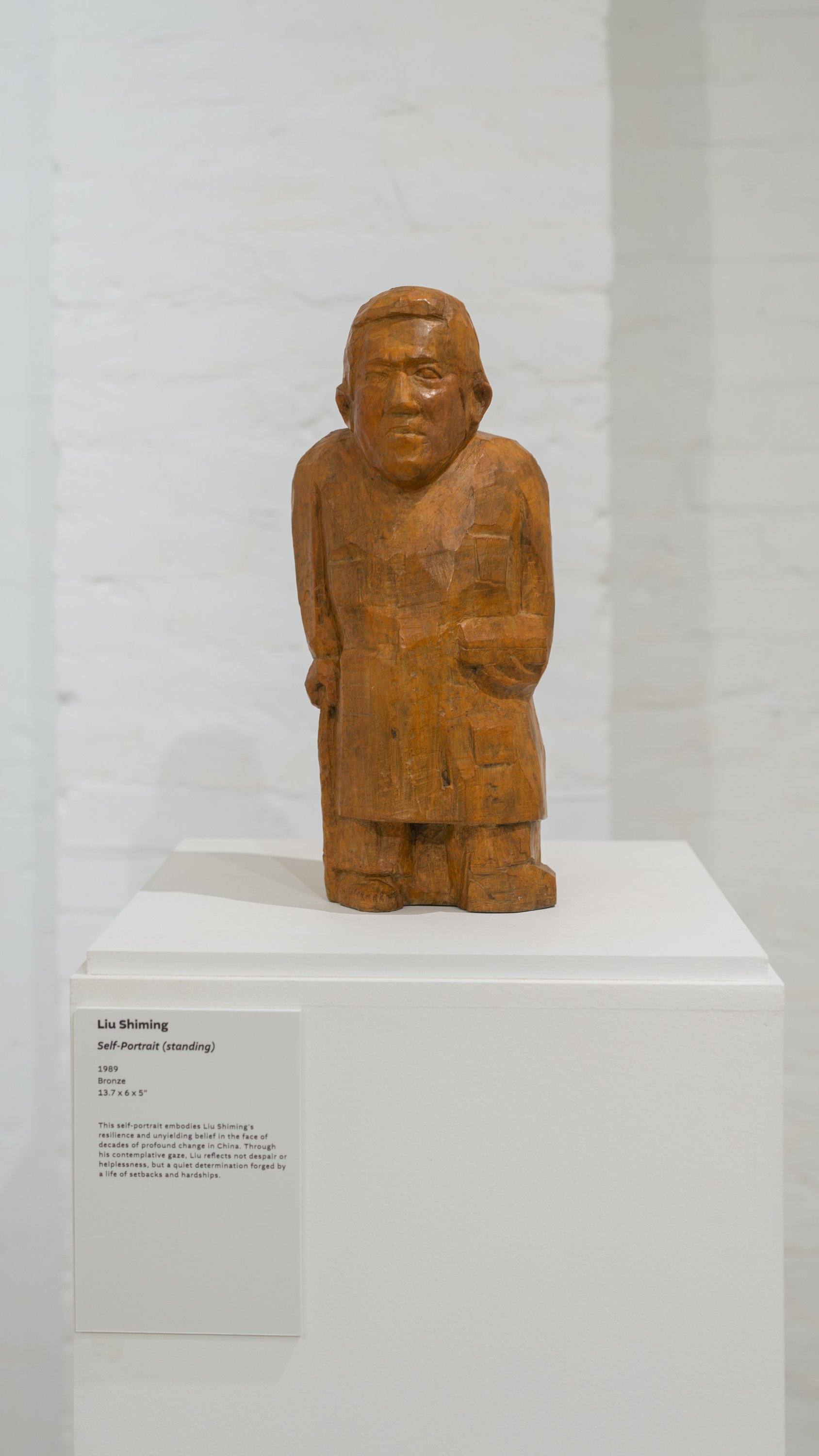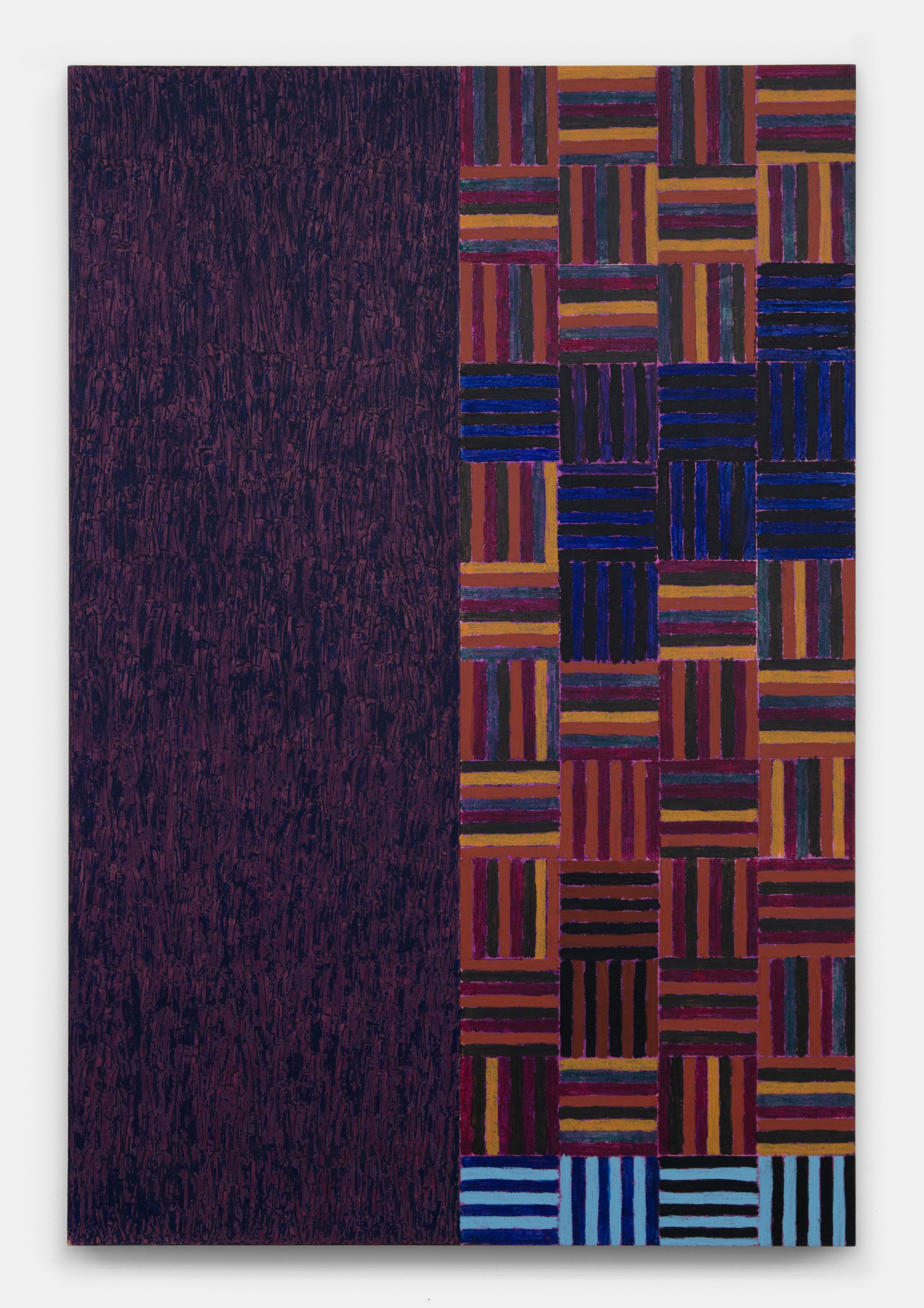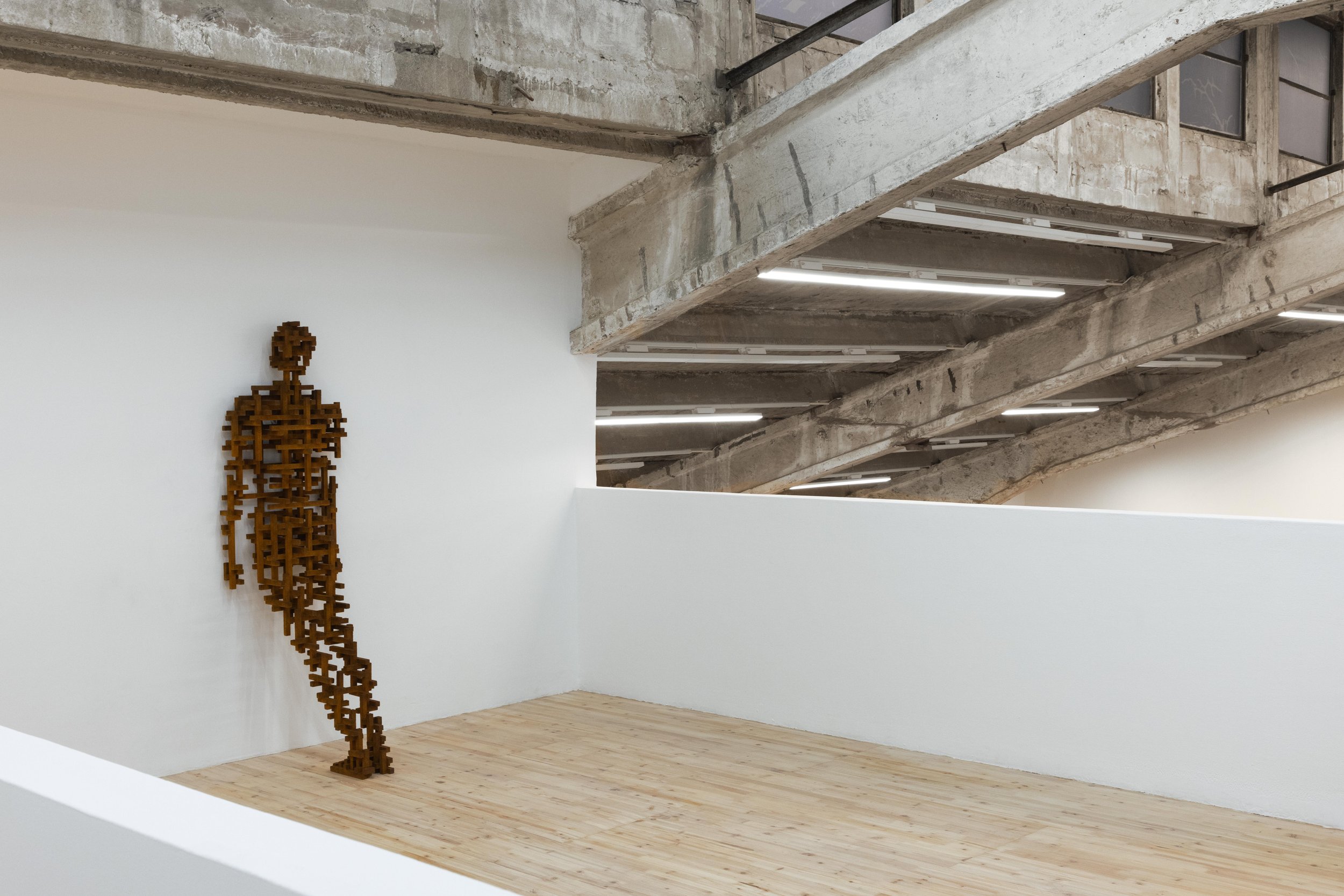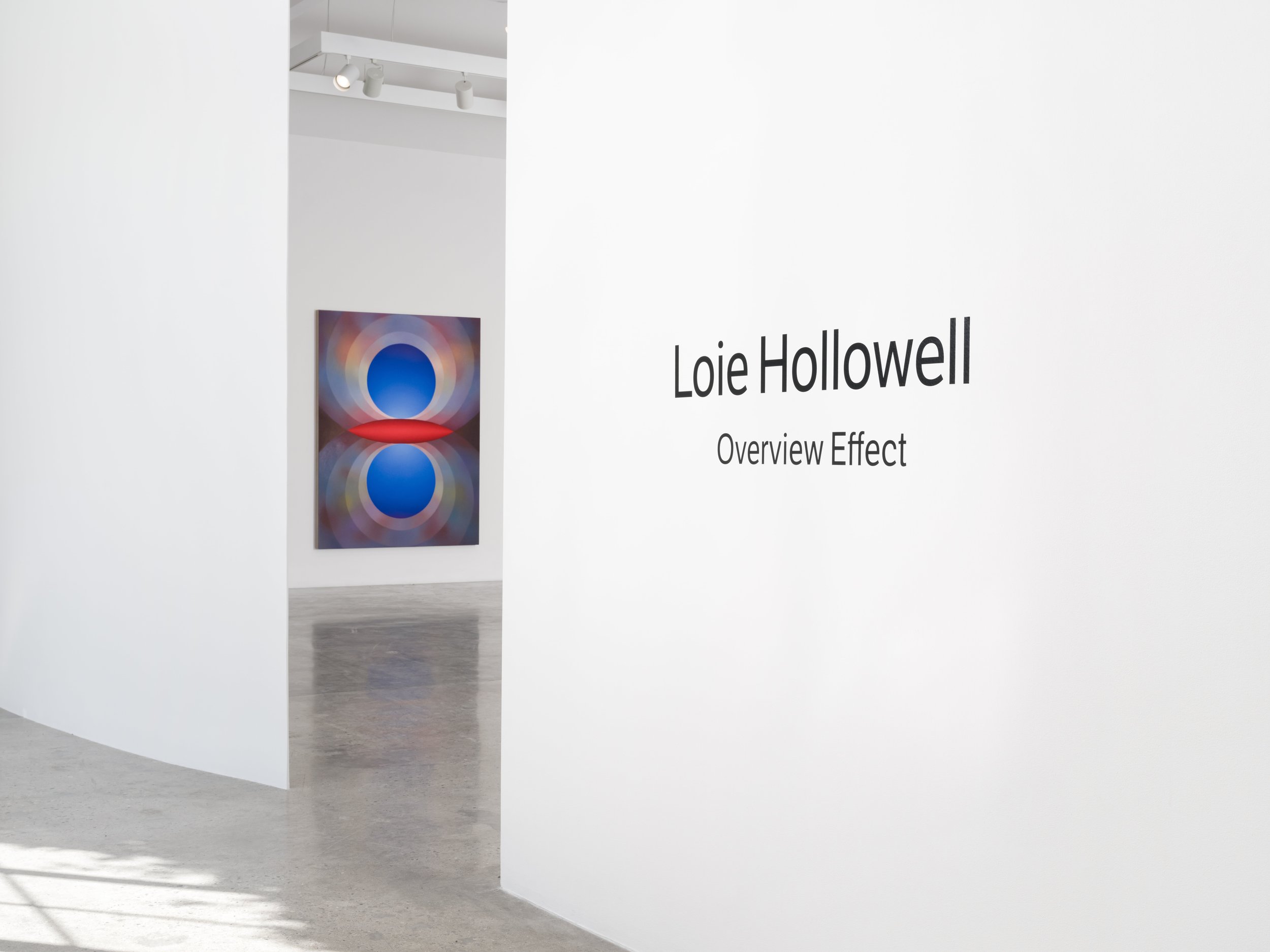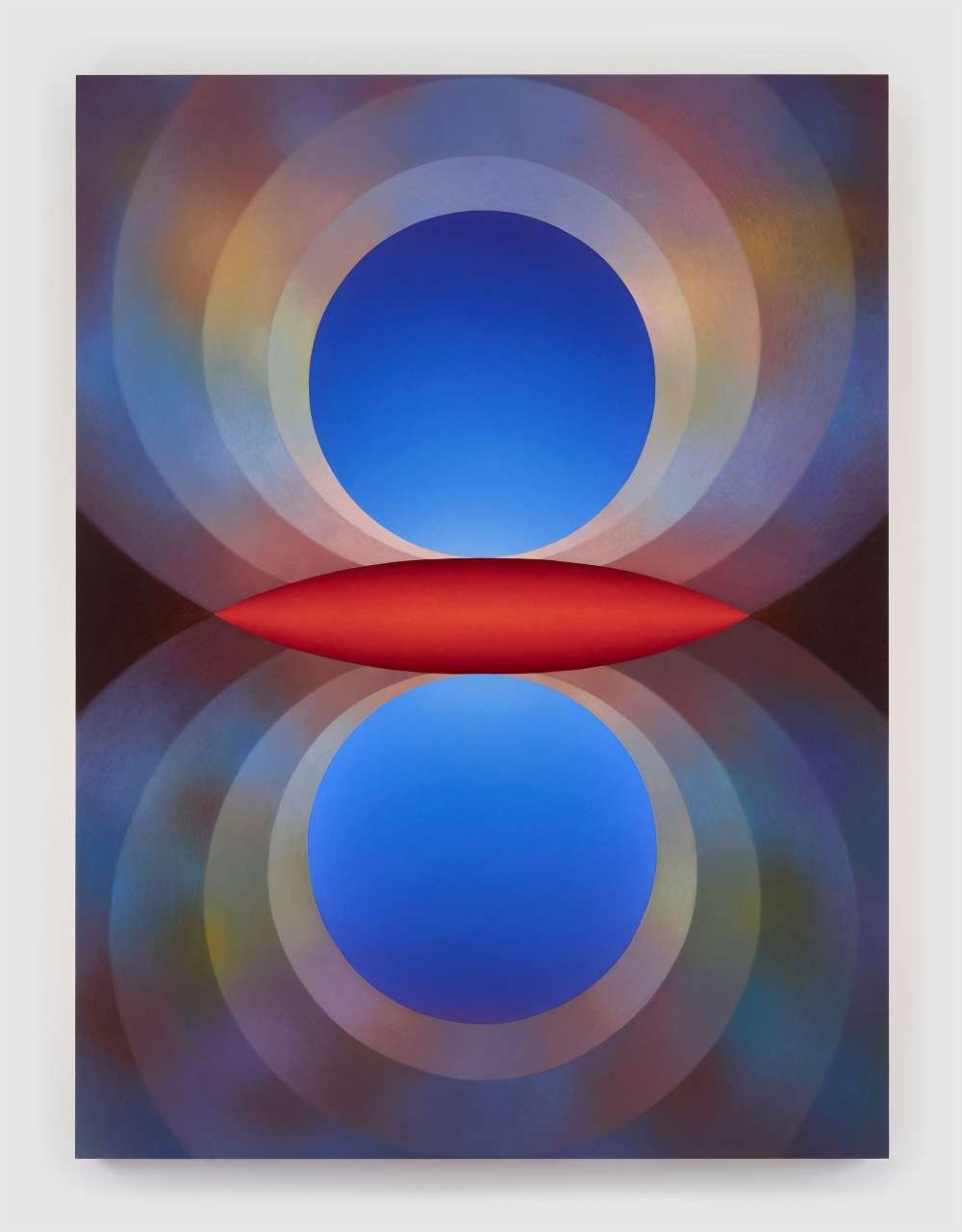Richard Misrach: CARGO
Richard Misrach, Cargo Ships (February 26, 2024 6:13 am), 2024 PIGMENT pigment print mounted on Dibond 60" × 80" (152.4 cm × 203.2 cm), image, paper, and mount 62-1/2" × 83" × 3" (158.8 cm × 210.8 cm × 7.6 cm), frame (approx.) signed, titled, dated and numbered verso in ink on label affixed verso on mount © Richard Misrach, courtesy Pace Gallery
New York – Pace is pleased to present an exhibition of recent photographs by Richard Misrach at its 540 West 25th Street gallery in New York. On view from January 17 to March 1, 2025, this will be the first presentation devoted to CARGO, a body of work that Misrach began in 2021 during the COVID-19 pandemic. During the last week of the show, advance copies of CARGO (Aperture, May 2025) will be available to view at the gallery. Pace hosted a talk between the artist and Sarah Meister, Executive Director of Aperture.
Richard Misrach, Cargo Ships (January 18, 2024 10:18 am), 2024 PIGMENT pigment print mounted on Dibond 60" × 80" (152.4 cm × 203.2 cm), image, paper, and mount 62-1/2" × 83" × 3" (158.8 cm × 210.8 cm × 7.6 cm), frame (approx.) signed, titled, dated and numbered verso in ink on label affixed verso on mount© Richard Misrach, courtesy Pace Gallery
Misrach is known for his poignant, large-scale color images that lean into social, political, and environmental issues while also engaging with the history of photography. In his radiant, contemplative works, Misrach—who is based in California—often examines the destructive impact of human interaction with the natural world. His works have examined man-made fires and floods, nuclear test sites, and animal burial pits in the American West; the petrochemical corridor in Louisiana; the landscape of the US-Mexico border; as well as more lyrical subjects like San Francisco’s iconic Golden Gate Bridge and his recent hydrofoil surfer series in Hawaii.
Richard Misrach: CARGO 540 West 25th Street, New York, NY 10001 January 17 – March 1, 2025 Photography courtesy Pace Gallery
Harkening back to his Golden Gate Bridge series—which the artist produced from his front porch over the course of four years beginning in 1997—CARGO centers on the light, water, and weather of the San Francisco Bay. He began creating this body of work in 2021 amid the pandemic and its attendant lockdowns. Captured at different times of day from a single location in San Francisco, these photographs speak to his enduring interest in bearing witness to the world around him from a singular vantage point over the course of months or years.
Richard Misrach Cargo Ships (December 16, 2023 9:11 am), 2023 pigment print mounted to Dibond 60" × 80" (152.4 cm × 203.2 cm), image, paper, and mount 62-1/2" × 82" × 3" (158.8 cm × 208.3 cm × 7.6 cm), frame Edition 3 of 5, Edition of 5 + 1 AP © Richard Misrach, courtesy Pace Gallery
In a statement, Misrach describes this series as a meditation on and celebration of the setting of the San Francisco Bay. With these works, he also contemplates the design, function, and history of the ships in the bay, and all of the thousands of workers implied in the images.
“Behind these ships, there is a remarkable—if invisible—global workforce that builds them, and inhabits them, that packs and unloads them, that maneuvers them over oceans and canals, sometimes in dangerous situations, toward their eventual berths,” Misrach writes. “Along with the extraordinary achievement and value these cargo ships symbolize, they also represent the complex, challenging side of our critical, intertwined, international commerce. In this historical moment, they allude to the threat that is global warming.”
Richard Misrach, Cargo Ships (January 13, 2022 5:25 pm), 2022 PIGMENT pigment print mounted on Dibond 60" × 80" (152.4 cm × 203.2 cm), image, paper, and mount 62-1/2" × 83" × 3" (158.8 cm × 210.8 cm × 7.6 cm), frame (approx.) signed, titled, dated and numbered verso in ink on label affixed verso on mount. © Richard Misrach, courtesy Pace Gallery
Richard Misrach (b. 1949, Los Angeles, California) is considered one of the most influential photographers of his generation, instrumental in pioneering the use of color photography and large-scale format in the 1970s. He graduated from the University of California, Berkeley, in 1971 with a BA in Psychology. For over 50 years, Misrach has photographed the dynamic landscape of the American West through an environmentally aware and politically astute lens. His visually seductive, large-scale color vistas powerfully document the devastating ecological effects of human intervention, industrial development, nuclear testing and petrochemical pollution on the natural world. His best known and ongoing epic series, Desert Cantos, comprises 40 distinct but related groups of pictures that explore the complex conjunction between mankind and nature. Otherworldly images of desert seas, rock formations, and clouds are juxtaposed with unsettling scenes of desert fires, nuclear test sites, and animal burial pits. Recent chapters capture the highly charged political climate following the 2016 US presidential election through photographs of spray-painted graffiti messages scrawled on abandoned buildings and remote rocky outcroppings in desolate areas of the Desert Southwest.
Other bodies of work include Golden Gate, a careful study of times of day, weather, and light around San Francisco’s famed bridge; On the Beach, aerial views of individuals and groups against a backdrop of water and sand; Notations, ravishing landscapes and seascapes in a reversed color spectrum; Destroy This Memory, a haunting document shot with a 4-megapixel pocket camera of graffiti found in the aftermath of Hurricane Katrina; and Petrochemical America, an in-depth examination of petrochemical pollution along the Mississippi River produced in collaboration with landscape architect Kate Orff.
Pace is a leading international art gallery representing some of the most influential contemporary artists and estates from the past century, holding decades-long relationships with Alexander Calder, Jean Dubuffet, Barbara Hepworth, Agnes Martin, Louise Nevelson, and Mark Rothko. Pace enjoys a unique U.S. heritage spanning East and West coasts through its early support of artists central to the Abstract Expressionist and Light and Space movements.
Since its founding by Arne Glimcher in 1960, Pace has developed a distinguished legacy as an artist-first gallery that mounts seminal historical and contemporary exhibitions. Under the current leadership of CEO Marc Glimcher, Pace continues to support its artists and share their visionary work with audiences worldwide by remaining at the forefront of innovation. Now in its seventh decade, the gallery advances its mission through a robust global program— comprising exhibitions, artist projects, public installations, institutional collaborations, performances, and interdisciplinary projects. Pace has a legacy in art bookmaking and has published over five hundred titles in close collaboration with artists, with a focus on original scholarship and on introducing new voices to the art historical canon.
Today, Pace has seven locations worldwide, including European footholds in London and Geneva as well as Berlin, where the gallery established an office in 2023. Pace maintains two galleries in New York—its headquarters at 540 West 25th Street, which welcomed almost 120,000 visitors and programmed 20 shows in its first six months, and an adjacent 8,000 sq. ft. exhibition space at 510 West 25th Street. Pace’s long and pioneering history in California includes a gallery in Palo Alto, which was open from 2016 to 2022. Pace’s engagement with Silicon Valley’s technology industry has had a lasting impact on the gallery at a global level, accelerating its initiatives connecting art and technology as well as its work with experiential artists. Pace consolidated its West Coast activity through its flagship in Los Angeles, which opened in 2022. Pace was one of the first international galleries to establish outposts in Asia, where it operates permanent gallery spaces in Hong Kong and Seoul, along with an office and viewing room in Beijing. In spring 2024, Pace will open its first gallery space in Japan in Tokyo’s new Azabudai Hills development.
The exhibition opened on January 17th and will be on view until March 1, 2025, at Pace Gallery 510 West 25th Street in New York. For more information about this exhibition and others, please visit the Pace Gallery’s website here. Pace Gallery can be found on Instagram and Artsy, too.
Jorge Macchi: False Autumn









Jorge Macchi False Autumn 2024 exhibition view Galleria Continua San Gimignano Courtesy: the artist and GALLERIA CONTINUA Photographer: Ela Bialkowska, OKNO Studio
GALLERIA CONTINUA, with great pleasure, hosted a new solo exhibition by Jorge Macchi titled “False Autumn.” The work of the Argentine artist is positioned precisely at the turning point between two opposites, in that grey area between the real form and the fictitious form of reality. In a world where art serves as a bridge between the tangible and the intangible, Macchi’s work testifies to the power of visual expression, chance, and the enduring influence of personal experiences. His art captures the ephemeral and the transient, inviting us to reflect on the fragile boundaries that define our existence. The exhibition opened on September 14 .2024, and concluded on January 26th, 2025. There was an opening reception on September the 14th.
Jorge Macchi False Autumn 2024 exhibition view Galleria Continua San Gimignano Courtesy: the artist and GALLERIA CONTINUA Photographer: Ela Bialkowska, OKNO Studio
The sculptures of various sizes, watercolors, oil paintings, and installations in this exhibition recreate the conditions for a new paradoxical reality that, through the assertion of artifice, upends our certainties and infiltrates the folds of consciousness. “Paradox is the suspension of meaning. It is one form of humor. It is one of Borges’ favorite tools. It is the word that defines much of what I do. The archer and the arrow, Zeno of Elea’s aporia, the scene where an arrow aimed at a target never reaches it because the distance between them is infinitely divisible, it is a paradox that has been with me forever” says the artist.
“False Autumn” is the work that gives its name to the exhibition by Macchi in San Gimignano. In one corner of the gallery, over a thousand leaves are scattered across the floor. As the title (“False Autumn”) suggests, these are not real autumn leaves: they are not yellow or red but green. Each one has a unique shape resembling a puzzle piece. A closer look reveals that these puzzle pieces are made from real leaves, each carefully cut out. This process disrupts the usual harmony between the natural shape of a leaf and its veins, prompting the observer to wonder what possible image could emerge from assembling all the puzzle pieces. Furthermore, ‘false autumn’ is also a term that was coined this summer to describe a phenomenon affecting various parts of Great Britain and many European countries, including Italy: due to severe drought and intense heatwaves, nature has gone into survival mode, bringing forward the autumn foliage by several months. Reddened, dry leaves on the ground, branches already almost bare, and increasingly arid soil have characterized numerous forest landscapes, raising widespread concern.
Jorge Macchi A perfect dream 2024 cotton fabric 150 x 200 cm / 59.05 x 78.74 in 2024 tessuto di cotone 150 x 200 cm Courtesy: the artist and GALLERIA CONTINUA
Jorge Macchi’s work creates powerful visual fictions; his pieces are artifacts that explore the functioning of vision and perception. “Rorschach #1” and “Rorschach #2” are site- specific murals painted in the corners of a room in the gallery. They immediately evoke the symmetrical images of Hermann Rorschach’s famous psychodiagnostic test. However, the figures Macchi creates on the wall are not the result of a mere overlay; there is no actual transfer of form and color from one side to another. Instead, the artist makes these images using two symmetrical paper stencils. What remains is the suggestion of a sheet, walls that seem like folded papers, leaving us with the unsettling feeling that the stable and enduring walls of the building could suddenly bend and change their structure. The play between reality and artifice reappears in “Dos banderas” where one element of the diptych consists of four sheets from the same notepad, while the other is made of sheets from different pads. The ribbon, which seems to hold the sheets together, is painted with watercolor and tempera. In “Déjà vu” Macchi intervenes with a restoration and polishing operation on half of a table that has been exposed to the sun and elements for two years. The final assembly is two parts the one exposed outdoors and the one preserved in the studio creating a fictitious and artificial unity. “Confesión” is a cardboard box from a 50-inch Smart TV with all sides carved into a repeated cross pattern, resembling the perforated metal of confessionals. The box no longer contains any object; the perforation has transformed it into a visual tool that offers a fragmented view of its interior and what lies behind it.
Between 1864 and 1933, thousands of glass bottles were thrown into the sea, each containing a document that recorded the exact time and place where the bottle was released into the ocean. This was an experiment to study surface marine currents. In Jorge Macchi’s series “Drift Bottles” the bottles are made of plastic, similar to those widely used by major distributors for mineral water and various beverages. Instead of a message, the artist places a miniature sailing ship, specially crafted by an artisan in Buenos Aires. Macchi’s bottles stimulate our imagination, evoking striking images: the messages in bottles - romantic, scientific, or playful - that have traversed seas and history over time; the world enclosed in a plastic bubble; the hands of an artisan crafting precious objects; and the growing plastic islands in our planet’s oceans.
About the artist:
Jorge Macchi was born in Buenos Aires in 1963, where he lives and works. He won the John Simon Guggenheim Memorial Foundation Fellowship in 2001 and has exhibited at numerous international institutions. Notable solo exhibitions include: Diaspora, Galleria Continua, San Gimignano (2022); The Submerged Cathedral, Musée Cantonal des Beaux-Arts, Lausanne, Switzerland (2020); Portal, Galleria Continua Habana, Cuba (2019); Der Zauberberg, Quartz Studio, Turin (2018); Perspectiva, MALBA, Museo de Arte Latinoamericano Buenos Aires (2016) and CA2M, Centro de Arte 2 de Mayo, Madrid (2017); Lampo, NC ARTE, Bogotá (2015); Prestidigitador, Contemporary Art Universi-ty Museum (MUAC), Mexico (2014); Container, Kunstmuseum Lucerne, Switzerland (2013); Music Stand Still, SMAK, Ghent, Belgium (2011). In 2005, Macchi represented Argentina at the 51st Venice Biennale. His works are included in major international collections such as the Tate Modern (London), MoMA (New York), MUSAC, Museo de Arte Contemporáneo (León), CGAC, Centro Galego de Arte Contemporáneo (Santiago de Compostela), Fundación Arco (Spain), MUHKA (Antwerp), SMAK (Ghent), MAMAC Musée d’Art Moderne et d’Art Contemporain (Nice), and Fundación Banco de la Nación Argentina (Buenos Aires).
About the gallery :
Founded in 1990 in San Gimignano, Italy, GALLERIA CONTINUA has expanded its locations to Beijing, Les Moulins, Havana, São Paulo, Rome, Paris and Dubai.
GALLERIA CONTINUA represents a desire for continuity between times and a desire to write a current history. Thanks to its investment in forgotten and unconventional sites, the gallery has always chosen unexpected locations, developing a strong identity and an original positioning in over thirty years of activity. The home of Galleria Continua, an ex-cinema, it has hosted many prolific exhibitions and installations over the last 34 years. It is a unique and exciting space for artists and the gallery to have to consider when planning and executing exhibitions.
GALLERIA CONTINUA / San Gimignano
Via del Castello 11, 53037 San Gimignano (SI)
+39 0577 943134 | sangimignano@
From Monday to Sunday: 10 AM–1 PM | 2 PM–7 PM;
Starting from 03.11, from Monday to Sunday:
10 AM–1 PM | 2 PM–6 PM
For more information about this exhibition and others at Galleria Continua please visit their site here. Galleria Continua can also be found on Instagram, Facebook, TikTok, YouTube, and Artsy.
BORIS MIKHAILOV: Refracted Times
Installation view, “Refracted Time,” Marian Goodman Gallery, New York, 2025 Courtesy of the artist and Marian Goodman Gallery Photo credit: Alex Yudzon
Marian Goodman Gallery is very pleased to announce the exhibition of works by the acclaimed Ukrainian photographer Boris Mikhailov which opened on 10 January and will be on view through 22 February 2025.
Known for his groundbreaking photographic practice which combines his interest in cinema, documentary, per- performance, and writing, Mikhailov has been an inventive, tender but uncompromising witness to the changing fate of his native Ukraine and the consequent experiences of war and displacement. The exhibition explores his rethinking and reworking of the photographic image by including two video works – one from the late ‘60s-‘70s, Yesterday’s Sandwich, and the most recent, Our Time is Our Burden, 2024 – as well as showcasing three iconic photographic series from the ‘80s and ‘90s. One of the most acclaimed photographers of the former USSR, he represented Ukraine at the Venice Biennale in 2007, and debuted his work in the United States with a solo presentation at MoMA in 2011.




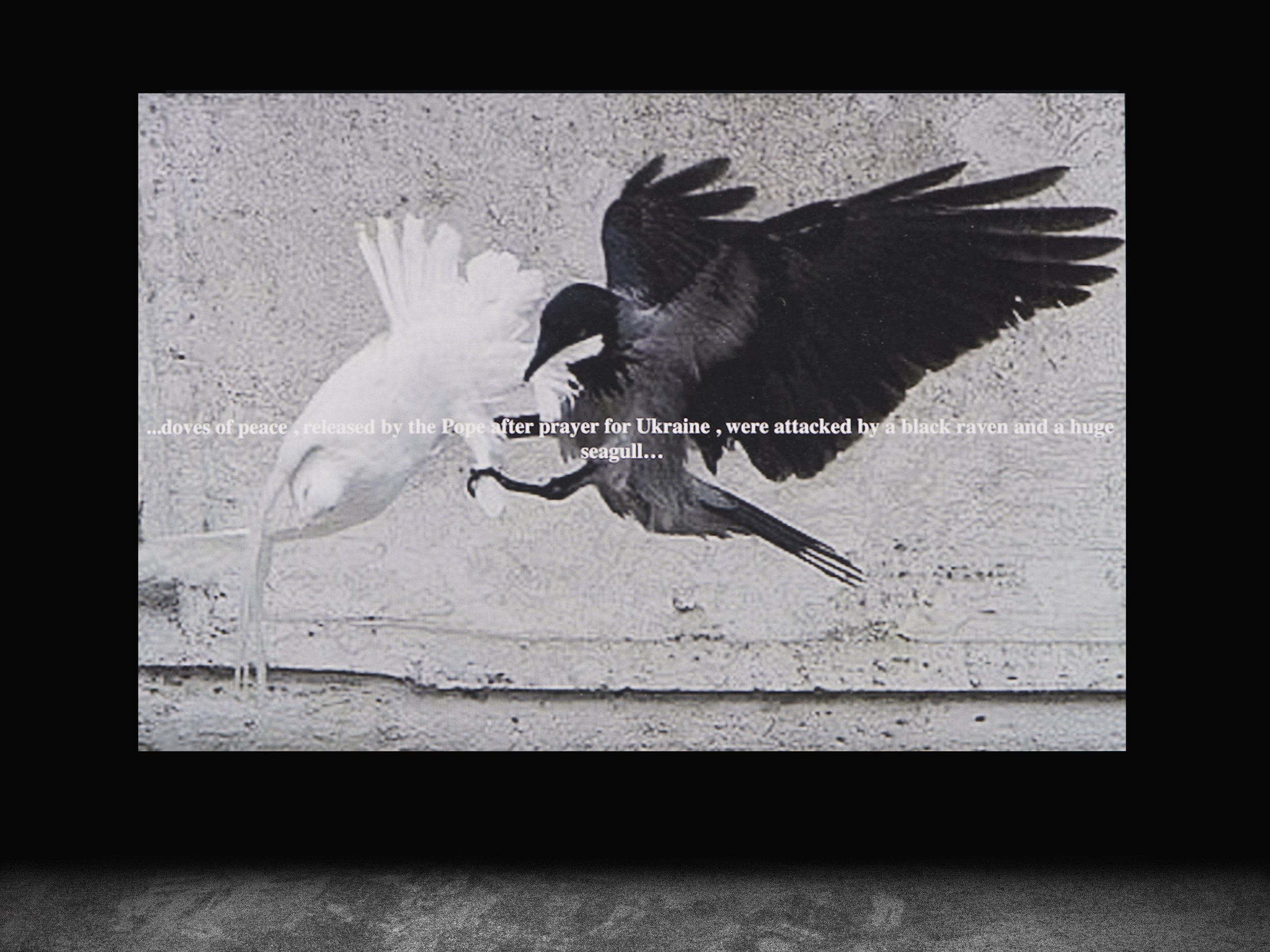
Our Time is Our Burden, 2024 (Video still) Video, color, silent; 8 min. 28 sec. Installation view, “Refracted Time,”Marian Goodman Gallery, 2025
Courtesy of the artist and Marian Goodman Gallery Photo credit: Alex Yudzon
Mikhailov was born in 1938 in Kharkhiv, Ukraine, and has spent his life living between Kharkhiv and Berlin. Educated as an engineer, he encountered photography as an art form quite by chance. Through his raw pictures which offer an unequivocal critique of everyday life, he has represented the collective unconscious of Ukraine for over five decades. His embrace of social truths often involves the incorporation of deliberate accidents in his image construction to allow the abject to surface. His work is known also for specific aesthetic innovations, such as hand coloration as part of his conceptual practice, and the superimposition of images as a metaphor for the duality of Soviet life, as first seen in Yesterday’s Sandwich (1960s-70s).
Alongside the videos, three seminal sets of photographs will be presented, taken between 1986-1993, which reflect on the changing conditions and inevitable contradictions of Ukrainian life. Operating in a society in which pre- scribed portrayals of idealized Soviet life were part of the era, these pictures represent the complex scrutiny, irony, and dissent that Mikhailov brought to his work. From the mid eighties, operating behind the ideological façade of the times, just as ‘glasnost’ was on the horizon, to the social upheavals that followed the downfall of the Soviet Union in 1991, he seeks to represent everyday humanity, questioning legacies of heroic identity.
Boris Mikhailov At Dusk, 1993 Chromogenic Print 19 3/4 x 43 1/4 in. (50 x 110 cm) Courtesy of the artist and Marian Goodman Gallery Photo credit: Alex Yudzon
The earliest of the series on view is a set of black & white works, Salt Lake, 1986, in which we see bathers around a body of water in Southern Ukraine, recalling as Mikhailov says, ‘times gone by post-revolution, where seemingly, like in the 1920’s and 1930’s people bathed naked, believing in the healing properties of waters.’ This everyday portrayal of a lakeside idyll, with people mingling and socializing in regenerative spirit, actually depict the ‘underside of a proselytized utopia’ taking place against an industrial landscape with a factory looming in the distance, that was known to pollute the waters with waste. “It seemed to be the quintessence of the life of an average person in the Soviet context; despite the atrocious, polluted, humane environment, the people were relaxed, calm and happy … families, old men, and women lying down like odalisques or Greek statues.”
Installation view, “Refracted Time,” Marian Goodman Gallery, New York, 2025 Courtesy of the artist and Marian Goodman Gallery Photo credit: Alex Yudzon
By the Ground, 1991, a series made five years later, was created the same year as the fall of the Soviet Union. Through a horizon camera that featured a panoramic point of view on his subjects in a novel sepia tone, a destitute reality emerged, reflecting life of the people at ‘ground level.’ Shot from hip height, solitary figures are captured against an urban landscape, leaving the easy idyll behind. Having depicted subjects in a purposefully nostalgic manner through sepia tones, Mikhailov writes of these images: “Things were beginning to fall apart, the country was breaking up. This was life beyond the collapse. This series begins with a photo of a man lying on the ground… Suddenly I thought of Maxim Gorky’s play “The Lower Depths,” and this inspired the title of the series.”
Boris Mikhailov Salt Lake, 1986 Photograph Frame: 30 1/4 x 41 1/4 x 1 1/4 in. (76.8 x 104.8 x 3.2 cm) Mat window: 21 1/2 x 32 1/2 in. (54.6 x 82.5 cm)
Courtesy of the artist and Marian Goodman Gallery Photo credit: Alex Yudzon
Two years later, Mikhailov continued his experiment with color, returning to the street with his series At Dusk, 1993. Evoking memory and war, At Dusk continues to document a worsening condition in Ukraine, following independence and collapse of the USSR. Using a horizon panoramic camera again, the images are hand-colored cobalt blue, recalling a complex beauty but also the foreboding of the night sky, which Mikhailov remembers having fled as a young boy from ‘sirens, searchlights, and bombs’ in 1941 Kharkhiv, during the advance of World War II. Mikhailov writes, “Blue for me is the color of the blockade, hunger and war.”
In his documentation of Soviet life, there’s an underlying tone of dark humor, which serves a means to subvert the status quo, and as commentary to denote the failure of the prevailing systems of communism and capitalism. The narrative that he captures is in stark contrast to the reality and expectation from society and its government, then and especially now, in light of current events.
Boris Mikhailov Salt Lake, 1986 Photograph Frame: 30 1/4 x 41 1/4 x 1 1/4 in. (76.8 x 104.8 x 3.2 cm) Mat window: 21 1/2 x 32 1/2 in. (54.6 x 82.5 cm)
Courtesy of the artist and Marian Goodman Gallery Photo credit: Alex Yudzon
In 1971, Mikhailov co-founded the Vremya group, an underground art collective exploring experimental forms of photographic techniques and methods, which later formed the basis of the Kharkiv School of Photography. He was the head of the photography department of Panorama, the Ukrainian Union of Experimental Photography, from 1987 until 1991. His work was included in the Carnegie International in 1991; and his series By the Ground was included in a show of New Photography that same year at MoMA in 1993. In 1993, he spent a year in Berlin, sponsored by the German Academic Exchange Organisation (DAAD). He was a visiting professor at Harvard University in 2000 and a professor at the Leipzig Academy in 2002-2003.
Mikhailov has received many prestigious awards, including the Coutts Contemporary Art Award (1996), the Al- bert Renger-Patzsch Prize (1997), the Goslarer Kaiserring Award (2015), the Hasselblad Foundation International Award in Photography (2000), the Deutsche Börse Photography Foundation Prize (2001). In 2000, his book “Case History” won the prize for best photography book at the Rencontres Internationales de la Photographie in Arles, France, and the Kraszna Krausz Book Award in London. In 2021, his slideshow installation Temptation of Death (2017-2019) was awarded the Shevchenko National Prize, the first official recognition of Mikhailov’s work in Ukraine.
Boris Mikhailov By the Ground, 1991 Gelatin silver print, photomontage, toned Mat: 8 1/4 x 26 in. (21 x 66 cm) Sheet: 7 3/4 x 11 3/4 in. (19.7 x 29.8 cm) [each] Courtesy of the artist and Marian Goodman Gallery Photo credit: Alex Yudzon
Mikhailov’s work has been shown in numerous solo exhibitions at such institutions as the Ukrainian Pavilion\ at Venice Biennale (2007 and 2017), Tate Modern, London (2010), MoMA, New York (2011), Berlinische Galerie (2012), Sprengel Museum, Hannover (2013), PinchukArtCentre, Kyiv (2019), Staatliche Kunsthalle, Baden- Baden (2020), Maison Européenne de la Photographie, Paris (2022), Palazzo Esposizioni, Rome (2023), and Fotomuseum Den Haag, The Hague (2024), and the Royal Danish Library, Copenhagen (2024).
Marian Goodman Gallery champions the work of artists who stand among the most influential of our time and represents over five generations of diverse thought and practice. The Gallery’s exhibition program, characterized by its caliber and rigor, provides international platforms for its artists to showcase their work, foster vital dialogues with new audiences, and advance their practices within nonprofit and institutional realms. Established in New York City in 1977, Marian Goodman Gallery gained prominence early in its trajectory for introducing the work of seminal European artists to American audiences. Today, through its exhibition spaces in New York, Los Angeles, and Paris, the Gallery maintains its global focus, representing some 50 artists working in the U.S. and internationally.
This exhibition had an opening reception on the tenth of January that was held from six to eight pm. The exhibition will end on the 22nd of February at the Marian Goodman’s location in Paris at 79 & 66 rue du Temple, 75003. For more information about the exhibit, please visit the Marian Goodman Gallery’s site. The gallery can be found on Instagram and Artsy, too.
Beijing Stories: Sculptures by Liu Shiming and Photographs by Lois Conner
Exhibition Views, Beijing Stories: Sculptures by Liu Shiming and Photographs by Lois Conner Liu Shiming Art Gallery, New York, 2025 Copyright Lois Conner, Liu Shiming, Courtesy the artist and Liu Shiming Art Gallery
The Liu Shiming Art Gallery is pleased to announce Beijing Stories: Sculptures by Liu Shiming and Photographs by Lois Conner, the exhibition opened on January 16 and will be on view through March 21, 2025. This exhibition brings together two unique perspectives on Beijing, pairing of Liu Shiming’s evocative sculptures with of Lois Conner’s panoramic photographs. Together, their works offer a compelling narrative of a city in transition, reflecting its resilience, evolution, and the enduring spirit of its people.
Liu Shiming’s sculptures, created primarily from the 1980s until his passing in 2010, chronicle Beijing’s transformation from the early years of New China to the 2008 Olympics. His works capture the city's journey from post-revolution challenges to economic reform and rapid development, portraying the lives of ordinary people navigating these changes. Liu’s art highlights the resilience of rural communities adapting to urban life while striving to preserve their traditions as Beijing grew into China’s political and cultural center. His sculptures convey a sense of hope, particularly those depicting the younger generation, which he created after his family settled in Beijing.
Liu Shiming Cutting Through Mountains to Bring in Water, 1958 Bronze 34 x 37.5 x 18
Lois Conner, who has visited China almost annually since 1984, offers an external yet deeply personal perspective through her panoramic photographs. Using a large-format 7” x 17” banquet camera, she captures Beijing’s landscapes and intimate moments with extraordinary clarity and detail. This exhibition features her images of Beijing’s evolving cityscape from the 1980s to today, spanning iconic landmarks such as the 18th-century Summer Palace to contemporary millennial architecture. Conner’s work explores the delicate balance between modernity and tradition, offering a rich visual narrative of the city’s history and cultural transformation.
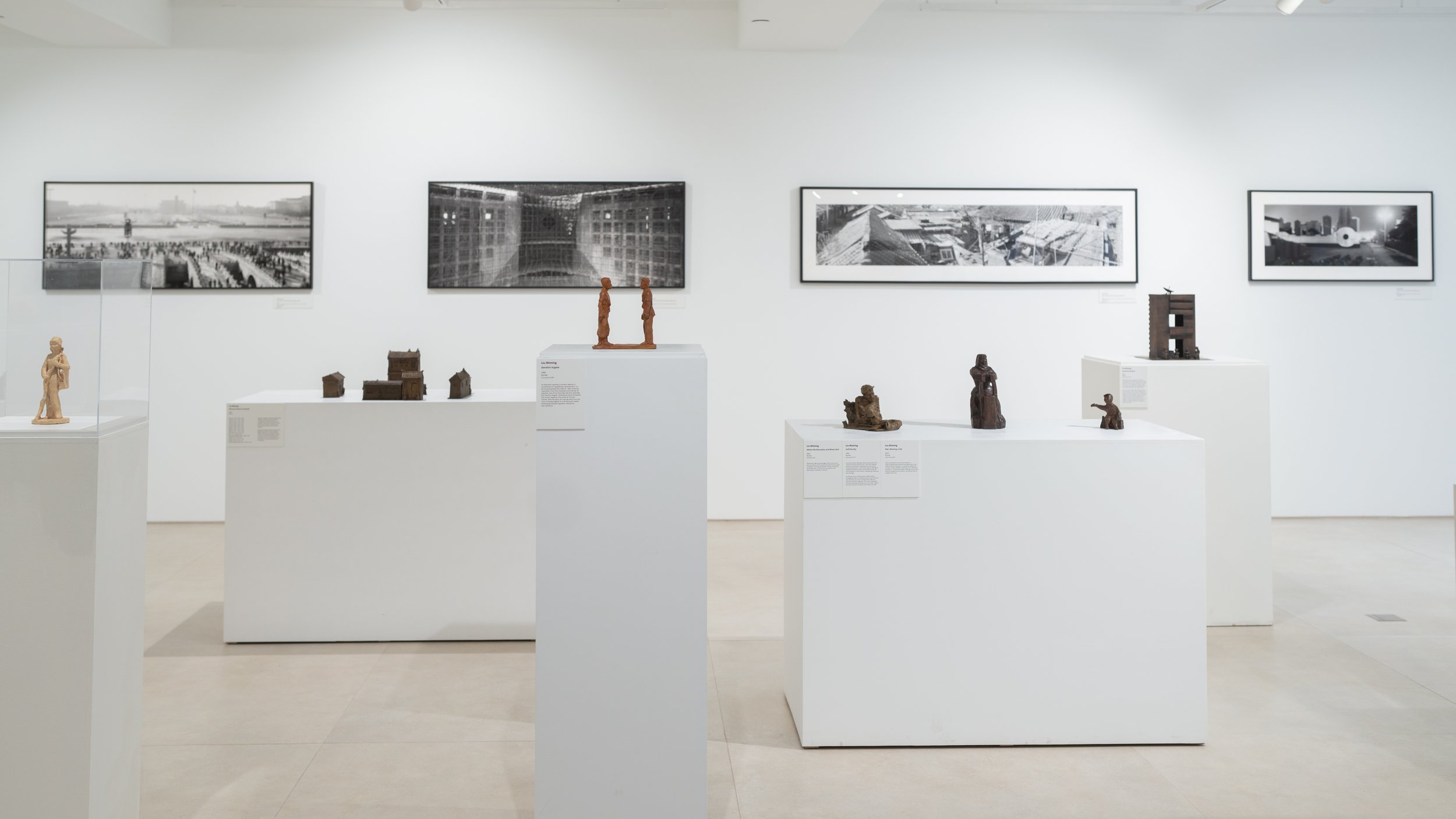
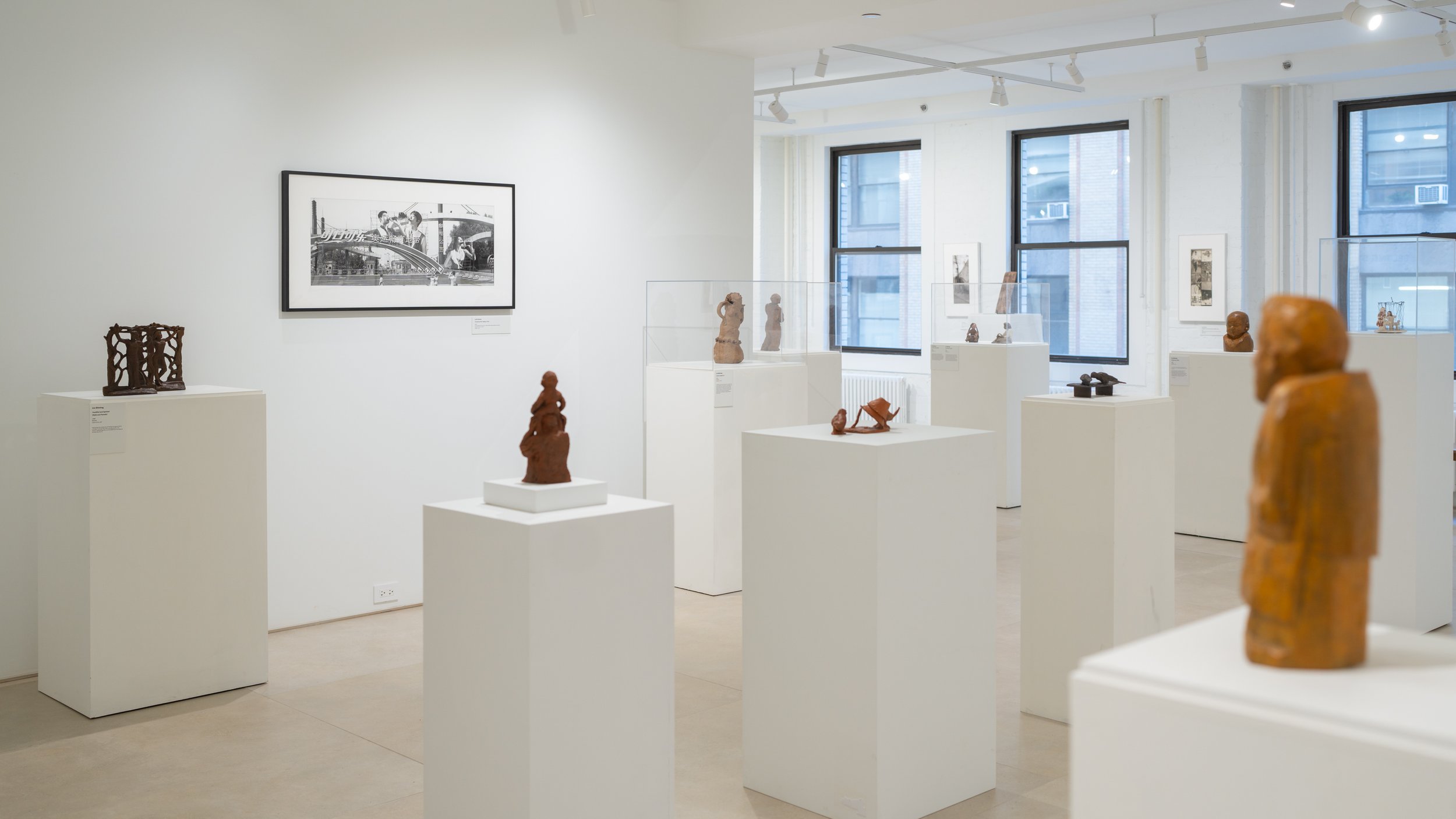
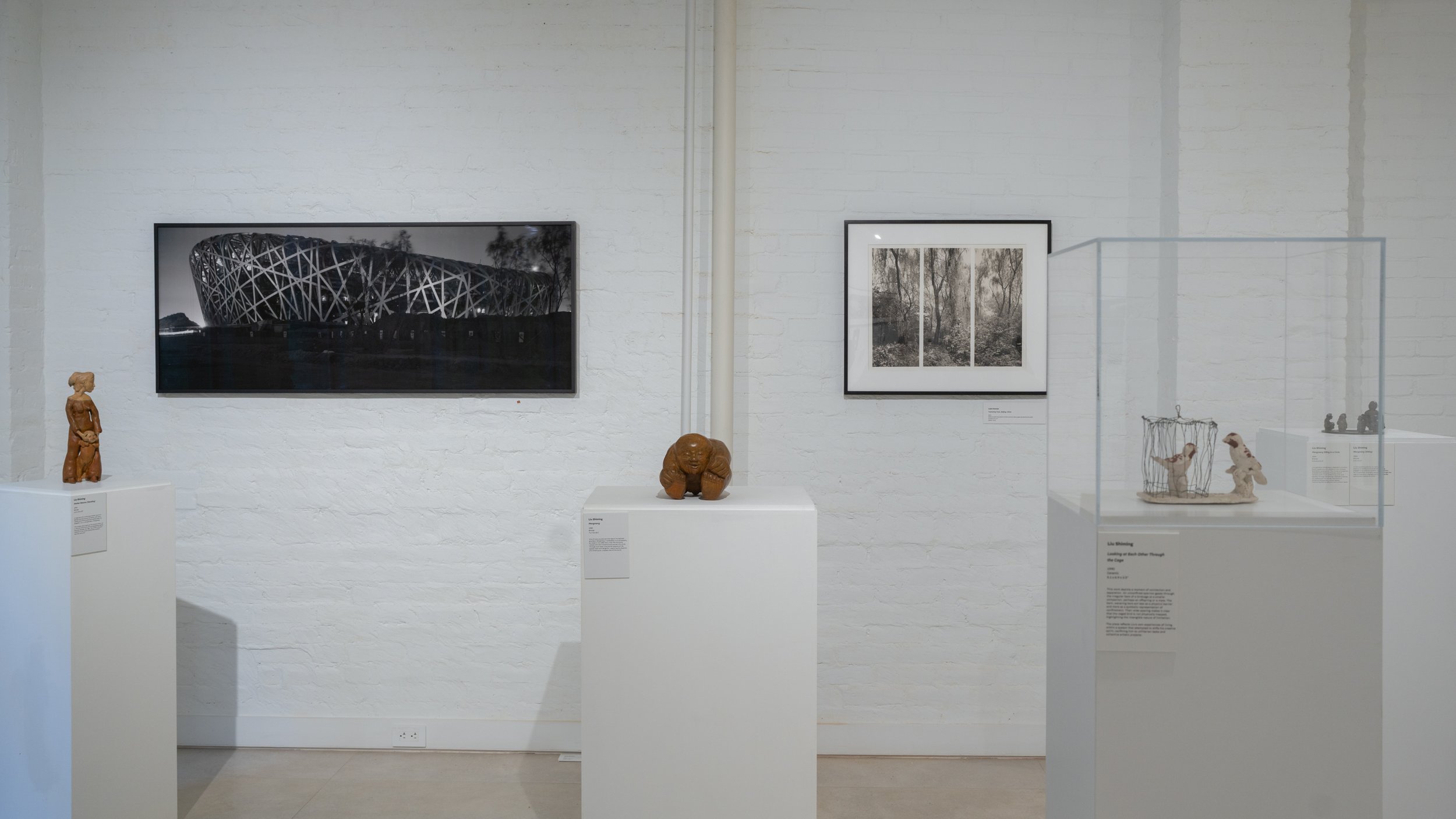
Exhibition Views, Beijing Stories: Sculptures by Liu Shiming and Photographs by Lois Conner Liu Shiming Art Gallery, New York, 2025 Copyright Lois Conner, Liu Shiming, Courtesy the artist and Liu Shiming Art Gallery
Together, Liu’s sculptures and Conner’s photographs present a multifaceted exploration of Beijing’s past and present, inviting audiences to experience the city’s dynamic spirit through their artistic lenses.
About Liu Shiming Art Gallery
Located in the center of Manhattan, just steps from the 42nd Street New York Public Library, the Liu Shiming Art Gallery is dedicated to showcasing the works of renowned sculptor Liu Shiming. Through solo exhibitions and curated group shows, the gallery highlights Liu’s sculptures and drawings alongside works by artists who share or draw inspiration from similar artistic traditions. Beyond exhibitions, the gallery serves as a space for cultural and artistic programs, hosting events that foster dialogue and engagement with diverse creative communities.
About Liu Shiming
Liu Shiming (1926–2010) was a pioneering Chinese sculptor whose work bridged traditional Chinese art and modernist influences. A graduate of the Central Academy of Fine Arts (CAFA) in Beijing, he was among the first generation of sculptors trained in the People’s Republic of China. Liu’s early works, including Measuring Land (1950), gained national and international recognition, but he later chose to live and work in rural China, drawing inspiration from local traditions and daily life to develop his signature humanist style.
Working primarily in ceramics, Liu Shiming created sculptures that reflect a deep connection to his cultural heritage and a sensitivity to human experience. His works have been exhibited internationally, including in United States, and Canada, and China. In 2018, CAFA established the Liu Shiming Sculpture Museum, and in 2024, the Liu Shiming Art Gallery opened in Manhattan to celebrate his legacy.
About Lois Conner
Lois Conner is a New York-based photographer renowned for her panoramic “portraits” of landscapes and urban environments, particularly her decades-long documentation of Beijing. Using a large-format 7” x 17” banquet camera, she captures sweeping vistas and intricate details, offering a nuanced perspective on the city’s transformation since her first visit in 1984 during a Guggenheim Fellowship. Conner’s work juxtaposes Beijing’s rapid modernization with its enduring cultural heritage, creating a dialogue between the past and present. Her photographs are featured in prominent collections, including the Metropolitan Museum of Art and the British Museum, showcasing her ability to reveal the profound beauty and complexity of her subjects.
For more information about this exhibition and the foundation, please visit the site here. The gallery and foundation can also be found on Instagram and Facebook.
JAMES WELLING: Thought objects, Italy and France
Exhibition Views, James Welling: Thought Objects, Italy and France, Galerie Marian Goodman, Paris, 2025 Copyright James Welling Courtesy the artist and Marian Goodman Gallery Photo credit: Rebecca Fanuele
Marian Goodman Gallery is pleased to present the third exhibition of work by James Welling in Paris. An artist widely acclaimed for his unclassifiable approach to photography, Welling has worked with the materiality of the medium since 1975. After using a wide array of analog photographic processes, Welling turned to digital technologies in 1998. His Thought Objects, 2023-24, whose title is borrowed from Barbara Ess and Glenn Branca’s anthology of photographs published in 1987, embodies his evolving quest for discovery. New Thought Objects photographs made recently in Italy are presented at 79 rue du Temple, and at 66 rue du Temple, three Thought Objects from 2023 are hung with his 2009 series devoted to the Maison de verre, an iconic glass and steel domestic building built by architect Pierre Chareau in Paris in the late 1920s.
JAMES WELLING Artichoke, Rome, 2024 UV – curable ink on Dibond alumin 28 x 42 x 1 5/8 in. (71.1 x 106.8 x 4.1 cm) Edition of 5 plus 2 artist’s proofs Copyright James Welling Courtesy the artist and Marian Goodman Gallery
On the ground floor of the gallery, Welling’s new photographs, made in the spring of 2024 during a month-long residency at the American Academy in Rome, encompass a myriad of themes. The images deliberately elude classification or typology and recall his Light Sources series (1992-2001) where Welling explored several subjects. Detailed or partial views of recognizable buildings, such as the MAXXI Museum, the Church of Sant’Agnese in Agone, Rome, or the arcades of the Pinacoteca di Brera, Milan, accentuate uncommon attributes within the architecture. The mathematical order of the tessellated paving stones in the Piazza Navona, or the Fibonacci spirals found in photographs of artichoke and zucchini flowers provide a visual analogue to the underlying mathematical basis of digital photography, or photo numérique, numerical photographs.
JAMES WELLING Arches, Milan, 2024 UV – curable ink on Dibond alumin 42 x 63 3/8 x 1 7/8 in. (106.6 x 161 x 4.8 cm) Edition of 5 plus 2 artist’s proofs Copyright James Welling Courtesy the artist and Marian Goodman Gallery
As Welling explains: “To my mind, Thought Objects are images whose meanings detach from the photograph’s nominal subject to suggest multiple readings.” The massive wooden door of Michelangelo's studio for example, can alternate from being either an ordinary entryway or a pulsating network of colorful afterimages hovering at the doors of perception. In Thought Objects Welling uses a digital variation of 70’s “equidensity processing” that had its origin in analog photography. Similar to solarization or posterization, this process consists of combining positive and negative images to change the visual texture and color of the image. Thought Objects are UV prints, an innovative digital printing process that affixes pigment permanently to thin aluminum panels. These panels are hung using an “frame” designed by the artist that creates the effect of the work floating off the wall.
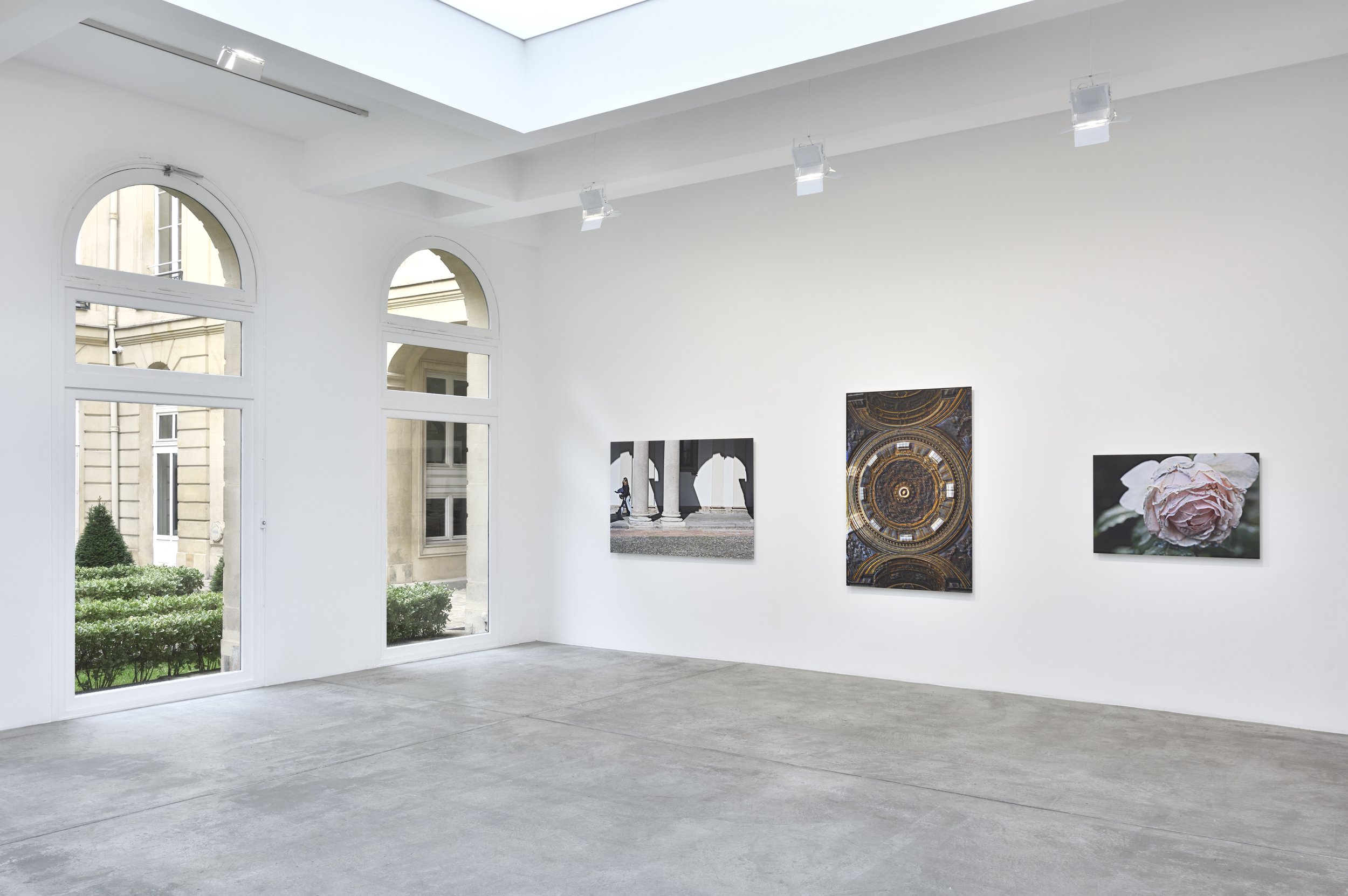
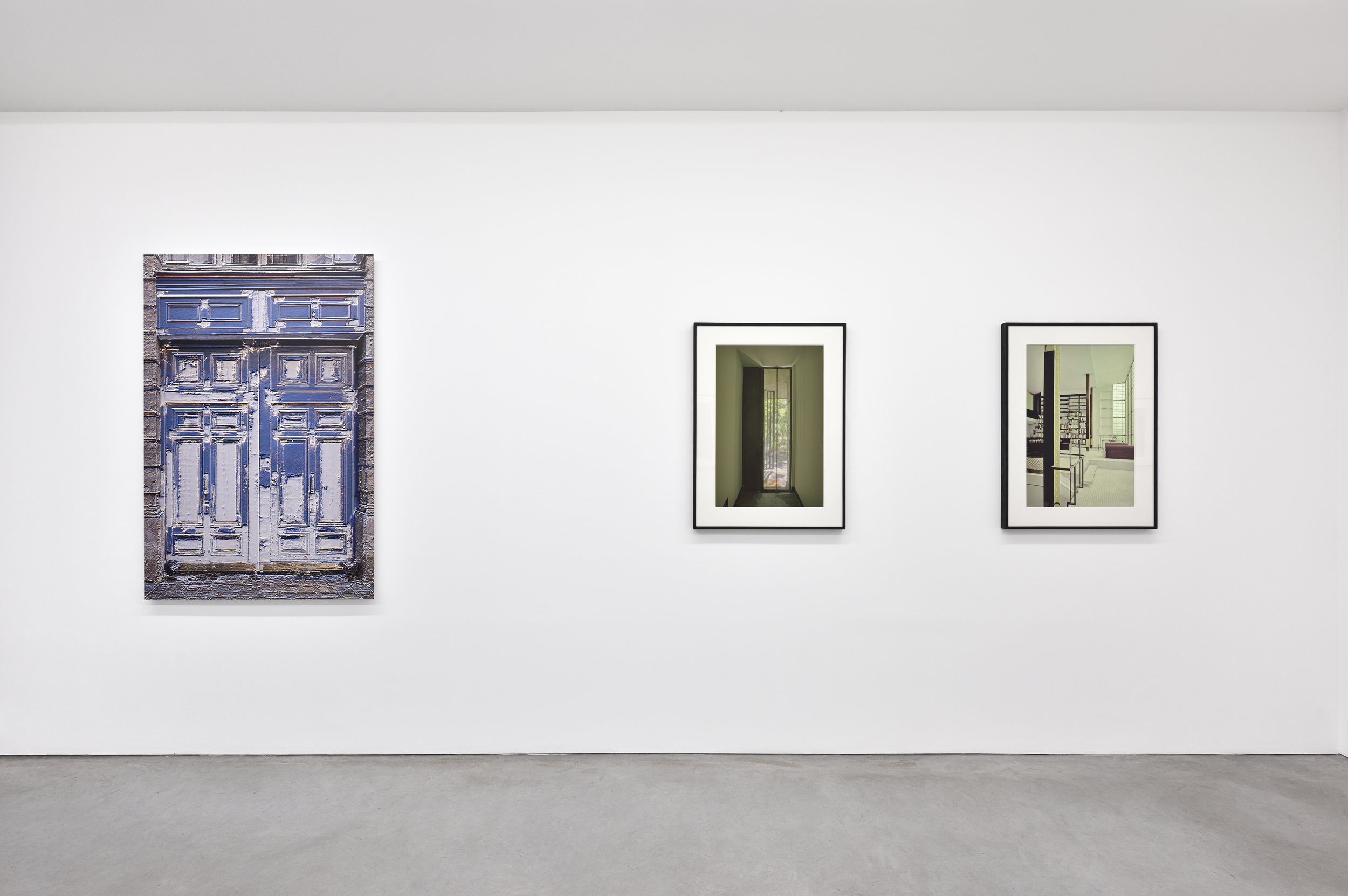






Exhibition Views, James Welling: Thought Objects, Italy and France, Galerie Marian Goodman, Paris, 2025 Copyright James Welling Courtesy the artist and Marian Goodman Gallery Photo credit: Rebecca Fanuele
At 66 rue du Temple, three 2023 Thought Objects depict quintessential French architectural elements: the circular staircase in Le Corbusier's Villa Savoye, entrance columns of Claude-Nicolas Ledoux's Saline Royale d'Arc-et-Senans and a half-painted typical Parisian door. For Staircase, Villa Savoye, 2022, Welling photographed a sheet of paper coated with blue and orange ink, and digitally superimposed it over a view of the villa's spiral staircase. For Royal Salt-Works, Arc-et-Senans, 2023, Welling further extends the equidensity process to exaggerate the contours of the columns, thereby generating a bas-relief effect reminiscent of the outlines in a Herge’s Tintin cartoon.
A selection of Welling's earliest digital color transformations can also be found in 66 rue du Temple. The Maison de verre, an architectural landmark built between 1928 and 1931 in the 7th arrondissement of Paris for Doctor Jean Dalsace, is transformed in an interplay between artificial color, metal and glass, where all three elements form a creative dialogue. Welling over saturated certain areas of the fifteen photographs in the series and altered light and shadow in others. These interventions create a visual experience in which the architecture is both subject and material for transformation.
JAMES WELLING Paris Door, 2017/2023 UV-curable ink on Dibond aluminum 63 3/8 x 42 x 1 7/8 in. (161 x 106.6 x 4.8 cm) Edition of 5 plus 2 artist's proofs Copyright James Welling Courtesy the artist and Marian Goodman Gallery
The gallery held an artist’s talk by James Welling, Saturday January 18 at 5 pm at the gallery, 79 rue du Temple. His presentation was followed by a conversation with Simon Baker, director of the MEP, Maison Européenne de la Photographie in Paris. Admission is free upon reservation.
James Welling was born in Hartford (Connecticut), USA, in 1951. He lives and works in New York. He studied fine art at Carnegie-Mellon University and modern dance at the University of Pittsburgh before obtaining his MFA from the California Institute of the Arts (CalArts) in 1974. Welling was a professor in the Department of Art at the University of California at Los Angeles (UCLA) from 1994 to 2016 where he ran the Photography Area. Since 2012, he has been a lecturer with the status of Professor at Princeton University in New Jersey. In 2014, he received the Infinity Award from the International Center of Photography in New York and in 2016 the Award of Excellence from the Julius Shulman Institute at Woodbury University in California.
JAMES WELLING Bike, Rome, 2024 UV – curable ink on Dibond alumin 42 x 63 3/8 x 1 7/8 in. (106.6 x 161 X 4.8 cm) Edition of 5 plus 2 artist’s proofs Copyright James Welling Courtesy the artist and Marian Goodman Gallery
Welling's protean photographic work has been the subject of numerous solo exhibitions since the late 1970s. In 2017, Metamorphosis, a major retrospective of his work, was presented in Europe at the Stedelijk Museum voor Aktuele Kunst (S.M.A.K.) in Ghent, Belgium, and at the Kunstforum in Vienna, Austria. Recent exhibitions include Dark Matter, combining his work with that of Thomas Ruff, at the Kunsthalle Bielefeld, Germany (2022), Cento at the Musée des Arts Contemporains du Grand Hornu (MACS), Hornu, Belgium (2021), Choreograph at the George Eastman Museum, Rochester, New York (2020), Monograph, at the Cincinnati Art Museum and the Hammer Museum, Los Angeles (2013), Autograph at the Fotomuseum Winterthur, Switzerland and Mind on Fire at the MK Gallery, Milton Keynes, England, the Centro Galego de Arte Contemporánea, Santiago de Compostela, Spain and the Contemporary Art Gallery, Vancouver, Canada (2012). Recent group exhibitions include Reverberations at the Museum of Contemporary Art (MOCA), Los Angeles (2024); Medardo Rosso Inventing Modern Sculpture, at Mumok in Vienna, Austria (2024); Epreuves de la matière at the Bibliothèque nationale de France (BNF) in Paris (2023); True Pictures? Contemporary Photography from Canada & The USA at the Sprengel Museum Hannover in Germany (2021), In Focus: Platinum Photographs, at the Getty Center in Los Angeles (2020).
Marian Goodman Gallery champions the work of artists who stand among the most influential of our time and represents over five generations of diverse thought and practice. The Gallery’s exhibition program, characterized by its caliber and rigor, provides international platforms for its artists to showcase their work, foster vital dialogues with new audiences, and advance their practices within nonprofit and institutional realms. Established in New York City in 1977, Marian Goodman Gallery gained prominence early in its trajectory for introducing the work of seminal European artists to American audiences. Today, through its exhibition spaces in New York, Los Angeles, and Paris, the Gallery maintains its global focus, representing some 50 artists working in the U.S. and internationally.
The exhibition opened on 17 January and will be on view until 8 March 2025 at the Marian Goodman’s location in Paris at 79 & 66 rue du Temple, 75003. For more information about the exhibit, please visit the Marian Goodman Gallery’s site. The gallery can be found on Instagram and Artsy, too.
HERVÉ DI ROSAIDOLES ET TRESORS/IDOLS AND TREASURES
Toutes les images / All images: © Courtesy of the artist and TEMPLON, Paris - Brussels - New York
Galerie Templon is delighted to present its first show of the striking work of Hervé Di Rosa, one of the founding artists of the Figuration Libre movement.
Originally from Sète in southern France, Hervé Di Rosa has gradually forged an artistic path inspired by popular culture, animated film and comic books. His work, infused with curiosity and innovation, has found expression through fruitful collaborations with various artisans from around the world. It has manifested in a vast array of techniques, ranging from acrylic on canvas to sculpture, egg tempera and gold leaf on wood, alongside painting on azulejos.





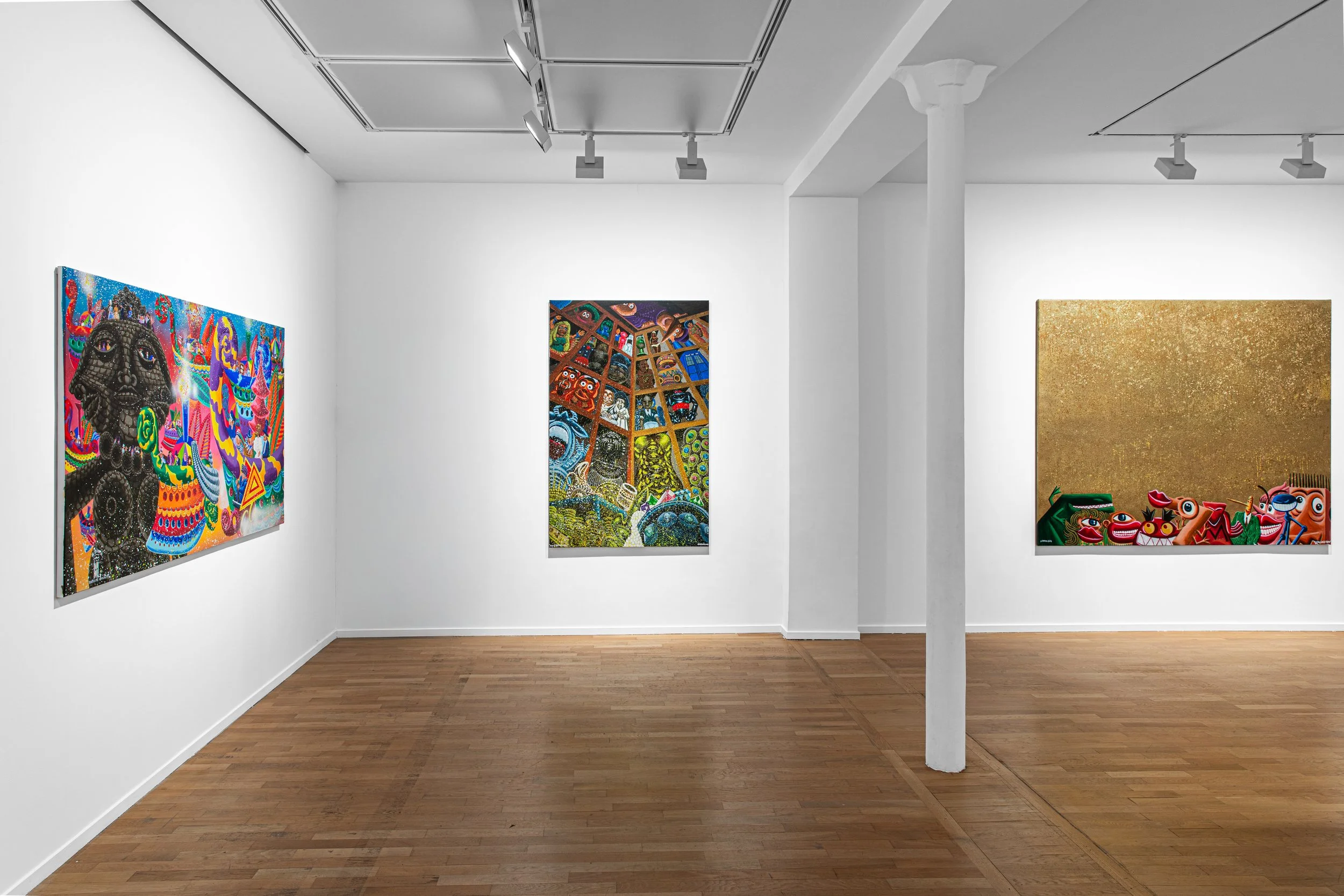




Toutes les images / All images: © Courtesy of the artist and TEMPLON, Paris - Brussels - New York
With “Idols and Treasures”, Hervé di Rosa showcases his journey as a painter over the past five years. The exhibition features a series of around a dozen of medium-sized and large-format paintings created between 2020 and 2024. The artist pays tribute to nearly four centuries of cultural explorations which have shaped history, drawing from the rich traditions of painting, sculpture, music and literature. Each canvas invites visitors to immerse themselves in Di Rosa’s lavish and deceptively naive world.
HERVÉ DI ROSA TOTAL GOLD SHOW, 2024 Acrylique sur toile | Acrylic on canvas 170 × 207 cm — 67 × 81 1/2 in Courtoisie de l'artiste et Templon, Paris – Bruxelles - New York | Courtesy of the artist and Templon, Paris – Brussels - New York Photo © Tanguy Beurdeley
Rejecting all sense of hierarchy, the artist's canvases evoke Christopher Colombus’ majestic caravels, Jules Verne's mysterious abysses, the imposing Mayan temples of Chichen Itza and the sumptuous sarcophagi of the most illustrious of Egyptian pharaohs. These complex compositions, situated at the edge of surrealism, unveil hybrid characters, ranging from historical figures to endearing four-eyed monsters and nurturing mother earth figures made of bricks. Di Rosa’s enchanting microcosms thus establish a playful and constructive dialogue between the fine arts, applied arts, outsider art and cultivated art, as well as between Western and non-Western art. With this work Di Rosa, a dazzlingly unique artist, reveals a vision of art without borders, transcending cultural genres and geographical origins, effectively abolishing any hierarchy that values high culture over low culture.
HERVÉ DI ROSA LE PARADIS DES CHASSEURS, 2024 Acrylique sur toile | Acrylic on canvas 108.5 × 201 cm — 42 3/4 × 79 1/4 in Courtoisie de l'artiste et Templon, Paris – Bruxelles - New York | Courtesy of the artist and Templon, Paris – Brussels - New York Photo © Tanguy Beurdeley
Born in 1959, Hervé Di Rosa lives and works between Lisbon, Paris and Sète. A student at the École Nationale Supérieure des Arts Décoratifs in Paris, Hervé Di Rosa began selling his paintings in 1979. At just 20 years old, he was already exhibiting in Paris, Amsterdam and New York. In 1981 he co-founded the art movement Figuration Libre, as named by the artist Ben. This group, which included Robert Combas, Rémi Blanchard and François Boisrond, echoed other marginalized forms of international expressions, from Neo-expressionism and New Fauves in Germany to the Transavantgarde in Italy and even Bad Painting in the United States.
Since 1981 his work has appeared in over 200 solo exhibitions and is included in major public and private collections in Europe, the USA and Asia. Recent solo and group exhibitions in France include shows at La Maison Rouge, Paris (2016), La Piscine - Musée d’Art et d’Industrie André-Diligent, Roubaix (2018), Musée de Valence (2022) and Musée National d’Art Moderne - Centre Pompidou, Paris (2024). The Musée des Civilisations de l'Europe et de la Méditerranée in Marseilles (MUCEM) will hold a solo exhibition in March 2025.
A pioneer and champion of the concept of “Modest Art”, Di Rosa founded the Musée International des Arts Modestes (MIAM) in 2000 in Sète. The museum exhibits a wide range of artists from all over the world and creates shows that question the boundaries of contemporary art. Hervé Di Rosa has been a member of the Académie des Beaux-Arts since 2022.
For more information about Hervé’s artwork and his exhibition, please visit Templon’s site. The gallery can also be found on Instagram, artnet, Facebook, YouTube, and Artsy. An interview with Hervé with the magazine can be found here.
McArthur Binion Rawness Dancing : With Intellect
Visual:Ear(Sound Grammar), 2024 graphite, ink, paintstick and paper on board 213.4 × 213.4 × 5.5 cm, 84 × 84 × 2 1⁄8 in. Courtesy the Artist and Xavier Hufkens, Brussels
Rawness Dancing: With Intellect is an exhibition dedicated to the pioneering work of American artist McArthur Binion (b. 1946, Mississippi). Curated by Anne Pontégnie, it showcases the development of Binion’s work over the course of the last 15 years. Different series are brought together for the first time, divided into three themes across three floors. Highlights include a rare early work from 1985, together with a series of DNA works, the never previously exhibited Haints series (2014) and a group of six new Visual: Ear paintings (2023-24). McArthur Binion’s work blends elements of minimalism and conceptualism with autobiographical and cultural narratives, resulting in paintings and drawings that are both visually compelling and emotionally resonant. Over the years, his art has evolved through changes in technique, theme, and the exploration of personal and historical memory. The title alludes to the harmony between emotional and physical labour, as described by the artist: “my intellect and rawness are dancing together”.
Visual: Ear, 2023 ink, paper and paintstick on board 182.9 × 121.9 × 5.5 cm, 72 × 48 × 2 1⁄8 in. Courtesy the Artist and Xavier Hufkens, Brussels
The exhibition opens with McArthur Binion’s latest paintings in the Visual:Ear series, a tribute to Jazz records of particular significance to the artist. The series comprises of 12 paintings in total, half of which are exhibited here for the first time. The first room includes, for example, Visual: Ear (Maestro Duke), a tribute to Duke Ellington, and Visual:Ear (Unit Structures), honouring Cecil Taylor’s album. They are bordered with photographs of the musicians repeated alongside the edges of the paintings, a framing device reminiscent of quilts. The Visual:Ear paintings are a continuation of Binion’s exploration of music and visual abstraction, dating back to his time at the Cranbrook Academy of Art. It was here that he created Drawn Symphony:in:Sane Minor, a hand-drawn piece on musical manuscript paper, in 1971. Binion introduced the ‘visual ear’ concept in his 1973 graduation thesis represents his first attempt to visualize music. The current Visual: Ear series began in 2021, with each painting built on a collaged base of musical scores. He calls this layer, which varies from series to series, the ‘underconscious’. Using oil sticks, Binion creates dense, repetitive markings that form geometric patterns and grids, partially hiding the initial imagery. This interplay of concealment and revelation invites viewers to explore the music-inspired and personal narratives within the artwork. Born in Mississippi, the birthplace of the blues, Binion was immersed in a cultural milieu that valued rhythm, improvisation and storytelling --qualities that still reverberate through his work. Within the gridded compositions, he combines methodical, dynamic structures with layering techniques, similar to the rhythms and improvisation of blues and jazz. Binion uses music as a source of creativity and a way of analysing the structure and emotions in his work. The lighter variants of the series are displayed on the floor below.
Haints, 2014 paint stick, and wax crayon on board 116.8 × 162.6 × 6.8 cm, 46 × 64 × 3 in. Courtesy the Artist and Xavier Hufkens, Brussels
The Haints series (2014) in the adjacent rooms consists of ten works that explore the artist’s Mississippi roots and Southern upbringing. Haint is an alternate spelling of ‘haunt’, a term used by African-Americans to describe ghosts or restless spirits. McArthur Binion elaborates: “They involve reverse maps of Mississippi, and are an extension of the DNA:Studies. They are larger self- portraits about who I am and how I live all the information is there. These works are specifically about me. They are about my involvement with haints and Mississippi... Haints are about people that you knew that are dead so the ghosts are real. It’s really emotional with the work.” In a break with his typical practice, the Haints are devoid of an underconscious. He continues: “I associate the haints with the legend of people down South crawling out of their skin; I’ve been looking for haints all of my life. The haints swirl around all of the maltreatment that has happened in Mississippi for centuries and centuries the lynchings, the rape, the regular straight up murders, etc. My father worked seven days a week and made $7.32 per week. So I know what haints are.”
dna:sepia:xiii, 2016 paintstick, ink and paper on board 121.9 × 101.6 × 5.3 cm, 48 × 40 × 2 1⁄8 in. Courtesy the Artist and Xavier Hufkens, Brussels
A selection of the artist’s DNA:Studies are shown on the first floor, alongside smaller format works from both the Hand:Work and Visual:Ear series. Colour, autobiography and technique are key focal points in this display. Binion’s DNA:Studies, a subset of the broader DNA series, is a cornerstone of his practice. Central to this body of work is Binion’s replication of his old address and telephone book as the underconscious, a uniquely private artefact that encapsulates years of relationships, connections and memories. With its handwritten entries and worn pages, the book is a literal and symbolic repository of his life experiences. He says: “Each day for the months I painted those, I relived every day of my life because of all of those names.” The names and numbers, partially obscured by layers of oil stick or crayon, are visible upon close examination, adding a narrative layer to the otherwise austere, minimalist grids. The repetitive mark-making, a hallmark of Binion’s practice, recalls the meditative labour of memory and identity formation. It also evokes the physicality and discipline of his early life, spent working on a farm in rural Mississippi.
Sketch (Looking for Grey):For: Three Movements of Sunlight, 2014 paintstick, ink and paper on board 121.9 × 81.3 × 5.7 cm 48 × 32 × 2 1⁄4 in. Courtesy the Artist and Xavier Hufkens, Brussels
This contemplative yet physically demanding process also transforms the grid into a tangible record of the artist’s presence. His gestures both conceal and reveal, creating a dynamic tension that reflects the complexity of memory and identity. Binion’s works are thus defined by the proportions of his body, such as hand span and arm length, as well as his physical agility. In the series Hand:Work, Binion makes this connection explicit by incorporating images of his own hand into the underconscious. By foregrounding the physical nature of his practice, Binion challenges the impersonal, mechanical associations of abstraction and minimalism. His art becomes a testament to the interplay between the intellectual and the corporeal, the personal and the universal. Through this embodied approach, Binion transforms the act of making art into a profound exploration of what it means to inhabit a body and a history. He creates works that are as much about the process of becoming as they are about the final form.
Portrait by Pasquate Abbattista
McArthur Binion lives and works in Chicago. His works were featured prominently in the 57th Venice Biennale, VIVA ARTE VIVA. Solo exhibitions of his work have been organised at Peter Marino Art Foundation, Southampton, NY, USA (2024); Museo Novecento, Florence, Italy (2020); the Cranbrook Art Museum, Bloomfield Hills, MI (2018); the Contemporary Art Museum, Houston, TX (2012). Binion’s work is in numerous public and private collections and his most recent venture is the Modern Ancient Brown Foundation that provides funding and workspaces to help young visual artists and writers of
colour find their voices.
The exhibition opened on January 16 and will be on view until March 8th, 2025. For more information about this exhibition and others, please visit Xavier Hufken’s site here. The gallery can also be found on Instagram, Facebook, and YouTube.
Louise Nevelson: ShadowDance
Louise Nevelson: Shadow Dance 540 West 25th Street, New York, NY 10001 January 17 – March 1, 2025 Photography courtesy Pace Gallery
New York – Celebrating its 62-year history with Louise Nevelson, Pace is pleased to present Louise Nevelson: Shadow Dance, a major exhibition of Nevelson’s late works, curated by gallery founder Arne Glimcher, at its 540 West 25th Street location in New York. The exhibition opened on January and will be on view until March 1, 2025, this show will place Nevelson’s iconic monochromatic sculptures in black and white in dialogue with her collages—including several rarely seen and never previously exhibited masterworks—made in the 1970s and 1980s.
Like Mondrian’s, Nevelson’s compositions are based on a strict adherence to vertical and horizontal regularity. During the 1970s and 1980s, there was a significant development: Nevelson incorporated the diagonal into her vocabulary. A new, angular energy surfaced in many of the works she produced during this period, breaking the rules by which she traditionally composed her work.
Louise Nevelson, Study for the Chapel of the Good Shepherd, c. 1975 SCULPTURE wood painted white 90-1/2" × 36" × 24" (229.9 cm × 91.4 cm × 61 cm) overall 48-1/4" × 7-1/4" × 13" (122.6 cm × 18.4 cm × 33 cm), hanging element 90-1/2" × 11" × 13" (229.9 cm × 27.9 cm × 33 cm), column © Louise Nevelson / Artists Rights Society (ARS), New York.
These late works shed new light on her evolving aesthetic, bringing into focus a series of remarkably productive years of her practice in which she experimented with a new vocabulary of robust, muscular, and often minimal forms while staying true to her lifelong investigations of materiality, shape, and shadow.
Rooted in the legacies of Cubism and Constructivism, Nevelson’s artworks were widely celebrated during her lifetime for incorporating unexpected combinations of materials and forms. As part of her distinctive approach to abstraction, the artist often explored the myriad possibilities of collage—a technique she transposed into sculpture by means of compartmentalized elements and forms liberated from everyday meaning. Nevelson’s use of the collage aesthetic was formalist. Her art of scavenging and her affinity for the materiality of wood are linked to her personal life and her remarkable story.
Louise Nevelson, Dawn's Light, c.1975 SCULPTURE wood painted white 106" × 63" × 55" (269.2 cm × 160 cm × 139.7 cm)© Louise Nevelson / Artists Rights Society (ARS), New York.
Since Nevelson’s death there has been a series of radical re-appraisals of her work, especially as new frameworks and dialogues in art history have emerged in recent years. The gallery’s upcoming presentation in New York coincides with a global upswell of interest in her work, which is underscored by a forthcoming retrospective of the artist organized by the Centre Pompidou-Metz in France, opening to the public in fall 2025. This past year, Nevelson was honored in memoriam at the Art Students League’s annual gala in New York—the artist was an alumna of the institution—and in 2022, a sprawling exhibition of her work, Louise Nevelson: Persistence—curated by Julia Bryan- Wilson, Columbia University professor and author of Louise Nevelson’s Sculpture: Drag, Color, Join, Face (Yale University Press, 2023)—was presented as an official collateral event of the 59th Venice Biennale, and her work was also included in the main exhibition curated by Cecilia Alemani.
Louise Nevelson, Artillery Landscape, c. 1985 SCULPTURE wood painted black 57" × 152" × 107" (144.8 cm × 386.1 cm × 271.8 cm)© Louise Nevelson / Artists Rights Society (ARS), New York.
Pace presented its first solo show of work by Nevelson in 1961 in Boston, and it has represented the artist—with whom the gallery’s Founder and Chairman Arne Glimcher maintained a decades-long friendship—since 1963. Early in their relationship, Nevelson took the young Glimcher under her wing, introducing him to all of the most important Abstract Expressionist artists and bringing him into the fold of the New York art world. Later, in the 1970s and 1980s, Glimcher helped Nevelson achieve a new level of international recognition, supporting her in the production of numerous large-scale public commissions around the United States and the world. Opening at the beginning of Pace’s 65th anniversary year, this forthcoming Nevelson exhibition reflects the artist’s enduring and deeply personal relationship with Glimcher, and her indelible place in the gallery's history and its ethos today.







Louise Nevelson: Shadow Dance 540 West 25th Street, New York, NY 10001 January 17 – March 1, 2025 Photography courtesy Pace Gallery
Louise Nevelson: Shadow Dance will showcase two of Nevelson’s rare white-painted wood sculptures—Study for the Chapel of the Good Shepherd and the never-before-exhibited Dawn’s Light, both created circa 1975—among her signature black-painted wood sculptures, including the large-scale freestanding composition Cascade- Perpendiculars XXX (1980–1982). Nevelson specifically spoke about the relationship of her black and white works to the perceptual thresholds of dawn and dusk, the liminal, transitional, and indiscernible moments between day and night. Harkening back to her famed large-scale, all-white sculptural installation Dawn’s Wedding Feast (1959)— which was presented at the Museum of Modern Art as a single installation before being split into separate parts— Dawn’s Light speaks to the ways that Nevelson’s later expressions were guided by the project of transformation and transfiguration that energized her practice for more than four decades.
Louise Nevelson, Cascade-Perpendiculars XXX, 1980-1982 SCULPTURE wood painted black 94-1/2" × 38-1/2" × 21-1/2" (240 cm × 97.8 cm × 54.6 cm) © Louise Nevelson / Artists Rights Society (ARS), New York.
The gallery’s presentation will also feature Artillery Landscape (ca.1985), a single sculpture consisting of a group of individual floor-based elements, which was exhibited for the first time as part of Louise Nevelson. Persistence in Venice in 2022. Never before seen in the United States, this sculptural installation comprises reclaimed wooden artillery boxes found, reconstructed, and painted black by Nevelson in the last few years of her life. The hinged box- like elements of Artillery Landscape refer back to Nevelson’s psychologically charged Dream House series of the early 1970s, yet the title of the work derives from the origin of the boxes themselves, scavenged and repurposed artillery containers for artillery. Of her interest in reclaimed materials, she once said, “I wanted to show that wood picked up on the street can turn to gold.”
Louise Nevelson: Shadow Dance 540 West 25th Street, New York, NY 10001 January 17 – March 1, 2025 Photography courtesy Pace Gallery
Highlights in the exhibition include three wall-mounted works from the Mirror Shadows series of magisterial wall reliefs, one of the last bodies of work that Nevelson produced and among her most innovative. Alongside these important late sculptures, a selection of Nevelson’s collages attest to her intensely personal and private mode of expression, which she kept mostly secret during her lifetime. In the economy of Nevelson’s studio, the collage works emerged simultaneously with her monochromatic sculptures as extensions of the same creative gesture. Providing a new avenue for explorations of color, light, shadow, reflection, and line, these works incorporate combinations of metallic foil, cardboard, sandpaper, tape, wood, spray paint, printed paper, and newspaper. Tearing and re- combining traces of the past to produce a raw, unfiltered beauty, Nevelson developed an aesthetic of fragmentation and reassembly in her collages that animated the spirit of all her work.
Portrait of Louise Nevelson: © The Estate of Pedro E. Guerrero
Louise Nevelson (b. 1899, Kiev; d. 1988, New York), a leading sculptor of the 20th century, pioneered site-specific and installation art. She is best known for her monumental sculptures composed of discarded furniture and wooden elements found near her New York City studio. Nevelson arranged these elements into nested, box-like structures, she would then paint them in monochromatic black, white, or gold—transforming disparate elements into a unified structure. She also experimented with bronze, terracotta, and Plexiglas, eventually moving into the realm of collage, works on paper, and public art. With her compositions, Nevelson explored the relational possibilities of sculpture, summing up the objectification of the external world into a personal landscape. Although her practice is situated in lineage with Cubism and Constructivism, her sense of space and interest in the transcendence of the object reveal an affinity with Abstract Expressionism.
Nevelson has been the subject of over 70 one-artist exhibitions, including over ten traveling exhibitions, held at institutions worldwide including The Jewish Museum, New York (1965, 2007); Whitney Museum of American Art, New York (1967, 1970, 1980, 1987, 1998, 2018); Moderna Museet, Stockholm (1973, 2017); Solomon R. Guggenheim Museum, New York (1986); and Centre Georges Pompidou, Paris (1997). Recent exhibitions include Louise Nevelson In L.A.: Tamarind Workshop Lithographs From the 1960s, Los Angeles County Museum of Art (2015); Reflections: Louise Nevelson, 1967, Rose Art Museum, Waltham, Massachusetts (2017); The Fourth Dimension, San José Museum of Art, California (2017); The Face in the Moon, Whitney Museum of American Art, New York (2018); Louise Nevelson, Institute of Contemporary Art, Miami (2019–2020); Louise Nevelson: Sculptor of Shadows / Skyggernes Skulptør, Kunsten Museum of Modern Art, Aalborg, Denmark (2020–2021); Louise Nevelson: Dawn to Dusk, Farnsworth Art Museum, Rockland, Maine (2023–2024); and The World Outside: Louise Nevelson at Midcentury, Amon Carter Museum of American Art, Fort Worth, Texas (2023–2024). Nevelson’s work is held in over 140 public collections worldwide including The Aldrich Museum of Contemporary Art, Ridgefield, Connecticut; The Art Institute of Chicago; Brooklyn Museum, New York; Dallas Museum of Art, Texas; Solomon R. Guggenheim Museum, New York; Los Angeles County Museum of Art; The Metropolitan Museum of Art, New York; and Tate, London, among many others.
Pace is a leading international art gallery representing some of the most influential contemporary artists and estates from the past century, holding decades-long relationships with Alexander Calder, Jean Dubuffet, Barbara Hepworth, Agnes Martin, Louise Nevelson, and Mark Rothko. Pace enjoys a unique U.S. heritage spanning East and West coasts through its early support of artists central to the Abstract Expressionist and Light and Space movements.
Since its founding by Arne Glimcher in 1960, Pace has developed a distinguished legacy as an artist-first gallery that mounts seminal historical and contemporary exhibitions. Under the current leadership of CEO Marc Glimcher, Pace continues to support its artists and share their visionary work with audiences worldwide by remaining at the forefront of innovation. Now in its seventh decade, the gallery advances its mission through a robust global program— comprising exhibitions, artist projects, public installations, institutional collaborations, performances, and interdisciplinary projects. Pace has a legacy in art bookmaking and has published over five hundred titles in close collaboration with artists, with a focus on original scholarship and on introducing new voices to the art historical canon.
Today, Pace has seven locations worldwide, including European footholds in London and Geneva as well as Berlin, where the gallery established an office in 2023. Pace maintains two galleries in New York—its headquarters at 540 West 25th Street, which welcomed almost 120,000 visitors and programmed 20 shows in its first six months, and an adjacent 8,000 sq. ft. exhibition space at 510 West 25th Street. Pace’s long and pioneering history in California includes a gallery in Palo Alto, which was open from 2016 to 2022. Pace’s engagement with Silicon Valley’s technology industry has had a lasting impact on the gallery at a global level, accelerating its initiatives connecting art and technology as well as its work with experiential artists. Pace consolidated its West Coast activity through its flagship in Los Angeles, which opened in 2022. Pace was one of the first international galleries to establish outposts in Asia, where it operates permanent gallery spaces in Hong Kong and Seoul, along with an office and viewing room in Beijing. In spring 2024, Pace will open its first gallery space in Japan in Tokyo’s new Azabudai Hills development.
The exhibition opened on January 17th and will be on view until March 1, 2025, at Pace Gallery 510 West 25th Street in New York. For more information about this exhibition and others, please visit the Pace Gallery’s website here. Pace Gallery can be found on Instagram and Artsy, too.
Allan Wexler : Probably True
Installation view. Courtesy of the artist and Jane Lombard Gallery. Photo credit: Adam Reich
Jane Lombard Gallery is pleased to present Probably True, Allan Wexler’s debut solo exhibition with the gallery. For nearly fifty years, Wexler has created work informed by his architectural background and education. He produces functional absurdities that interrogate distinctions between human activity and the built environment. Wexler’s sculptures, drawings, and photographs represent subtle, unexpected spaces where interventions are fostered. The exhibition opened on January 17th and will run until - March 8th.
Courtesy of the artist and Jane Lombard Gallery
Utilizing pedagogy and the manipulation of materials, Wexler’s practice often draws on the conceptual spirit of the Fluxus movement, blending humor with intellectual rigor. By blurring the lines between the functional and the absurd, the practical and the philosophical, his work challenges us to reconsider our habits and rituals. In Wexler’s universe, everyday items such as chairs, coffee cups, or utensils become mediators of social interaction, re-constructed to connect and merge. In the sculptures Interchange, Extruded Dinnerware, and Light Table, the artist explores the ways in which ordinary, domestic objects act as catalysts for alternate modes of sitting, dining, or conversing.





Installation view. Courtesy of the artist and Jane Lombard Gallery. Photo credit: Adam Reich
Wexler's work additionally reimagines objects drawn from nature. In Reframing Nature, a curved tree branch is straightened through the meticulous insertion of wood wedges, a human intervention in sculptural and photographical form. The exploration of the cyclical nature of objects and their meanings continues in Burnt Chair / Charcoal Drawing; a charred wooden chair, from which its charcoal is used to draw an image of the same chair on paper. This act of transformation, the chair becoming both object and medium, highlights Wexler’s practice as an exercise in recontextualization.
Installation view. Courtesy of the artist and Jane Lombard Gallery. Photo credit: Adam Reich
The exhibition introduces a new series of handworked images that blend elements of sculpture and photography to depict what the artist calls “landscape interventions. ” These two-dimensional works are fabricated scenes that challenge the realities of photography and drawing, incorporating recurring motifs found throughout Wexler’s work such as the cone structure, seen in both Speakers and Cones of Vision. Altogether, the works in Probably True capture Wexler’s ability to expose the conceptual world that informs our lived experiences, question the conditions of its construction, and purposefully turn it on its head.
About Allan Wexler
Allan Wexler (b. 1949) was an early member of the group of architects and artists who questioned the perceived divide between art and the design disciplines in the late 1960s. They called themselves Non-architects or Paper Architects. In 2017, Lars Müller published Absurd Thinking: Between Art and Design, a book on Wexler’s work and creative process. The book features projects developed across the artist’s career that mediate the gap between fine and applied art using the mediums of architecture, sculpture, photography, painting, and drawing.
Wexler earned his Bachelor of Fine Arts (1971) and his Bachelor of Architecture (1972) from RISD and his Master of Architecture from Pratt Institute (1976). He is a recipient of a Guggenheim Fellowship (2016), a Fellow of the American Academy in Rome, and a winner of both a Chrysler Award for Design Innovation and the Henry J. Leir Prize from the Jewish Museum. He has executed and collaborated on public art commissions at several locations, including Hudson River Park at 29th Street (2006), Atlantic Terminal, Long Island Railroad (2009), and Pratt Institute (2008, 2012), among many others. Wexler has exhibited nationally and internationally, including at La Arsenale, Biennale Architettura, Venice, IT; The Contemporary Jewish Museum, San Francisco, CA; Museum of Contemporary Art Chicago, Chicago, IL; Walker Art Center, Minneapolis, MN; Mattress Factory, Pittsburgh, PA; Parrish Art Museum, Southampton, NY; San Francisco Museum of Art, San Francisco, CA; Karl Ernst Osthaus Museum, Hagen, GE; De Cordova Museum and Sculpture Park, Lincoln, MA; The Jewish Museum, New York, NY; among many others. Wexler currently teaches at Pratt Institute, Brooklyn.
About Jane Lombard Gallery
Jane Lombard Gallery was founded in New York in 1995 as Lombard-Freid Projects. Currently located in TriBeCa, the gallery has maintained its commitment to the work of emerging, mid-career, and established contemporary artists working across media and disciplines. The gallery continues to showcase an international roster of artists who tend toward cultural commentary and the exploration of contemporary socio-political climates.
For more information about this exhibition at the Jane Lombard Gallery, please visit their website here. The gallery can also be found on Facebook and Instagram. The magazine conducted and interview with Allan which can be found here.
David Altmejd: Prélude pour un nouvel ordre mondial
Photo Credit : Thomas Merle
In Prélude pour un nouvel ordre mondial, Canadian artist David Altmejd unveils a body of new sculptures and drawings. For the first time in his career, Altmejd combines these two mediums, exploring their connections and revealing how past and new ideas in his work come together. As the title implies, this exhibition marks the beginning of fresh trajectories in Altmejd’s ever-evolving artistic realm. From the celestial heavens to the depths of the earth, the natural world is the lifeblood of David Altmejd’s oeuvre. In his new sculptures, Altmejd introduces an expanded pantheon of hybrid, anthropomorphic beings that allude to the multi- faceted power of animals in various cultures and belief systems. The works are rich in symbolism and evoke a transcendent quality that surpasses the boundaries of the physical world. Rams, an orca, snakes, a panther, birds, rabbits and swans have all made their way into the oeuvre, serving as metaphors and companions since time immemorial, with their wisdom often pointing the way to spiritual enlightenment. Consider, for instance, the Bible, the Koran, the Dhammapada, the Analects of Confucius, or Aesop’s fables.



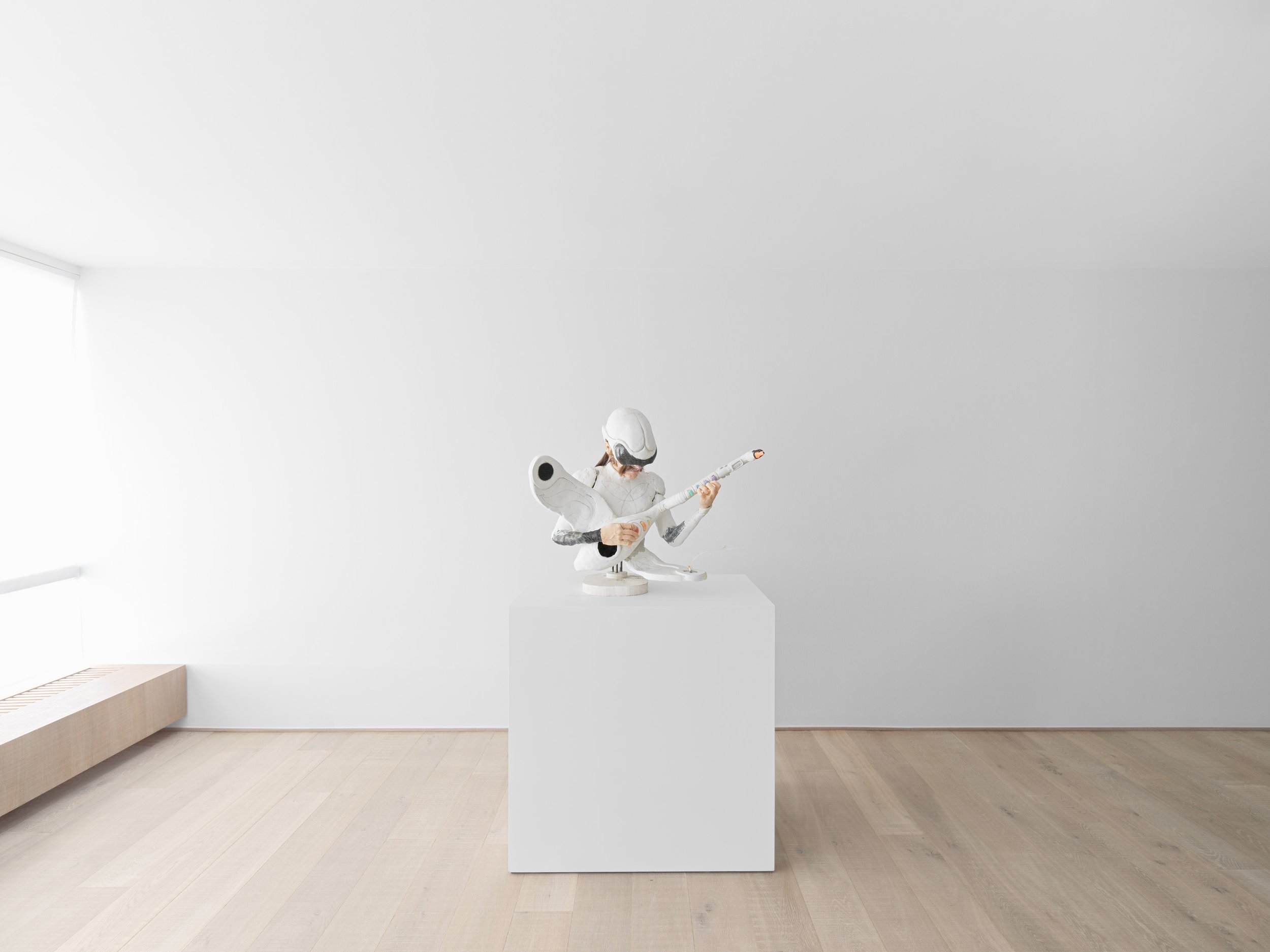

Installation View: David Altmejd Prélude pour un nouvel ordre mondial, 22 November 2024 —8 February 2025 courtesy Xavier Hufkens and Allard Bovenberg
Among the variety of animals Altmejd explores, swans take centre stage in his new body of work. The swans have metamorphosised into musical instruments, through which the artist draws parallels between nature and music, highlighting their shared qualities of order and disorder. The seven colours of the instrument’s keys here are not coincidental, symbolising various references across different eras and cultures1. In numerology, seven represents the union of the spiritual (3) and material (4) worlds, while in music, there are seven notes in a musical scale. Conversely, the figures playing swan instruments wear helmets that conceal their vision, suggesting a sense of detachment from their surroundings. The idea that they might hail from another dimension is further supported by the presence of space-time grids in the artist’s drawings. It is also worth noting that, human eyes— which Altmejd once emphasised or even replicated—have now vanished, along with any reference to the artist himself. In these new works, the focus moves from self- portraiture to visored beings.
Altmejd’s fused forms evoke metamorphosis, growth and decay, and often visualize transformation processes. Animals and humans frequently mutate, as in Nocturne no 1, where human hands mould the whale’s flesh, a creature that features in many ancient mythologies. The unctuous, carbon-like matter of the body is akin to the prima materia, which is the primitive formless base of all matter, similar to chaos, the quintessence or aether. This sculpture seems to embody the regenerative force of nature, with a cosmic egg embedded in its back and a diamond–carbon in a different state–illuminating the world. It can be read as a metaphor for the splendour and enigma of the cosmos. Other enigmatic beings emerge, like the figure Ève, with its shimmering and venomous green face, evocative of witches, ogres, goblins and trolls. This green also resembles the iridescent colour of scarab beetles, revered in Ancient Egypt—creatures that also find their way into the artist’s drawings. Blending reality and imagination, Altmejd often employs myths and legends to explore nature. These allusions tap into ancient human perceptions of nature as a powerful and unpredictable force.
Le don, 2024.
The intertwining of humans and animals also echoes the ideas of the Swiss psychoanalyst Carl Jung (1875-1961), who held that animals are exalted beings, or the ‘sacred’ part of a person’s mind. He believed that they were much closer to a secret, natural order than humans, and thus nearer to the ‘absolute knowledge’ of the unconscious. Unlike people, who are bound by moral constructs of good and evil, animals adhere to natural laws, which Jung considered a form of superiority. He explored how our ‘animal nature’ could serve as a psychic source of renewal and wholeness.
These themes are reflected in the artist’s mixed-media drawings, which are neither preparatory studies nor working sketches. The matrixes reference space-time grid distortions and the theory of special relativity, while also invoking, in another sense, the transfer techniques of classical sculpture. But by virtue of being hand- drawn, the grids are imperfect. At times, they are punctured, caught in a vortex or distorted, creating glitches in the space-time continuum. The images in the drawings are fantastical and uncanny, arcane and vivid. Cryptic, undecipherable symbols represent the ‘language of the unconscious’.
L’accord universel, 2024.
Altmejd’s work, through its synthesis of seemingly opposing elements, reveals a deep interconnectedness between nature and the human form, life and death. The tension between organic and synthetic forms creates a dynamic that blurs the line between nature and artifice, evoking a sense of “unsettling familiarity”—a haunting blend of the known and unknown. In this paradoxical realm, the ordinary world is transformed, inviting us to reconsider our perceptions of reality.
David Altmejd (b. 1974, Montreal, Canada) lives and works in Los Angeles. His work was the subject of a major survey exhibition entitled Flux at the Musée d’Art Moderne de la Ville de Paris, France which travelled to the MUDAM in Luxembourg and the Musée d’Art Contemporain de Montréal, Canada (2014-15). In 2007, he represented Canada at the 57th Venice Biennale. Public collections include Museum of Modern Art, New York; Whitney Museum, New York; Solomon R. Guggenheim Museum, New York; National Gallery of Canada, Ottawa; Museum of Contemporary Art, Los Angeles; Long Museum, Shanghai; and MUDAM, Luxembourg, among others.
1 _ It is both a lucky number and a prime one; there are seven days of the week, each named after a different ancient god or planet; Shakespeare wrote about the seven stages of life; the lunar cycle lasts around seven days; and breaking a mirror is said to bring seven years of misfortune. There are seven energy centres, or chakras, each associated with a distinct shade, just as there are seven colours in a rainbow.
For more information about this exhibition and others, please visit Xavier Hufkens’s site here. The gallery can also be found on Instagram, Facebook, and YouTube.
BODY BUILDINGS BY ANTONY GORMLEY
Body Buildings, exhibition views, Galleria Continua / Beijing, 2024, Courtesy: the artist and GALLERIA CONTINUA, Copyright: © the Artist, Photographer: Huang Shaoli
Galleria Continua is pleased to present ‘Body Buildings’, Antony Gormley’s third solo exhibition at the 798 Art District in Beijing following ‘Another Singularity’ (2009) and ‘Host’ (2016). ‘Body Buildings’ interrogates our species’ relationship to the built environment, an increasingly high-rise world we rarely escape. In a significant group of recent sculptures and drawings, Gormley uses clay and iron, two ubiquitous materials of the built world, ‘to think and feel the body in this condition’.






Body Buildings, exhibition views, Galleria Continua / Beijing, 2024, Courtesy: the artist and GALLERIA CONTINUA, Copyright: © the Artist, Photographer: Huang Shaoli
The central work in the exhibition, Resting Place II, conjures a dense labyrinthine terrain that viewers are invited to enter and navigate. This field of 132 life-size bodies, each built from fired clay bricks stacked atop one another, investigates the body at rest as our primary dwelling place. For the artist, the brick is a ‘physical pixel’ that plays an important role in Chinese culture.
Constructed in different orthogonal yet precarious positions, the bodies evoke a range of conditions, from splayed relaxation to foetal self-protection. When viewed from the gallery’s first and second-floor balconies, the interplay between moving visitors and horizontal clay bodies creates a dynamic field in which the particularity of subjective experience is at work.
Body Buildings, exhibition views, Galleria Continua / Beijing, 2024, Courtesy: the artist and GALLERIA CONTINUA, Copyright: © the Artist, Photographer: Huang Shaoli
As Gormley has said: ‘Resting Place II evokes the human body’s relationship to the ground, the surface of the earth. It refers to two very different kinds of abandonment: the relaxed abandonment of the body on the beach, the place to which we return in childhood play and relaxation, and another, that of the migrant who has either forcibly or freely sought a new home. What at first looks like a chaotic display of building materials might resolve into the model of a city and further resolve into the invitation to empathise with the body as a place of indwelling, some evoking states of deep relaxation and contentment, others of retreat and defence.’
Body Buildings, exhibition views, Galleria Continua / Beijing, 2024, Courtesy: the artist and GALLERIA CONTINUA, Copyright: © the Artist, Photographer: Huang Shaoli
Accompanying Resting Place II are sculptures cast in iron, such as Circuit and Ally, which explore parallels between urban infrastructure—roads, electrical circuits, plumbing—and human relationships. Circuit transforms these networks into a circulatory system shared by two bodies, while Ally uses stacks of massive cast iron blocks to test how two bodies can find mutual stability through a shared centre of gravity. These explorations of proximity and intimacy ask to what extent the urban environment shapes and mirrors human connections.
On either side of Circuit are Short and Shame, two works that treat the body as an independent energy field in which the body veers from its centre of gravity, purposefully avoiding the stability associated with statues of power. In a series of tight knots, Shame identifies places of tension within the body—ankles, knees, pelvis, head and hands—while Short escapes the bounding condition of the skin as the iron lines move from inside the body to beyond its apparent surface.
Body Buildings, exhibition views, Galleria Continua / Beijing, 2024, Courtesy: the artist and GALLERIA CONTINUA, Copyright: © the Artist, Photographer: Huang Shaoli
On the gallery’s top floor, Rule III and Buttress transform body space into latticed scaffolding, familiar to us in the skeletons of contemporary high-rise architecture. In doing so, the works materialise the way that having made a world, it now makes us. The two rusting bodies are placed directly against the walls, implicating the architectural context and making visitors aware of their relationship to the built environment.
Body Buildings, exhibition views, Galleria Continua / Beijing, 2024, Courtesy: the artist and GALLERIA CONTINUA, Copyright: © the Artist, Photographer: Huang Shaoli
The sculptures are accompanied by a series of drawings. Singularity X and Event VII evoke the luminous beginnings of astral matter. They are complemented by a series of layered ‘Lux’ drawings that refer to apertures or sources of light glimpsed from within interiors. Other drawings made using inkcap mushroom ink as well as carbon and casein examine darkness as experienced inside the body and in proximity to another.
‘Body Buildings’ is an interrogation of the state of our species. Gormley offers these sculptures as diagnostic tools to examine our present condition.
Body Buildings, exhibition views, Galleria Continua / Beijing, 2024, Courtesy: the artist and GALLERIA CONTINUA, Copyright: © the Artist, Photographer: Huang Shaoli
The exhibition opened on November 14, 2024, and will close on April 15, 2025, at the Galleria’s location Beijing,798 Art Dst. 2 Jiuxianqiao Rd. Chaoyang Dst, Beijing. For more information about this exhibition and others at Galleria Continua please visit their site here. Galleria Continua can also be found on Instagram, Facebook, TikTok, YouTube, and Artsy.
Mark Armijo McKnight: Decreation
Mark Armijo McKnight, Without a Song (solo ii) , 2024. 16mm film transferred to video, black and white, sound; 11:19 min. Courtesy the artist. © Mark Armijo McKnight
Mark Armijo McKnight: Decreation features new and recent black-and-white photographs by Mark Armijo McKnight (b. 1984, Los Angeles, California; lives in New York, New York) and focuses on his ongoing body of work, “Decreation.” The concept, originated by the French philosopher, activist, and mystic Simone Weil (1909–1943), describes an intentional undoing of the self, a process Armijo McKnight explores in images of bodies and landscapes in intermediate states, such as anonymous nude figures engaged in erotic play amidst harsh environments. These photographs convey a sense of both ecstasy and affliction. A new 16mm film in the gallery plays a cacophonous symphony of gradually unwinding metronomes set within the dramatic geological formations of the Bisti Badlands/De-Na-Zin Wilderness in New Mexico. Two large limestone sculptures, which double as seating, suggest the forms of a pair of ancient sundials. As a whole, Decreation simultaneously evokes tumult and quietude, darkness and light, isolation and togetherness.
Mark Armijo McKnight, The Black Place (ii), 2024. Gelatin silver print, 48 x 60 in. (121.9 x 152.4 cm). Courtesy the artist. © Mark Armijo McKnight
This exhibition is on view in the Lobby gallery, accessible to the public free of charge as part of the Whitney Museum’s enduring commitment to supporting and showcasing emerging artists’ most recent work.
Mark Armijo McKnight, Ez Ozel (or: Father Figure), 2023. Gelatin silver print, 48 x 60 in. (121.9 x 152.4 cm). Courtesy the artist. © Mark Armijo McKnight
Mark Armijo McKnight: Decreation is organized by Drew Sawyer, Sondra Gilman Curator of Photography, with Nakai Falcón, Curatorial Assistant.
Review accessibility information before visiting Mark Armijo McKnight: Decreation.
Generous support for Mark Armijo McKnight: Decreation is provided by the John R. Eckel, Jr. Foundation.
Additional support is provided by David and Carol Aronowitz, David Dechman and Michel Mercure, Stephanie and Tim Ingrassia, and Graham Steele.
Th exhibition is on view until January 12, 2024. For more information about this exhibition and others at the Whitney Museum of American Art, please visit their website. The museum can also be found on Instagram, YouTube, X, TikTok, Threads, and Facebook.
Phyllida Barlow: unscripted
Installation view, ‘Phyllida Barlow. unscripted’, Hauser & Wirth Somerset, 2024 © Phyllida Barlow Estate. Courtesy Phyllida Barlow Estate and Hauser & Wirth Photo: Ken Adlard
The work of Phyllida Barlow (1944 – 2023) takes over Hauser & Wirth Somerset in a celebration of the British artist’s transformative approach to sculpture; marking the gallery’s 10th anniversary that was inaugurated by Barlow’s solo exhibition ‘GIG’ in 2014. Over a career that spanned six decades, Barlow took inspiration from her surroundings to create imposing installations that can be at once menacing and playful. Barlow’s restless invented forms stretch the limits of mass, volume and height as they block, straddle and balance precariously. The audience is constantly challenged into a new relationship with the sculptural object, the gallery environment and the world beyond.
Curated by Frances Morris, ‘Phyllida Barlow. unscripted’ brings together a collection of the artist’s signature elements from several major installations, as well as a number of free-standing sculptures ranging from the early 1970s to work made in the last year of Barlow’s life. The landscape, courtyards, and garden beyond the galleries are animated and disrupted by a selection of sculptures, including ‘PRANK’, a series of seven wonderfully—and deliberately—ungainly sculptures Barlow made for New York’s City Hall Park in 2023, shown for the first time In the U K. The exhibition also features previously unseen smaller-scale works, including drawings and maquettes. These works reinforce the important role the studio played in Barlow’s practice whilst conveying the restless energy, endless curiosity, and unabated ambition which are as much a part of Barlow’s legacy as the works themselves.
‘Over the last 10 years, Phyllida Barlow kept her fans and followers on the edge of their seats as she brought new and ever more audacious projects to life in venues across the world. Unfolding as a running commentary on the tragedies and absurdities of our time, each work formed part of an ongoing and intensely experimental investigation into the techniques and materials of art making, seeking visual equivalents to her own personal experience of living and looking.’—Frances Morris, 2024
The title ‘unscripted’ refers to the experimental and iterative nature of Barlow’s working process, allowing each project to evolve through a process of making, unmaking and remaking, involving chance and mishap as well as changes of mind. She saw this working practice as akin to processes of growth, decay and renewal in nature. Barlow was aware of the forthcoming exhibition and had begun to think seriously about bringing her interest in painting to the fore.
The Bourgeois gallery opens the exhibition with singular works that span almost four decades of Barlow’s career, ranging from the remake of ‘Shemesh, 1975 – 2020’ (1975 – 2020), to two of the artist’s last works, ‘untitled: hollow; 2022’ (2022) and ‘untitled: modern sculpture; 2022’ (2022). These works are part of a continuous investigation of the language and possibilities of sculpture, which emerged as Barlow found her voice as a student through exploring the legacy of British and European post-war sculpture. Key works in this display make references to other artists who became part of her internal conversation for many years, notably Alighiero Boetti, Eva Hesse and Tony Smith. These works engage critically with the grid and cube of minimalism, post-minimalism’s resistance to geometry and the materiality of Arte Povera.












Installation view, ‘Phyllida Barlow. unscripted’, Hauser & Wirth Somerset, 2024 © Phyllida Barlow Estate. Courtesy Phyllida Barlow Estate and Hauser & Wirth Photo: Ken Adlard
In contrast, the Rhoades Gallery combines large-scale elements originally conceived for several different installations including ‘folly’ (2017), Barlow’s acclaimed British Pavilion for the 57th Venice Biennale in 2017. This gallery engages with the artist’s ongoing interest in states of urban destruction and unrest, reflecting on Barlow’s fascination for natural and human-driven disaster, stretching back to her memories of bomb-damaged London, as well as her interest in fallen monuments. During her final years, Barlow was increasingly recycling elements of one project into another, or enabling individual items a future life liberated from its original context. This gallery takes this habit as its methodology; key gatherings of works are inspired by juxtapositions Barlow made from disparate parts which can be found in photographic documentation of her exhibitions. Other choices and sequences take care to respect some of Barlow’s key principles and preferences, for example she preferred to block entrances and exits, inducing curiosity in the viewer. She often placed obstacles in the way of visitors, in their pathway or disturbing their line of sight.
Phyllida Barlow PRANK: mimic; 2022/23 2022-2023 Steel, fiberglass, lacquer 457.2 x 411.5 x 325.1 cm / 180 x 162 x 128 in Installation view, ‘Phyllida Barlow. unscripted’, Hauser & Wirth Somerset, 2024 © Phyllida Barlow Estate. Courtesy Phyllida Barlow Estate and Hauser & Wirth Photo: Ken Adlard
There were periods in Barlow’s life where her principal activity as an artist took place in the studio. This was the case for months and years during her teaching career when significant exhibition opportunities were harder to come by, whilst raising a young family, and more recently during lockdown. The Pigsty gallery focuses on these more private aspects of Barlow’s practice and speak to forms of ‘open’ experimentation. ‘TORSO’ and ‘LOAF’ (1986 – 1989) are among the earliest works included, alongside maquettes and drawings that have never been shown in public. The works represent motifs repeatedly explored in her sculpture, including several works on display elsewhere in the exhibition, while others touch on primary themes and interests in her art and life. Barlow’s first and last group of paintings on canvas are also on display. Small-scale and captivating, the painterly experiments were part of a move to larger-scale canvases that were to be debuted in this very exhibition.
Phyllida Barlow untitled: stacked chairs 2014 Timber, plywood, cement, paint, sand, PVA, varnish 150 x 640 x 455 cm / 59 x 252 x 179 1/8 in Installation view, ‘Phyllida Barlow. unscripted’, Hauser & Wirth Somerset, 2024 © Phyllida Barlow Estate. Courtesy Phyllida Barlow Estate and Hauser & Wirth Photo: Ken Adlard
Over the course of a long career there were images and forms, materials and subjects that occurred over and over in Barlow’s work and held a special significance for her. The Workshop gallery foregrounds ‘untitled: double act’ (2010), and combines two adjacent spheres each speared by a vertical intrusion, one in the form of a ring, the other a disc. The reference to theatre in the title evokes Barlow’s longstanding interest in theatre and the staging of her work for audiences. Here the double act, was effectively an ‘in conversation’ with Nairy Baghramian who she exhibited alongside at the Serpentine Gallery the same year, and point to Barlow’s continuing interest in and responsiveness to her peers.
Alongside the exhibition, Hauser & Wirth’s learning team has developed a new Education Lab, ‘Open Art School’, in partnership with Bath Spa University. Taking Barlow’s life-long engagement with arts education and notably her ethos of there being ‘no right or wrong way’ to be creative, the Education Lab will draw on the latest thinking within creative pedagogy and experimental learning. ‘Open Art School’ will provide an interactive space for new ideas, experiments and working methods, inviting a multitude of voices and communities to engage through making. In addition, the gallery’s summer artist residency program will welcome guest artists, Jessie Flood-Paddock, Young In Hong, Jack Killick and Hamish Pearch, to spend time living and working in Somerset. Selected by curator Frances Morris, and in the spirit of Phyllida Barlow, the artists will be invited to seek inspiration from the exhibition, landscape and architecture of Somerset, as well as conversations that develop between the group.
Installation view, ‘Phyllida Barlow. unscripted’, Hauser & Wirth Somerset, 2024 © Phyllida Barlow Estate. Courtesy Phyllida Barlow Estate and Hauser & Wirth Photo: Ken Adlard
Roth Bar in Somerset was held from Wednesday – to Sunday, from 10 am to 11 pm, to coincide with the launch of ‘Phyllida Barlow. unscripted’, and as part of Hauser & Wirth Somerset’s 10th anniversary celebrations, we welcome visitors back to a new site-specific artwork and fully functioning Roth Bar in the Threshing Barn.
Artist Oddur Roth, grandson of the late German-born Swiss artist Dieter Roth, lived and worked in Bruton as artist-in-residence from January - March 2024, alongside his team, Einar Roth, Bjarni Grímsson, Sigrún Holmgeirsdottir, Thrandur Gíslason Roth and Gudmundur Oddur Magnusson. Björn and Oddur Roth were one of the first artists-in-residence in Somerset in 2014, creating the original bar that formed an integral part of the gallery’s on-site restaurant. First conceived by Dieter Roth in the late 1970s, the bar is a dynamic and changing installation and is a continuing element in the Roths’ cross-generational practice.
Inspired by the history of Durslade Farm, Roth Bar is composed of salvaged materials and objects from reclamation yards in the surrounding area. The new bar also features an interactive installation conceived as a functional Revolving Door by Björn and Oddur Roth, inspired by the work ‘Allerweltsbild’ Dieter Roth created between 1982 and 1985 together with Björn Roth, Dominik Steiger, Ómar Stefánsson and André Thomkins. Furniture throughout the wider Roth Bar space has been curated in collaboration with Paris-based international architecture firm, Laplace.
Phyllida Barlow untitled: megaphone 2014 Steel, timber, plywood, wire netting, sand, polyurethane foam, polystyrene, paint, varnish 600 x 235 x 290 cm / 236 1/4 x 92 1/2 x 114 1/8 in Installation view, ‘Phyllida Barlow. unscripted’, Hauser & Wirth Somerset, 2024 © Phyllida Barlow Estate. Courtesy Phyllida Barlow Estate and Hauser & Wirth Photo: Ken Adlard
The Roth Bar’s drinks list is a celebration of the bar’s location at Durslade Farm as well as Somerset and the wider area. Using honey from the farm’s hives, flowers from the estate’s walled garden and seasonal foraged wild ingredients, guests are invited to discover a cocktail list deeply rooted in the South West. Alongside the drinks list is an accompanying bar food menu featuring freshly baked pastries, sharing boards featuring locally made cheeses and a selection of charcuterie, and re-imagined Roth Bar favorites. A separate on-site restaurant will compliment Roth Bar, opening late summer 2024. Further details to follow.
The exhibition opened on 25 May 2024 and will close on 5 January 2025. More information about this title and others with Hauser & Wirth Publishing, please visit their site here. For more information about the exhibit and other artist’s exhibitions, please visit the Hauser & Wirth site. Also, follow the gallery on Instagram, Facebook, X, and YouTube for more updates on this exhibit. The magazine did a highlight on her book, which can be found here.
Shifting Landscapes
Hiram Maristany, Hydrant: In the Air, 1963, printed 2021. Gelatin silver print, 16 × 20 in. (40.6 × 50.8 cm). Whitney Museum of American Art, New York; purchase with funds from the Photography Committee 2022.61. © Hiram Maristany
New York, NY , Shifting Landscapes, opened at the Whitney Museum of American Art on November 1 and will be open until January of 2026. The exhibition explores how evolving political, ecological, and social issues motivate artists and their representations of the world around them. While the traditional art historical landscape genre has long been associated with picturesque vistas and documentary accounts of place, artworks drawn from the Whitney’s collection for this exhibition, most on view at the Museum for the first time, suggest a more expansive interpretation.
Shifting Landscapes features 120 works by more than 80 artists, including Firelei Báez, Jean-Michel Basquiat, Jane Dickson, Teresita Fernández, Gordon Matta-Clark, and Purvis Young, spanning the 1960s to the present. Photographs, installations, films, videos, sculptures, paintings, drawings, prints, and digital artworks depict the effects of industrialization on the environment, grapple with the impact of geopolitical borders, and give shape to imagined spaces as a way of destabilizing the concept of a “natural” world. Organized in thematic sections, these works bring the many meanings embedded in land and place into focus, foregrounding how we shape and are shaped by the spaces around us.
Alison Saar, Fall, 2011. Bronze, 134 × 48 × 42 in. (340.4 × 121.9 × 106.7 cm). Whitney Museum of American Art, New York; gift of Robert E. Hayden and Richard Silver 2024.335. © Alison Saar. Courtesy of L.A. Louver, Venice, CA
“Shifting Landscapes reflects the Whitney’s ongoing commitment to telling diverse stories in American art, ” said Jennie Goldstein, Jennifer Rubio Associate Curator of the Collection; Marcela Guerrero, DeMartini Family Curator; and Roxanne Smith, Senior Curatorial Assistant at the Whitney. “Landscape—in its formal, social, and political implications—feels like a particularly dynamic and urgent subject today, and we are excited that over half of the works in this exhibition are new to the collection and on view at the Museum for the first time.
John Ahearn, Miss Kate, 1982. Acrylic on plaster, 26 1/2 × 30 × 8 1/4 in. (67.3 × 76.2 × 21 cm). Whitney Museum of American Art, New York; purchase with funds from the Painting and Sculpture Committee 2019.326. © John Ahearn, courtesy of Alexander and Bonin, New York
”Shifting Landscapes is on view from November 1 through January 2026 at the Whitney Museum of American Art. The exhibition is organized by Jennie Goldstein, Jennifer Rubio Associate Curator of the Collection; Marcela Guerrero, DeMartini Family Curator; Roxanne Smith, Senior Curatorial Assistant; with Angelica Arbelaez, Rubio Butterfield Family Fellow; with thanks to Araceli Bremauntz-Enriquez and J. English Cook for research support.
Exhibition Overview – Shifting Landscapes
Spanning the Museum’s entire sixth floor, Shifting Landscapes is organized according to distinct thematic sections. Some groupings are inspired by materials and approaches: sculptural assemblages formed from locally sourced objects, ecofeminist approaches to land art, and the legacies of documentary landscape photography. Others are tied to specific geographies, like frenzied cityscapes of modern New York and the experimental filmmaking scene of 1970s and 1980s Los Angeles. Others show how artists invent fantastic new worlds where humans, animals, and the land become one.
Altered Topographies
The exhibition opens with an examination of the term “New Topographics, ” which describes the stark style of landscape photography that debuted in the 1975 exhibition New Topographics: Photographs of a Man-Altered Landscape. Documenting the effects of industrialization and suburbanization in America, Robert Adams’s Outdoor Theater, Colorado Springs, Colorado (1968–71), for example, records the residential sprawl along the Rocky Mountains in a straight-on and detached style. Recent photographs of the North American landscape by contemporary artists such as LaT oya Ruby Frazier, An-My Lê, and Piliāmo’o carry on this aesthetic tradition with more pointedly political undertones. These works center on the impacts of colonization, war, and pollution to invoke the lived consequences of these intrusions on the body and the land, serving as ethical acts of resistance through documentation.
Salman T oor, Man with Face Creams and Phone Plug, 2019. Oil on canvas, 43 × 35 ¾ in. (109.2 × 90.8 cm). Whitney Museum of American Art, New York; purchase with funds from the Painting and Sculpture Committee 2020.121. © Salman Toor
New York Cityscapes
New York City serves as a subject in this section where works range from the early 1970s to 2020. Artists document and reflect on how the city has changed in the aftermath of significant economic, political, and catastrophic events. Examples of artistic experimentation amid the economic decay and social turmoil of the 1970s include Hiram Maristany’s photograph Hydrant: In the Air (1963, printed 2021) and Anita Steckel’s painting Skyline on Canvas #1 (Woman Pressing Finger Down) (c. 1970–74). In the 1980s and 1990s, as New York became more globalized, works such as John Ahearn’s sculpture Miss Kate (1982) and Jean-Michel Basquiat’s painting Untitled (1980) depict neighbors and the theater of daily life. A final group of works considers the unsettling images of tragedy and alienation in the wake of the September 11 attacks and COVID-19 pandemic: Keith Mayerson’s painting 9-11 (2007), Salman Toor’s painting Man with Face Creams and Phone Plugs (2019), and Orian Barki and Meriem Bennani’s video 2 Lizards (2020), among others.
Leslie Martinez, A Sublime Concealment of Time, 2023. Paint rags, studio clothes, dried paint chips, charcoal, coarse sawdust, pumice, acrylic on canvas, 60 × 75 × 8 in. (152.4 × 190.5 × 20.3 cm). Whitney Museum of American Art, New York; promised gift of Avo Samuelian and Hector Manuel Gonzalez P .2024.2. © Leslie Martinez. Image courtesy of the artist and Commonwealth and Council. Photograph by Paul Salveson
Borderlands
Rather than accepting the border between the U.S. and Mexico as a fixed and immutable geopolitical line, artists working in the region, whose works are displayed in this section, propose that this part of the American landscape is an herida abierta, or open wound, where loss and regeneration coexist. Enrique Chagoya, for example, employs a satirical approach in his codices, made in the tradition of ancient Mesoamerican manuscripts to tell the history of Western civilization from the perspective of the colonized. Leslie Martinez draws inspiration from the rugged geography of their native south Texas by sewing rags and other recycled materials to their canvas A Sublime Concealment of Time (2023), evoking a landscape marked by pain but also healing. The works gathered here, including those by Laura Aguilar, Teresita Fernández, and James Luna, consider political, cultural, and spiritual borderlands as manifestations of a landscape straddling two realities at once, revealing the creative forces that can grow from the grief of historical trauma, erasure, and omission.
Carlos Villa, My Roots, 1970-71. Acrylic and feathers on canvas, 93 1/2 × 94 1/4 × 7 ¾ in. (237.5 × 239.4 × 19.7 cm). Whitney Museum of American Art, New York; purchase with funds from the Neysa McMein Purchase Award 72.21. © Carlos Villa Art Estate
Earthworks
Earth art and ecofeminism—artistic and philosophical movements of the 1960s and 1970s—proposed new frameworks for how we experience our shared planet. Works on view in this section explore the interconnectivity of the natural world and humanity’s place within it. While Earth art marked a conceptual turn toward engaging directly with the land, ecofeminism put forward ideas about appreciating and protecting the environment from anticolonial and feminist perspectives. Here, artists celebrate nature’s vastness and ephemerality in worksranging from the 1960s to the present day that stand as artistic counterpoints to human-centered thinking. Some artists, including Carlos Villa, Gordon Matta-Clark, and Michelle Stuart, deal directly with natural forms, using organic materials or the landscape itself in diverse ways. Nancy Holt offers more embodied ways of experiencing the world, while Carolina Caycedo and Maya Lin, among others, draw attention to regionally specific environmental concerns.
Suzanne Jackson, It is our woods, 1973. Acrylic on canvas, 60 3/8 × 60 1/2 in. (153.4 × 153.7 cm). Whitney Museum of American Art, New York; purchase with funds from the Painting and Sculpture Committee 2023.93a-b. © Suzanne Jackson
Southern Assemblage
Working with materials sourced from their local environments, the self- and community-taught Black artists from the southeastern U.S. featured in this section have produced hybrid collage paintings, complex sculptures, and abstractly patterned textiles derived from their lived experiences. Martha Jane Pettway, one of a group of quiltmakers from Gee’s Bend, Alabama, makes her art from functional remnants like scraps of relatives’ clothes and sugar sacks, as seen in Sweep (1980). Similarly, Joe Minter’s assembled sculpture The First Fireplace (1998) shares a visual vocabulary with the African Village in America, the immersive sculptural environment he began working on in his Birmingham, Alabama, backyard in 1989. In Angel, City, and Eye Assemblage (c. 1990–95), Purvis Young portrays the occupants of his historically segregated neighborhood in Miami on pieces of locally scavenged wood. Alabama artist and musician Lonnie Holley, who since the late 1970s has practiced what he calls “improvisational creativity, ” makes sculptures and installations out of salvaged objects, while Bessie Harvey credits her sculptures, made from found wood and branches, to divine inspiration. Through these artists’ visions, everyday materials are transformed into something enduring, carrying the stories of their origins forward.
Ulysses Jenkins, Without Your Interpretation, 1983. Video, color, sound, 13:53 min. Whitney Museum of American Art, New York; purchase with funds from the Film, Video, and New Media Committee 2014.105. © Ulysses Jenkins, "Without Your Interpretation", 1983
Los Angeles in Film and Video
Two works by Los Angeles film and video makers Melvonna Ballenger and Ulysses Jenkins depict complex representations of Black life in contrast to the film industry’s detrimental stereotypes. In the late 1960s, a critical gathering of African and African American students formed at the UCLA School of Theater, Film, and Television, loosely grouped under the moniker L.A. Rebellion. Their films—including Ballenger’s 1978 narrative short Rain (Nyesha)—centered Black stories and experiences. Made five years later, Jenkins’s Without Your Interpretation (1983) documents a performance staged along the LA River that used movement to critique American obliviousness to global societal ills.
Dalton Gata, I Don't Need You To Be Warm, 2021. Acrylic on linen and cedar frame, 83 × 70 in. (210.8 × 177.8 cm). Whitney Museum of American Art, New York; gift of Avo Samuelian and Hector Manuel Gonzalez 2022.221a-b. © Dalton Gata
Another World
Uncanny and imagined landscapes propose alternative geographies where humans, animals, and nature inhabit one another. Mundo Meza’s painting Merman with Mandolin (1984) and rafa esparza’s sculpture New American Landscapes. Self Portrait: Catching Feelings (Ecstatic) (2017) exemplify how some artists decenter an anthropocentric worldview by rejecting any traces of an identifiable landscape. In other artworks, like Dalton Gata’s painting I Don’t Need You To Be Warm (2021), shape-shifting figures appear in fellowship with their environments. On the nearby sixth-floor terrace, Alison Saar’s bronze sculpture Fall (2011) embodies a woman of the harvest with a head of branches bearing pomegranates, a symbolic representation of autumn. Together, these works signal ways of resisting hierarchical power structures to advance new visions of the future and the beings that populate it.
Hiram Maristany, Juan Gonzalez, Minister of Education of the Young Lords, at original storefront office headquarters, 1969, printed 2021. Gelatin silver print, 12 5/8 × 18 1/8 in. (32.1 × 46 cm). Whitney Museum of American Art; purchase with funds from the Photography Committee 2022.68. © Hiram Maristany
Free Public Programs A series of free in-person and virtual public programs will be offered in conjunction with Shifting Landscapes. More information about these programs and how to register will be available on the Museum’s website as details are confirmed.
For more information about this exhibition and others at the Whitney Museum of American Art, please visit their website. The museum can also be found on Instagram, YouTube, X, TikTok, Threads, and Facebook.
Rick Lowe: In Search of Light
Rick Lowe Refuge Studies 1, 2024 Acrylic and paper collage on paper 12 5/8 x 41 5/8 inches (31.9 x 105.6 cm) © Rick Lowe Studio Photo: Thomas Dubrock Courtesy the artist and Gagosian
GSTAAD,—Gagosian is pleased to announce In Search of Light, an exhibition of new works by Rick Lowe in Gstaad. The artist’s debut presentation in Switzerland, it introduces new series of drawings and paintings on paper and features Lowe’s latest large-scale painting.
Lowe’s practice centers on interpreting and transforming shared structures and sites, using community-based projects to catalyze change. Drawn, painted, and collaged, his abstractions complement these initiatives, taking games of dominoes as starting points from which to consider relationships between people and places. Paper is a key material for Lowe, whose works on paper function both as autonomous artworks and as a way to explore varied modes of abstraction. In search of light, Lowe explores the dynamic and associative effects of color and tone in works that are distinguished by a bright, saturated palette and emphasize dramatic contrasts of light and dark.
Rick Lowe Lycabettus Hill, 2024 Acrylic and paper collage on paper 44 x 60 inches (111.8 x 152.4 cm) © Rick Lowe Studio Photo: Thomas Dubrock Courtesy the artist and Gagosian
The works on paper exhibited in Gstaad were completed this year, developing previous motifs and introducing new ones. In the Glyph Studies drawings, made with graphite on collaged paper, Lowe assembles collections of fragmented linear structures into abstract lexicographies. Intersecting, arcing paths are a key element of Inferno, with its fiery palette, and Becoming, which adds equally vivid cool blues and greens to those warm hues, creating spatial effects that suggest active growth. With nested forms and dynamic boundaries, the Refuge Studies series reflects on taking shelter. Begun as a nonrepresentational work, Lycabettus Hill approximates the profile of the titular Athens landmark illuminated by the rising sun. A series of Finding Form works is composed with a dense grid of colorful brushstrokes interrupted by patches of white that reveal the paper support.
Rick Lowe Becoming, 2024 Acrylic and paper collage on paper 44 x 60 inches (111.8 x 152.4 cm) © Rick Lowe Studio Photo: Thomas Dubrock Courtesy the artist and Gagosian
Spanning 18 feet (5.5 meters) in length, Ragtag-ish (2024) is the latest of Lowe’s large-scale paintings. This expansive work is traversed by meandering curves enmeshed within intricate networks of linear shapes, bringing together elements developed through his works on paper.
Rick Lowe Finding Form 1, 2024 Acrylic and paper collage on paper 30 x 22 1/2 inches (76.2 x 57.2 cm) © Rick Lowe Studio Photo: Thomas Dubrock Courtesy the artist and Gagosian
The exhibition in Gstaad is preceded by The Arch within the Arch, an exhibition on view through November 24, 2024, at the Museo di Palazzo Grimani, Venice, which included works rooted in the artist’s consideration of the arch in architecture and on spatial, temporal, and social relationships inspired by historical architecture and the urban dynamics of Venice. In Search of Light also directly follows Lowe’s time as the Roy Lichtenstein Artist in Residence at the American Academy in Rome from October 8 to November 27, 2024. Lowe has taken the opportunity to explore the city’s built environment and study the central role that the Tiber plays in its geography and civic life.
Rick Lowe Untitled, 2024 Acrylic and paper collage on paper 28 x 28 inches (71.1 x 71.1 cm) © Rick Lowe Studio Photo: Thomas Dubrock Courtesy the artist and Gagosian
Rick Lowe was born in 1961 in rural Russell County, Alabama, and lives and works in Houston. Collections include the Brooklyn Museum, New York; Metropolitan Museum of Art, New York; Whitney Museum of American Art, New York; Hirshhorn Museum and Sculpture Garden, Washington, DC; Institute of Contemporary Art, Miami; High Museum of Art, Atlanta; Columbus Museum, Georgia; Nerman Museum of Contemporary Art, Overland Park, Kansas; Menil Collection, Houston; Museum of Fine Arts, Houston; Los Angeles County Museum of Art; Tate, London; and the UBS Art Collection. Solo exhibitions include Art League Houston (2020–21); Notes on the Great Migration, Neubauer Collegium for Culture and Society, University of Chicago (2022–23); Hic sunt dracones (Here Lay Dragons): Mapping the Unknown, Benaki Museum / Pireos 138, Athens (2023); and The Arch within the Arch, Museo di Palazzo Grimani, Venice (2024). He also participated in Documenta 14, Athens (2017). Among Lowe’s numerous community art projects are Project Row Houses, Houston (1993–2018); Watts House Project, Los Angeles (1996–2012); Borough Project (with Suzanne Lacy and Mary Jane Jacob), Charleston, South Carolina (2003); Small Business/Big Change, Anyang Public Art Program, Korea (2010); Trans.lation: Vickery Meadow, Dallas (2013); Victoria Square Project, Athens (2017–18); Greenwood Art Project, Tulsa, Oklahoma (2018–21); and Black Wall Street Journey, Chicago (2021–). In 2013 President Barack Obama appointed Lowe to the National Council on the Arts, and in 2014 he was named a MacArthur Fellow. Lowe is currently a professor of interdisciplinary practice at the University of Houston.
Rick Lowe In Search of Light, 2024–25, installation view © Rick Lowe Studio Photo: Annik Wetter Courtesy Gagosian
There was an opening reception held on Saturday, December 21, from 11am to 6pm. The exhibition opened on December 21, 2024 and will be on view until January 26, 2025 Promenade 79, Gstaad
For more information about this exhibition and others presented by Gagosian please visit the gallery’s site here. The gallery can also be found on Pinterest, X, YouTube, Facebook, Instagram, and Artsy.
Callum Innes: Where to Start
Callum Innes Untitled Lamp Black / Magenta, 2024 Oil on linen 47 1/4 x 46 7/16 inches
Berggruen Gallery is pleased to present Callum Innes: Where To Start, an exhibition of new works by Scottish painter Callum Innes. This show marks Callum Innes’ first solo exhibition with the gallery. The show opened on November 15, 2024, and will be on view through January 9, 2025. The gallery hosted a reception for the artist on Friday, November 15, from 4:00 to 7:00 p.m.
Callum Innes Untitled Lamp Black / Titanium White, 2024 Oil on Linen 32 1/4 x 31 1/2 inches
Where To Start exhibits a series of major works by Callum Innes grappling with themes of time, space, and fragility. Featuring work from his acclaimed Exposed Painting series, Innes' alchemical color process of layering paint and dissolving it with turpentine, reveals unpredictable and often unreplicable colors onto canvas and wood. What appear to be works of monochrome and precision, contain buried veils of pigmentation - traces of color emerge, change, and are obscured under layers of painting and repainting. Marks of color twist over the sides of each work mirroring the way paint spills onto the floors and studio walls during Innes’ process. The works expand into the spaces around them both in process and upon completion. Likened to the shutter of a camera, Innes’ works of abstraction freeze a moment of time, the fateful moment when the process concludes, and the painting stops.
From Left to Right: Callum Innes, Exposed Painting Bluish Violet Red Oxide, 2019 Oil on Linen 77 x 75 inches, Untitled Lamp Black / Caribbean Turquoise, 2024 Oil on Linen 40 3/16 x 39 3/8 inches, Untitled Lamp Black / Alizarin Claret, 2024 Oil on Birch Ply 47 1/4 inches in diameter
Callum Innes was born in Edinburgh and currently works between Edinburgh and Oslo. Innes studied Painting and Drawing at Gray’s School of Art in Aberdeen, and did a postgraduate degree at Edinburgh College of Art. In the mid to late 1980s and early 1990s, Innes began exhibiting in major public galleries such as the ICA, London, and The Scottish National Gallery of Modern Art, Edinburgh. Beginning his career as a figurative painter, Innes transitioned to abstract painting after an experiment sinking an image into corrugated cardboard led to a desire to create work in which material and image became one. He was the recipient of The Natwest Prize for Painting (1998), and The Jerwood Prize for Painting (2002), and was shortlisted for The Turner Prize. He has shown internationally in galleries and museums around the world including at the Guggenheim, New York; Center Pompidou, Paris; the Kunstmuseum, Bern, Switzerland; Kode Bergen Art Museum, Norway; Fort Worth Museum, Texas; TATE, London; The Irish Museum of Modern Art, Dublin; and The Museum of Fine Arts, Houston. Innes was the subject of a major one-person survey exhibition and monograph in 2016 called I'll Close My Eyes, at the De Pont Museum in Tilburg Netherlands.
About Berggruen Gallery
Berggren Gallery, established in 1970, has been a member of the Art Dealers Association of America since 1975. The gallery specializes in the exhibition and sale of contemporary art and 20th-century American and European paintings, drawings, sculpture, and limited edition prints. Berggruen Gallery exhibits the works of major American post-war artists as well as established and emerging contemporary artists, such as Diana Al-Hadid, Heather Day, Peter Halley, Jane Hammond, Barry McGee, Joan Mitchell, Georgia O’Keeffe, Richard Serra, Joel Shapiro, and Stanley Whitney.
Callum Innes: Where To Start, November 15, 2024 – January 9, 2025. On view at 10 Hawthorne Street, San Francisco, CA 94105. Images and previews are available upon request. For more information about exhibitions and fairs featuring artists from Berggruen Gallery, please visit their site here. The Gallery can also be found on Instagram, Facebook, and YouTube.
Diana Al-Hadid: Wild Margins
Installation View: Diana Al-Hadid: Wild Margins, November 15, 2024 – January 9, 2025. On view at 10 Hawthorne Street, San Francisco, CA 94105 Photo Courtesy of Berggruen Gallery and artist
Berggruen Gallery is pleased to present Diana Al-Hadid: Wild Margins, an exhibition of panels, works on paper, and works on mylar by Syrian-born, Brooklyn-based artist Diana Al-Hadid. This show marks Al-Hadid’s second solo exhibition with the\ gallery and opened on November 15, 2024, and will be on view through January 9, 2025. The gallery will hosted a reception for the artist on Friday, November 15 from 4:00 to 7:00pm.
Diana Al-Hadid Watching the Watcher (Purple Hills), 2024 Polymer gypsum, fiberglass, steel, plaster, metal leaf and pigment 58 x 64 x 3 1/2 inches
Wild Margins exhibits Diana Al-Hadid's first career exploration of works produced and inspired by techniques of hand papermaking learned during her year-long residency at Dieu Donné. As a Lab Grant Resident, an invitation only residency that allows mid-career and established artists to explore the art of papermaking, Al-Hadid worked with expert paper makers to master new processes such as pulp painting, blowout, and stenciling. Calling the paper process “one of the most revolutionary pieces of her practice recently,” Al-Hadid approaches making these paper pulp works in a similar fashion to her larger mixed media works, blending layered materials and substrate until completely cohered. Al-Hadid's experimentation with paper coincided with the construction of her upstate New York studio leading to a body of work steeped in the inspirations of nature and its boundaries. Al-Hadid is known to weave threads between historical, architectural, cosmological, and folkloric themes, probing the disjunctive and investigating allegories. A truly immersive and emotive artist, Al-Hadid embodies her work.









Installation View: Diana Al-Hadid: Wild Margins, November 15, 2024 – January 9, 2025. On view at 10 Hawthorne Street, San Francisco, CA 94105 Photo Courtesy of Berggruen Gallery and artist
As she drew more from landscapes, skies, caves, and florals, her marks became increasingly frenzied, with inks more layered, allowing denser and thicker images to emerge. These works reflect the uninhabited and chaotic elements of wilderness and their effects on an artist in process. For a panel work inspired in part by Jan Brueghel’s Allegory of Tulip Mania, Al-Hadid was led into her own tulip mania. She collected swathes of bulbs, planted shrubs, and flowers, letting the habits of her newfound environment imprint upon her practice. Her references are never obvious to the viewer; she hints at works that move and intrigue her, obscuring the narrative but letting the foundations remain. A deeply intuitive artist, Al-Hadid may alter her work based on temperament, creating compositions imbued with the emotionality of their inspirative stories, histories, and physical gestures. Al-Hadid often looks at outsider histories – her work asks what it means to be at the periphery. In this case, to observe nature from the outside, to be at the margins of the natural world – to examine that which encroaches from an edge, or sneaks in from the corner. Like nature's untamed edges, Al-Hadid's works in Wild Margins embrace the unruly and wild edges of paper – while their complex sea of details and masterful fine lines create a body of work so layered and storied it transcends far beyond the physical realm it occupies.





From Left to Right: Wild Lover in a Lilac Bloom, 2024 Linen pulp paint and cotton blowout on abaca base sheet Approximately: 40 x 30 inches, Watching the Watcher (Watch Back), 2024 Polymer gypsum, fiberglass, steel, metal leaf, pigment 49 1/8 x 70 x 4 3/4 inches, Untitled (Free Mountains), 2024 Acrylic on mylar 16 x 18 inches, Allegory of Spring in a Midnight Moment, 2024 Linen pulp paint and cotton blowout on abaca base sheet Approximately: 40 x 30 inches
Born in Aleppo, Syria, Diana Al-Hadid's family immigrated to Cleveland when she was five years old. Al-Hadid received a BA and a BFA in sculpture from Kent State University, and an MFA from Virginia Commonwealth University. In 2007, she was resident of the Skowhegan School of Painting and Sculpture and in 2009, she was a USA Rockefeller Fellow and a New York Foundation for the Arts Fellow. She was the recipient of the Pollock-Krasner Foundation Grant (2007), the Joan Mitchell Foundation Grant (2011), and The Academy of Arts and Letters Art Award (2020). In 2021, she was awarded a Smithsonian Artist Research Fellowship to conduct research at the Freer Gallery of Art. Her mosaic murals for NYC’s Penn Station were among 100 finalists for COD awards, an international competition honoring public commissions that integrate interior, architectural, or public spaces. Al-Hadid was one of four artists commissioned for a site-specific work at the Princeton University Art Museum. She has given lectures at the Nasher Sculpture Center, The Metropolitan Museum of Art, San Jose Museum of Art, The Hammer Museum, Yale University, Carnegie Mellon University, to name a few. For her first major public art project Al-Hadid was commissioned by the Madison Square Park Conservancy, New York and exhibited by Mad. Sq. Art, the contemporary art program of the Madison Square Park Conservancy and later installed on the campus of Williams College. She has been featured in The New York Times, Vogue, Art21, Hyperallergic, and The Brooklyn Rail. Her work can be found in numerous museums and private collections.
About Berggruen Gallery
Berggren Gallery, established in 1970, has been a member of the Art Dealers Association of America since 1975. The gallery specializes in the exhibition and sale of contemporary art and 20th-century American and European paintings, drawings, sculpture, and limited edition prints. Berggruen Gallery exhibits the works of major American post-war artists as well as established and emerging contemporary artists, such as Diana Al-Hadid, Heather Day, Peter Halley, Jane Hammond, Barry McGee, Joan Mitchell, Georgia O’Keeffe, Richard Serra, Joel Shapiro, and Stanley Whitney.
Diana Al-Hadid: Wild Margins, November 15, 2024 – January 9, 2025. On view at 10 Hawthorne Street, San Francisco, CA 94105. Images and previews are available upon request. For more information about exhibitions and fairs featuring artists from Berggruen Gallery, please visit their site here. The Gallery can also be found on Instagram, Facebook, and YouTube.
Takashi Murakami: Japanese Art History à la Takashi Murakami
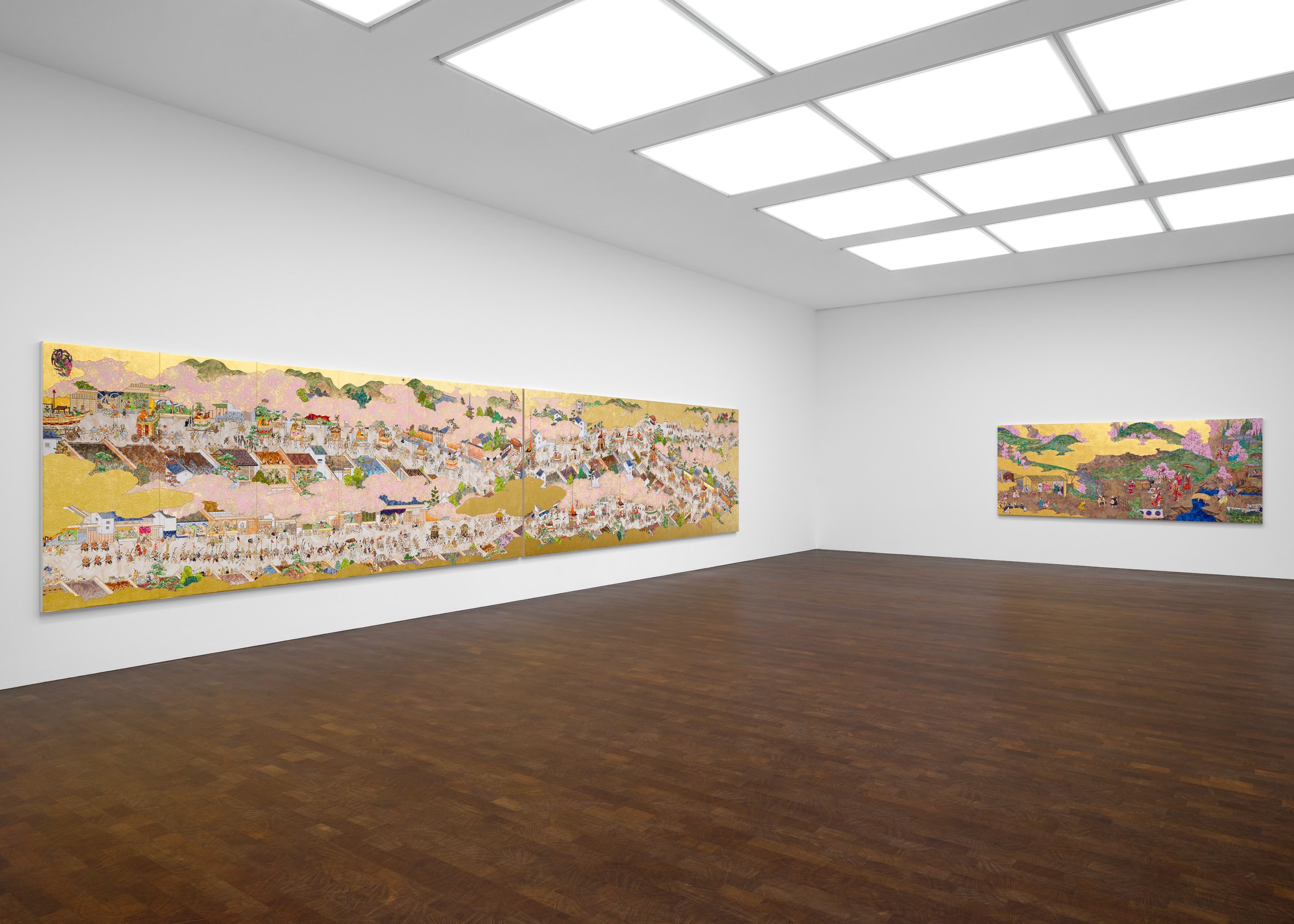
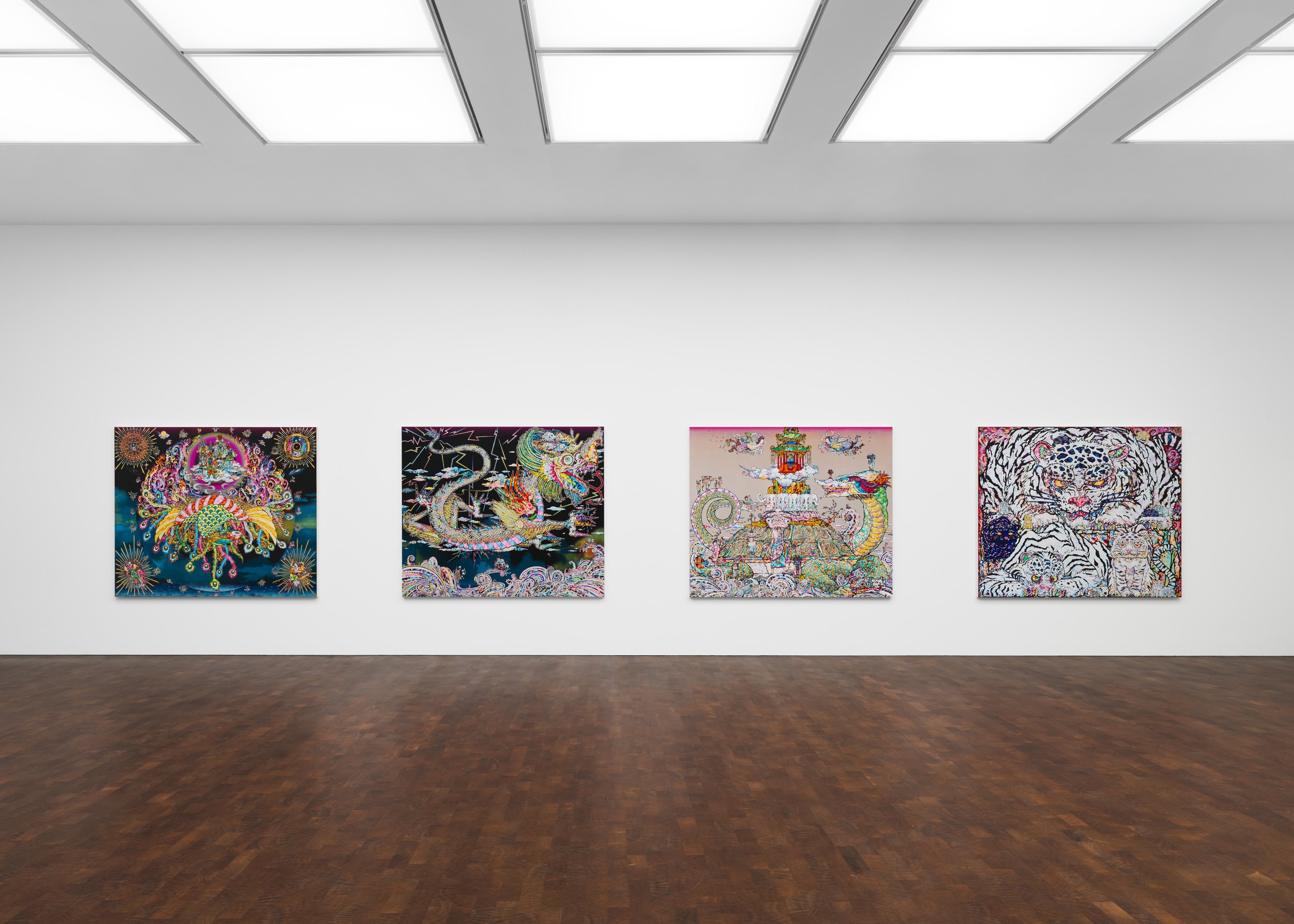
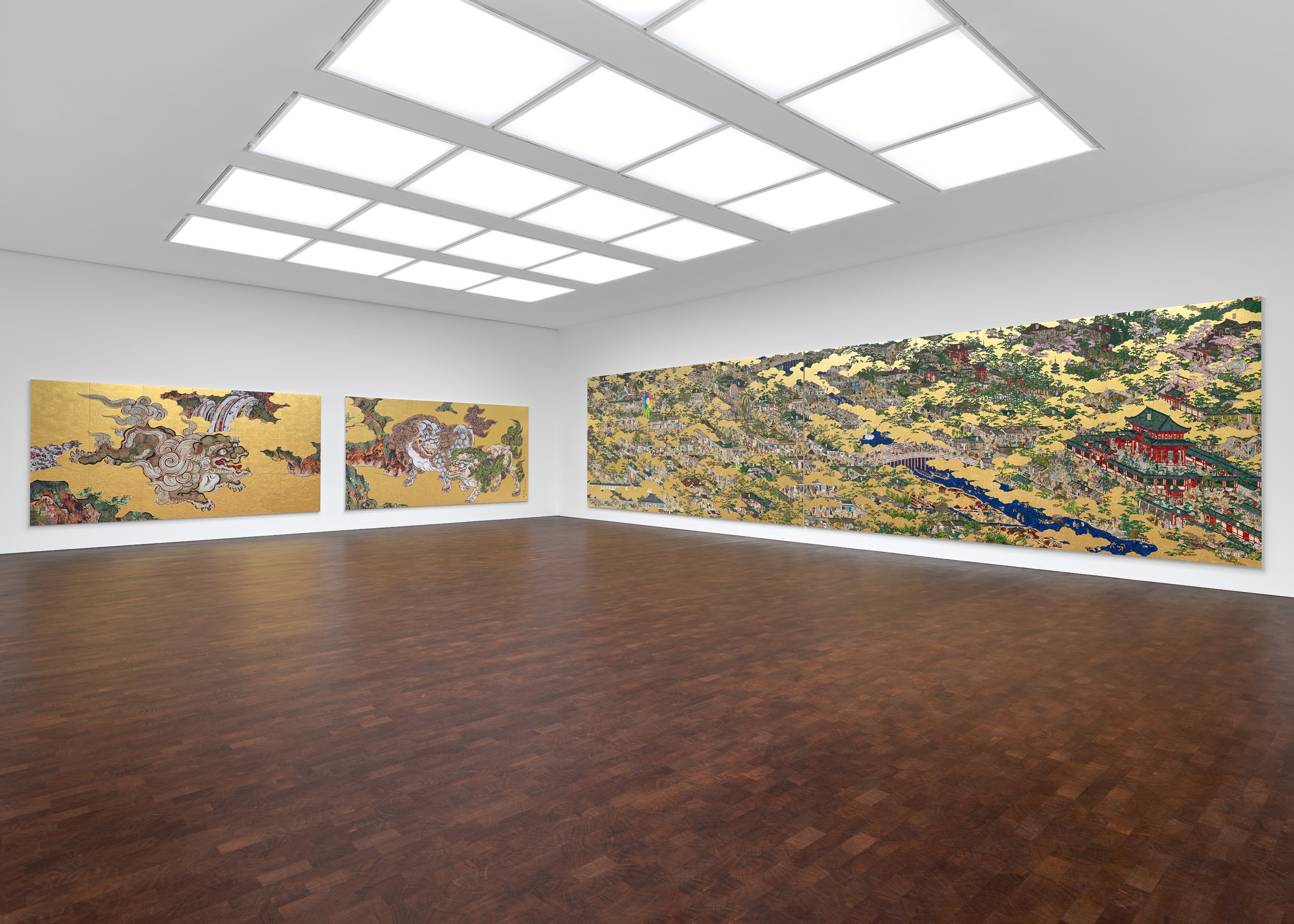
Takashi Murakami: Japanese Art History à la Takashi Murakami, 2024–2025 installation view Artwork © 2024 Takashi Murakami/Kaikai Kiki Co., Ltd. All Rights Reserved Photo: Prudence Cuming Associates Ltd Courtesy Gagosian
LONDON,—Gagosian is pleased to announce Japanese Art History à la Takashi Murakami, an exhibition of new paintings by Murakami at its Grosvenor Hill gallery in London. In this presentation, the artist pursues his fascination with the narrative of Japanese art by offering his own interpretations of historical paintings. By “Murakamizing” these iconic images, he ponders the erosion of the nation’s ancient splendor; he also considers the ways in which it has been impacted by new aesthetics and values associated with its opening to the West after the end of the Edo period (1603–1868)
Takashi Murakami White Tiger and Family, 2024 Acrylic on canvas mounted on aluminum frame 70 7/8 x 84 5/16 inches (180 x 214.1 cm) © 2024 Takashi Murakami/Kaikai Kiki Co., Ltd. All Rights Reserved. Photo: Kei Okano Courtesy Gagosian
Rakuchu¯-Rakugai-zu Byo¯bu: Iwasa Matabei RIP (2023–24) is modeled on Iwasa Matabei’s Rakuchu¯- Rakugai-zu Byo¯bu (Scenes in and around Kyoto) (Funaki Version) from the collection of the Tokyo National Museum. The original seventeenth-century work depicts the city in extraordinary detail across two six-panel folding screens. Murakami’s version, which was commissioned for his exhibition Mononoke Kyoto at the Kyoto City Kyocera Museum of Art, populates its gold-leaf clouds with skulls, a memento mori inspired by a visit to the Toribeno burial ground. He also integrates examples of his own iconography including smiling flower-faced figures and his familiar Mr. DOB character.
Takashi Murakami Black Tortoise and Arhats, 2024 Acrylic on canvas mounted on aluminum frame 70 7/8 x 84 5/16 inches (180 x 214.1 cm) © 2024 Takashi Murakami/Kaikai Kiki Co., Ltd. All Rights Reserved. Photo: Kei Okano Courtesy Gagosian
Murakami’s paintings of the Four Symbols, mythical guardians of Kyoto, pair each of their subjects with metropolitan locations aligned with the four compass directions: the Black Tortoise is associated with Mount Funaoka and Mount Kitayama in the north of the city; the Blue Dragon with the Kamo River in the east; the Vermillion Bird with Ogura Pond in the south; and the White Tiger with the San’indo Highway in the west. To arrive at these juxtapositions, Murakami combined his own sketches with AI-generated images and fragments of his earlier works in a process that parallels the inventiveness of earlier artists in depicting unfamiliar or imaginary creatures. Another diptych pictures the gods of wind and thunder in the blend of classical Japanese painting techniques with Pop, anime, and otaku graphics that Murakami terms “Superflat.” This paired depiction employs the same motifs and composition that Tawaraya So ˉtatsu (c. 1570–c. 1640), Ogata Ko ˉrin (1658–1716), and Sakai Ho ˉitsu (1761–1828) each revisited roughly a century apart. At the same time, it allows viewers to observe the development of the Kyoto-based Rinpa school. In the premodern artists’ paintings, the subjects are depicted as Buddhist deities or attendants; today, they sometimes even appear on commercial packaging in the form of cartoonlike icons, a transformation reflected in Murakami’s treatment.
Takashi Murakami Rakuchū-Rakugai-zu Byōbu: Iwasa Matabei RIP, 2023–24 (detail) Acrylic and gold leaf on canvas mounted on wood panel, in 2 parts Overall: 9 feet 10 ⅛ inches × 42 feet 10 ⅞ inches (3 × 13.1 m) © 2023-2024 Takashi Murakami/Kaikai Kiki Co., Ltd. All Rights Reserved Photo: Joshua White Courtesy Gagosian
Among the other works in the exhibition are figure and flower paintings, including a tondo. In one, Murakami reworks a set of Daigo Hanami-zu screens from the collection of the National Museum of Japanese History in Sakura that depicts a cherry blossom viewing event on the grounds of Kyoto’s Daigoji Temple; in another, he reinterprets a pair of Kiku-zu screens by Ko ˉrin that portray chrysanthemums in white, green, black, and gold. A version of an additional screen by the same artist features bunches of hollyhocks in red, pink, and white, while a work inspired by a screen from the collection of the Artizon Museum, Tokyo, reproduces a composition of hollyhocks and peacocks. The\ tondo features aqueous patterns, or “Ko ˉrin Water,” and repeating chrysanthemums, motifs developed by Ko ˉrin that sometimes also appear on kimono fabric. In this bridging of art and fashion, Ko ˉrin, who was the son of a kimono merchant, could be considered Murakami’s creative forerunner.
Takashi Murakami Golden Pavilion, 2024 Acrylic on canvas mounted on wood panel 32 3/8 x 26 inches (82.2 x 66.1 cm) © 2024 Takashi Murakami/Kaikai Kiki Co., Ltd. All Rights Reserved Photo: Kei Okano Courtesy Gagosian
A limited number of copies of Takashi Murakami: An Arrow through History, a new catalogue documenting the 2022 exhibition of the same title at Gagosian New York, which comes with a trading card designed by the artist, will be available at the gallery.
Also opening on December 10, and on view concurrently with the exhibition, Murakami is taking over Gagosian Burlington Arcade. Four new paintings featuring the artist’s smiling flowers are on view in the gallery, while the Shop offers prints and merchandise.
Takashi Murakami Re: "Daigo-Hanami-zu-Byōbu", 2024 Acrylic and gold leaf on canvas mounted on wood panel 59 1/8 x 142 inches (150 x 360.5 cm) © 2024 Takashi Murakami/Kaikai Kiki Co., Ltd. All Rights Reserved Photo: Kei Okano Courtesy Gagosian
The artist was in conversation with Hans Ulrich Obrist at 4pm on Wednesday, December 11, at the Benjamin West Lecture Theatre at the Royal Academy of Arts, London. The pair discussed Murakami’s interpretation of ancient Japanese art, including his reworking of Matabei’s Rakuchu¯- Rakugai-zu and the Rinpa school.
Takashi Murakami was born in Tokyo, where he lives and works. Collections include the Museum of Modern Art, New York; Museum of Fine Arts, Boston; Museum of Contemporary Art, Chicago; Museum of Contemporary Art, Los Angeles; the Broad, Los Angeles; San Francisco Museum of Modern Art; and 21st Century Museum of Contemporary Art, Kanazawa, Japan. Exhibitions include Murakami Versailles, Château de Versailles, France (2010); Murakami: The 500 Arhats, Mori Art Museum, Tokyo (2015); Murakami by Murakami, Astrup Fearnley Museet, Oslo (2017); The Deep End of the Universe, Albright-Knox Art Gallery, Buffalo, NY (2017); Under the Radiation Falls, Garage Museum of Contemporary Art, Moscow (2017); The Octopus Eats Its Own Leg, Museum of Contemporary Art, Chicago (2017, traveled to Vancouver Art Gallery, Canada, and Modern Art Museum of Fort Worth, Texas, in 2018); Murakami vs. Murakami, Tai Kwun Contemporary, Hong Kong (2019); MurakamiZombie, Busan Museum of Art, South Korea (2023); Mononoke Kyoto, Kyoto City Kyocera Museum of Art, Japan (2024); and Hiroshige’s 100 Famous Views of Edo (feat. Takashi Murakami), Brooklyn Museum, New York (2024).
#TakashiMurakami
The exhibition opened on December 10, 2024 and will be on view until March 8, 2025 There was an opening reception at the London location on Tuesday, December 10 from 6 to 8pm.
For more information about this exhibition and others presented by Gagosian please visit the gallery’s site here. The gallery can also be found on Pinterest, X, YouTube, Facebook, Instagram, and Artsy.
Loie Hollowell: Overview Effect
Installation View: Loie Hollowell: Overview Effect 1201 South La Brea Avenue, Los Angeles, CA 90019 November 9, 2024 – January 18, 2025 Photography courtesy Pace Gallery
Los Angeles – Pace is pleased to present Overview Effect, an exhibition of new paintings by Loie Hollowell, at its Los Angeles gallery. The exhibition opened on November 9, 2024, and will be on view until January 18, 2025, this will be the artist’s first solo presentation in Southern California, showcasing six of her largest works to date, each measuring eight by six feet, along with two new, intimately scaled, multi-part nipple paintings. Overview Effect follows Hollowell’s solo exhibition at the Aldrich. Contemporary Art Museum in Ridgefield, Connecticut—her first museum survey and first museum presentation on the East Coast, now on view at Virginia Commonwealth University’s Institute for Contemporary Art through March 9, 2025—and her recent show at Pace’s New York gallery, Dilation Stage.
Loie Hollowell, Overview Effect in yellow and blue with large mandorla, 2024 PAINTING oil paint, acrylic medium, and high density foam on linen over panel 96" × 72" × 4-1/2" (243.8 cm × 182.9 cm × 11.4 cm) © Loie Hollowell, courtesy Pace Gallery
Her upcoming exhibition in LA takes its title from what astronauts describe as the “overview effect”—the experience of seeing Earth from space. From that vantage point, the planet becomes a unified whole without borders or boundaries, a single system of which humanity is a tiny part.
In her new Overview Effect paintings, Hollowell gives viewers a bold first impression: searing our retinas with the force of bright color, extreme lighting, symmetry, and strong geometries that take on larger-than-life proportions. Stare for a while, and you will feel the paintings’ lasting effects as afterimages linger over your field of vision and leave a psychic mark. The limited palette in this body of work, based on primary colors and their combinations, suggests something basic and elemental floating in the cosmic soup.
Loie Hollowell, Overview Effect in blue and red with large mandorla, 2024 PAINTING oil paint, acrylic medium, and high-density foam on linen over panel 96" × 72" × 4-1/2" (243.8 cm × 182.9 cm × 11.4 cm) © Loie Hollowell, courtesy Pace Gallery
But looking longer and closer, something else happens—a tension between strict compositional order and localized mark-making, between overall tightness and areas of looseness, between mathematical precision and hand-painted, jumbled chaos. The dynamic between these contradictory aspects is complex, with stability containing instability, symmetry and geometry emerging from entropy. This rapport between the overview effect and the works’ up-close details depends on proximity. What appear from a distance as luminous orbs, celestial bodies, and blended colors shift into new focus as tangles of swirling, frenetic lines that imply hidden dimensions zip through our own frequencies and pass undetected through this field of existence.
Hollowell’s twisted, kinky mark-making captures states and sensations of heightened energy. The calligraphic looping of her lines implies a deeper relationship with writing and communication, reminding us that the primary aim of her aesthetic project is to record a subjective, bodily experience of feeling.





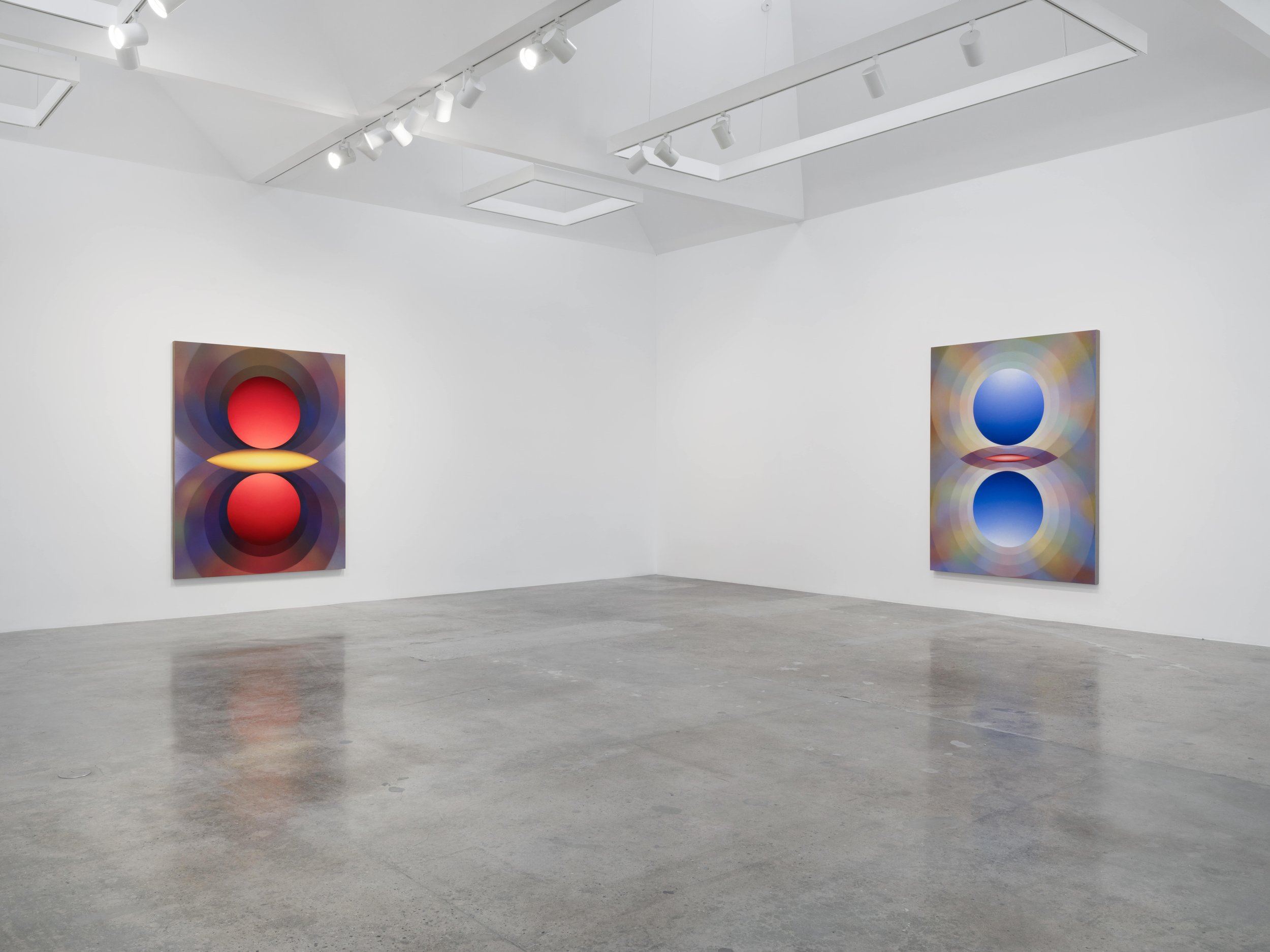
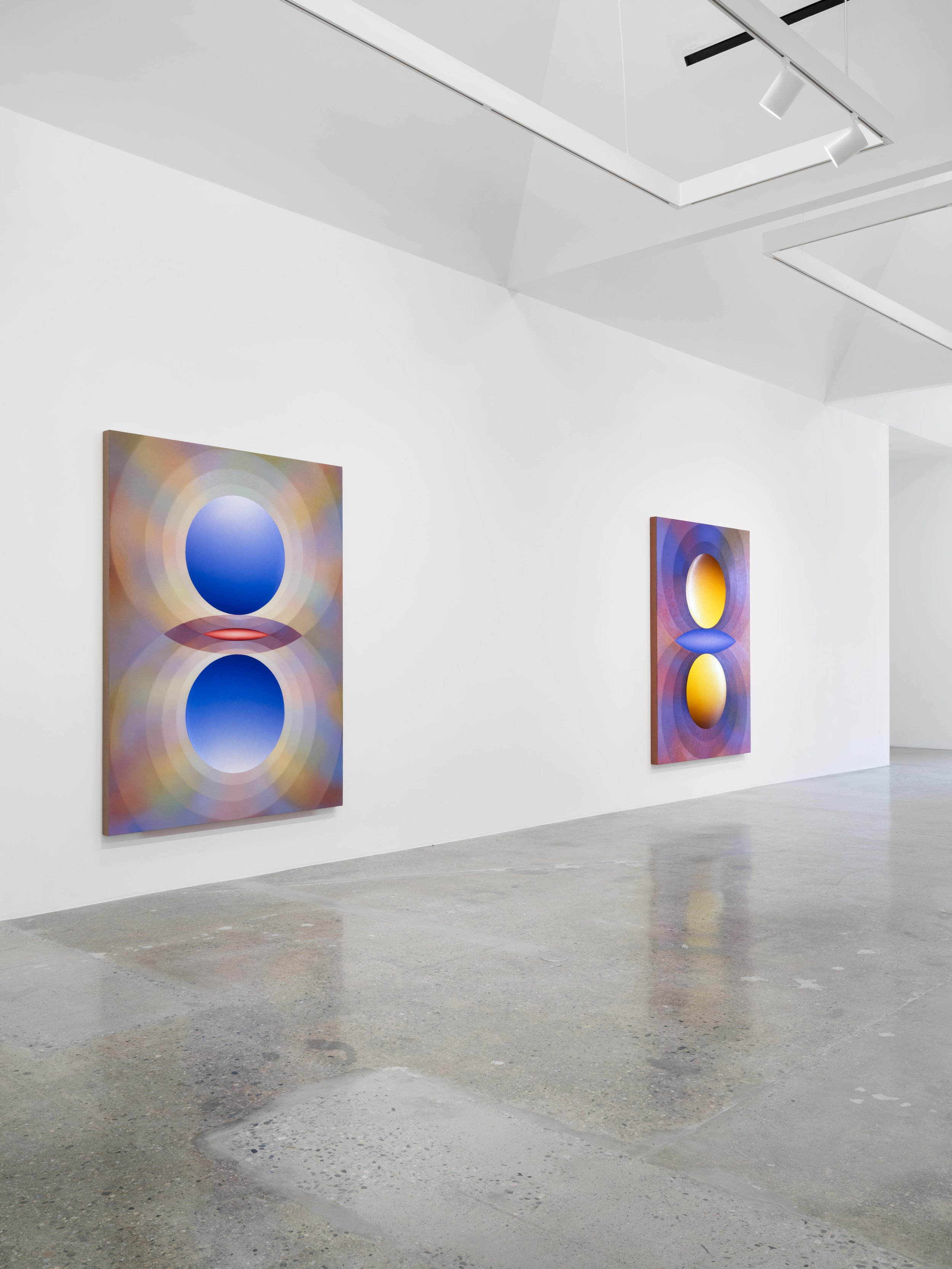
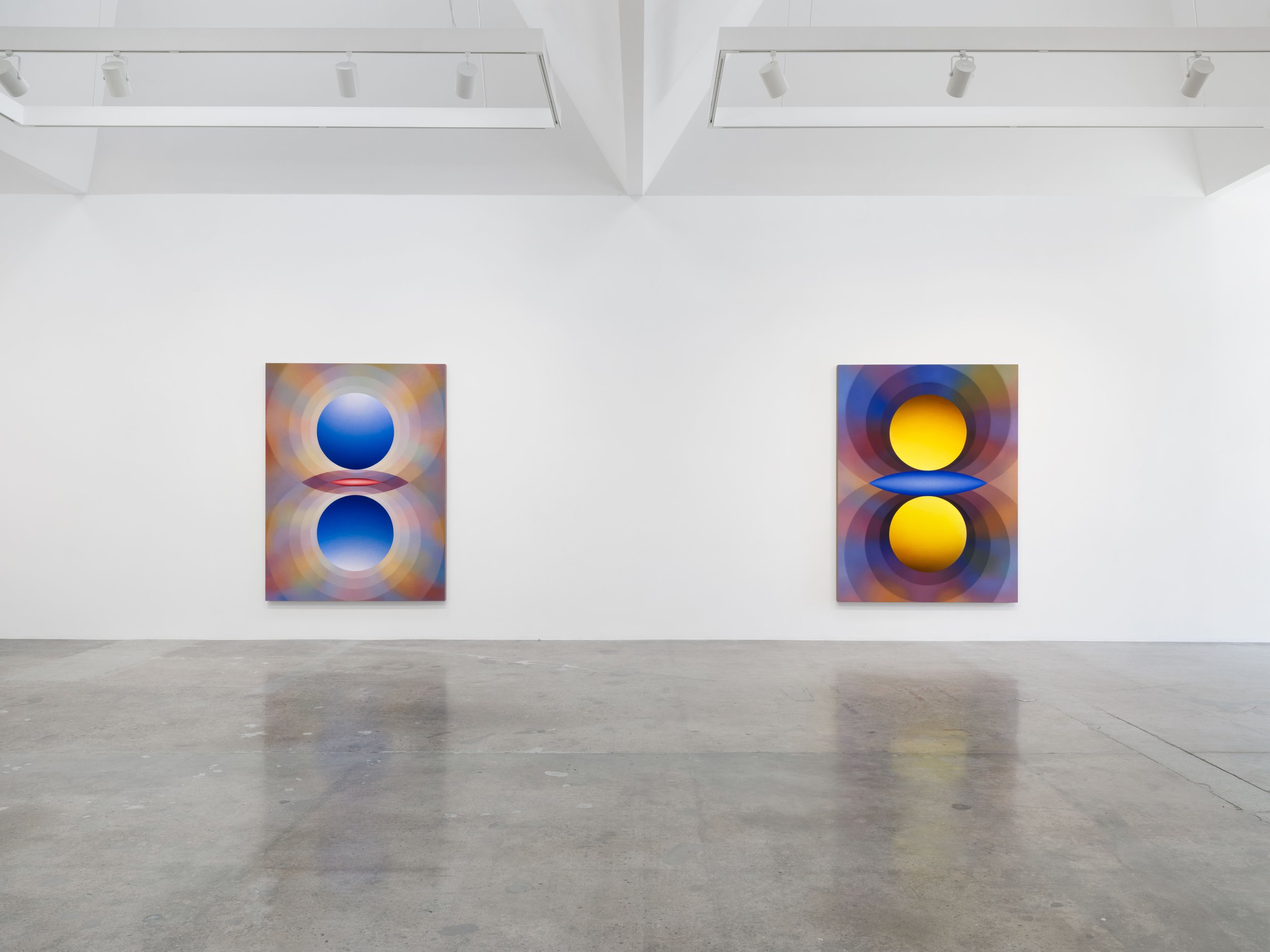









Installation View: Loie Hollowell: Overview Effect 1201 South La Brea Avenue, Los Angeles, CA 90019 November 9, 2024 – January 18, 2025 Photography courtesy Pace Gallery
The Overview Effect paintings depict two identically sized orbs stacked vertically with concentric ripples that intersect to form a horizontal mandorla. Here, Hollowell uses abstraction to capture the brief moments and breaks between contractions during childbirth, which can be a simultaneously out-of-body experience and a thoroughly visceral, embodied one. In each of these paintings, one orb bulges out while the other is a cavity—they could nest inside one another, like a hand or mouth cupped over a breast or like a child filling a pregnant mother’s belly.
In the gallery’s adjacent space, Hollowell will exhibit her rainbow suite of 16 small paintings, her smallest works to date, each spiked near the top with a protruding nipple cast from the bodies of her breastfeeding friends. Titled Spectrum XVI (an invocation of Ellsworth Kelly’s monumental Spectrum V) and spanning the full spectrum of color— from blue to green, yellow, orange, red, pink, purple, and back to blue—this multi-part work is an exercise in both smooth transitions and stark contrast. A “milking line” drops straight down from each raised nipple, sharply delineating a bright highlight on the left and a dark shadow on the right. A fold, a crease, a pleat, a peak: the nipple designates a dividing line and a kind of crucible of intense chroma. The plumb line conjures the glowing, revolving arm of a radar map while connoting the time-keeping function and cyclicality of a sundial. As in the Overview Effect paintings, Hollowell’s technical prowess produces confusing and captivating trompe-l’oeil illusions that both hyperbolize and complicate real dimensionality.
Loie Hollowell, Overview Effect in yellow and blue with small mandorla, 2024 PAINTING oil paint, acrylic medium, and over high-density foam on linen over panel 96" × 72" × 4-1/2" (243.8 cm × 182.9 cm × 11.4 cm) © Loie Hollowell, courtesy Pace Gallery
The juxtaposition of these groups of paintings in Hollowell’s presentation in LA underscores her interest in shifting scales, from the micro to the macro and back again, from deep within oneself to far beyond it.
Loie Hollowell (b. 1983, raised in Woodland, California) is recognized for her paintings that evoke bodily landscapes, using geometric shapes to move a figure or its actions into abstraction. Her work explores themes of sexuality, often through allusions to the human form with an emphasis on women’s bodies. An investigation of autobiography became evident in Hollowell’s early work, which explored the use of gradient staining techniques on cotton supports as a metaphor for intimate spaces—meditations on sleep and bodily fluids. These canvases evolved into figurative painting, introducing female nudes as subject matter as well as the use of reflection and mirroring. Her subsequent work exhibited a shift toward abstraction, characterized by radiating silhouettes and a pulsating color palette. With its strong colors, varied textures, and geometrical symmetry, Hollowell’s practice is situated in lineage with the work of the Transcendental Painting Group (1938–1941), Georgia O’Keeffe, Gulam Rasool Santosh, and Judy Chicago.
Hollowell has been the subject of numerous solo exhibitions including, One opening leads to another, GRIMM Keizersgracht, Amsterdam (2019–2020); Recalibrate, Long Museum West Bund, Shanghai (2021); Sacred Contract, Konig Galerie, Berlin (2021); Drawings as Urtext, The Anderson at Virginia Commonwealth University School of the Arts, Richmond (2023). The artist’s first museum survey, Space Between, A Survey of Ten Years, is currently on view at The Aldrich Contemporary Art Museum, Ridgefield, Connecticut. Her work has been included in over twenty group exhibitions including,10 Years Too Late, held at the Institut für Alles Mögliche, Berlin (2013); Mirror, Mirror, at the RISD Museum, Rhode Island School of Design, Providence (2015); PaintersNYC, which opened at Páramo in Guadalajara, Mexico and traveled to El Museo de los Pintores Oaxaqueños, Oaxaca, Mexico (2015). Hollowell was featured in After Effect, held at Ballroom Marfa, Texas (2016), and her work was included in Georgia O’Keeffe and Contemporary Art, which opened in May 2018 at Crystal Bridges Museum of American Art, Bentonville, Arkansas, and traveled to the New Britain Museum of American Art, Connecticut, in 2019. Recently, her work has been included in Artists Inspired by Music: Interscope Reimagined, Los Angeles County Museum of Art (2022); Put It This Way: (RE)Visions of the Hirshhorn Collection, Hirshhorn Museum and Sculpture Garden, Smithsonian Institution, Washington, D.C. (2022–2023); Being in the World, Long Museum, Shanghai (2023); and x PINK 101, X Museum, Beijing.
This exhibition opened on November 9, 2024, and will be on view until January 18, 2025, at Pace Gallery, 1201 South La Brea Avenue, Los Angeles. For more information about this exhibition and others, please visit the Pace Gallery’s website here. Pace Gallery can be found on Instagram and Artsy, too. The magazine highlights the book of the same title, which can be found here.
Pam Evelyn: Frame of Mind


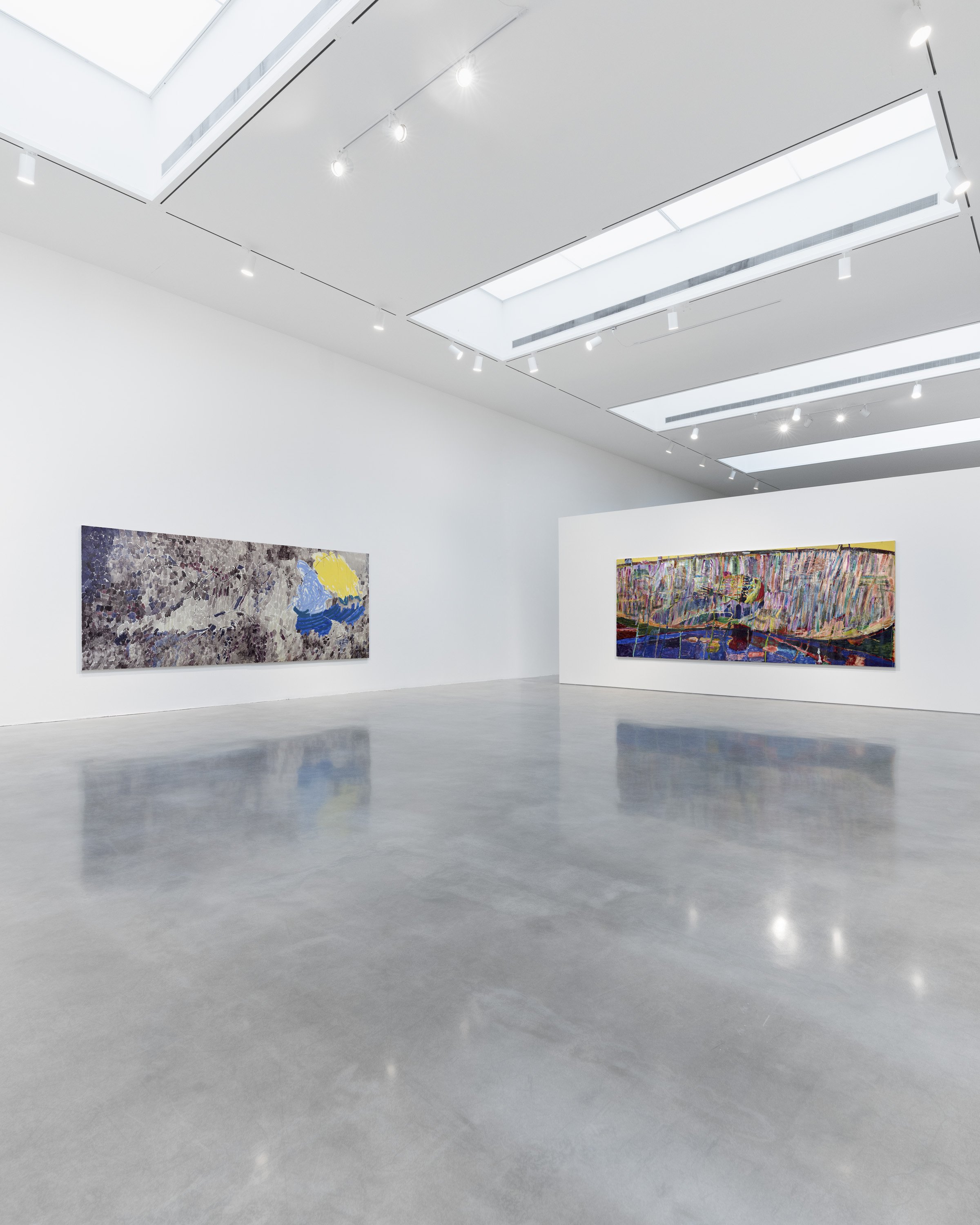

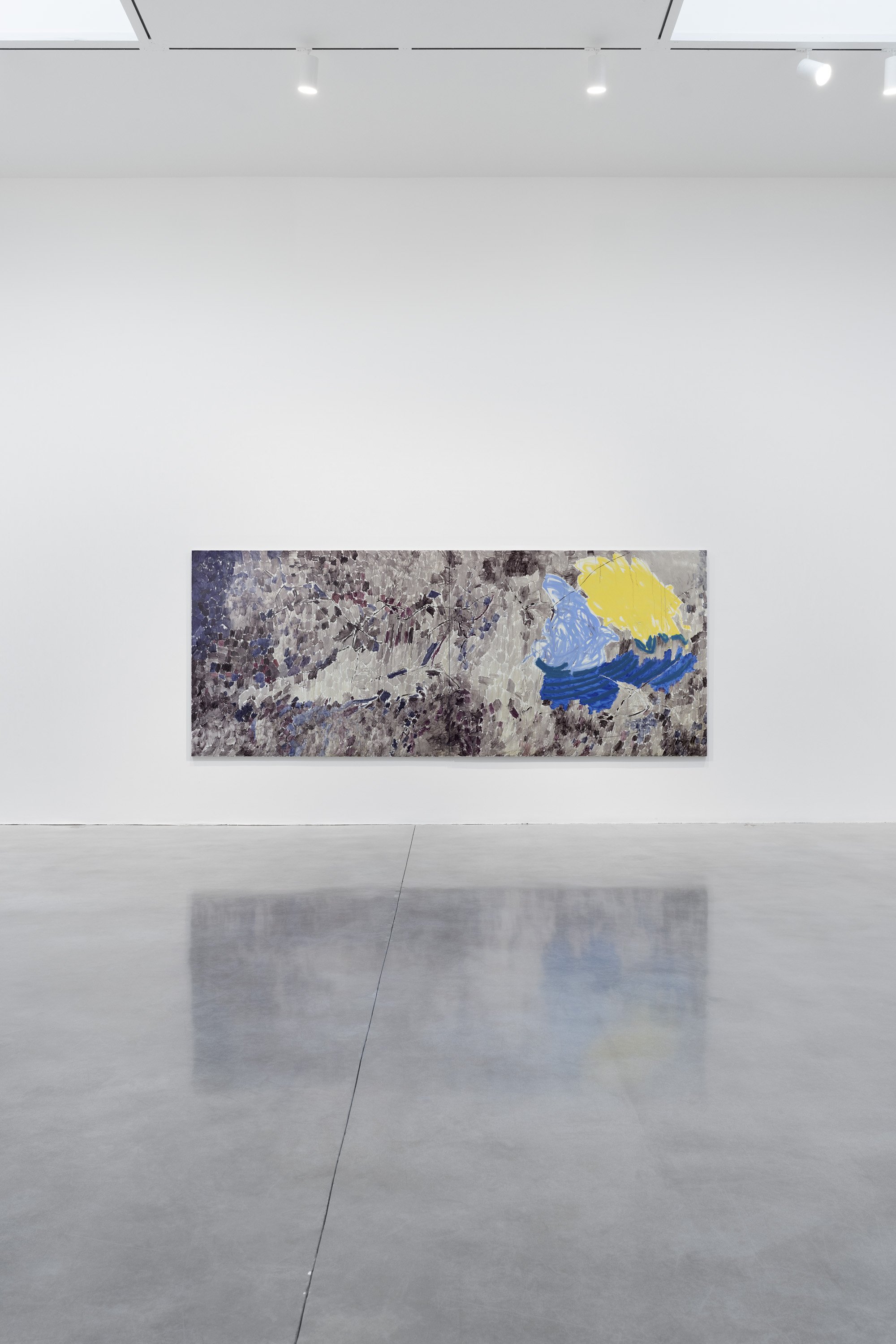

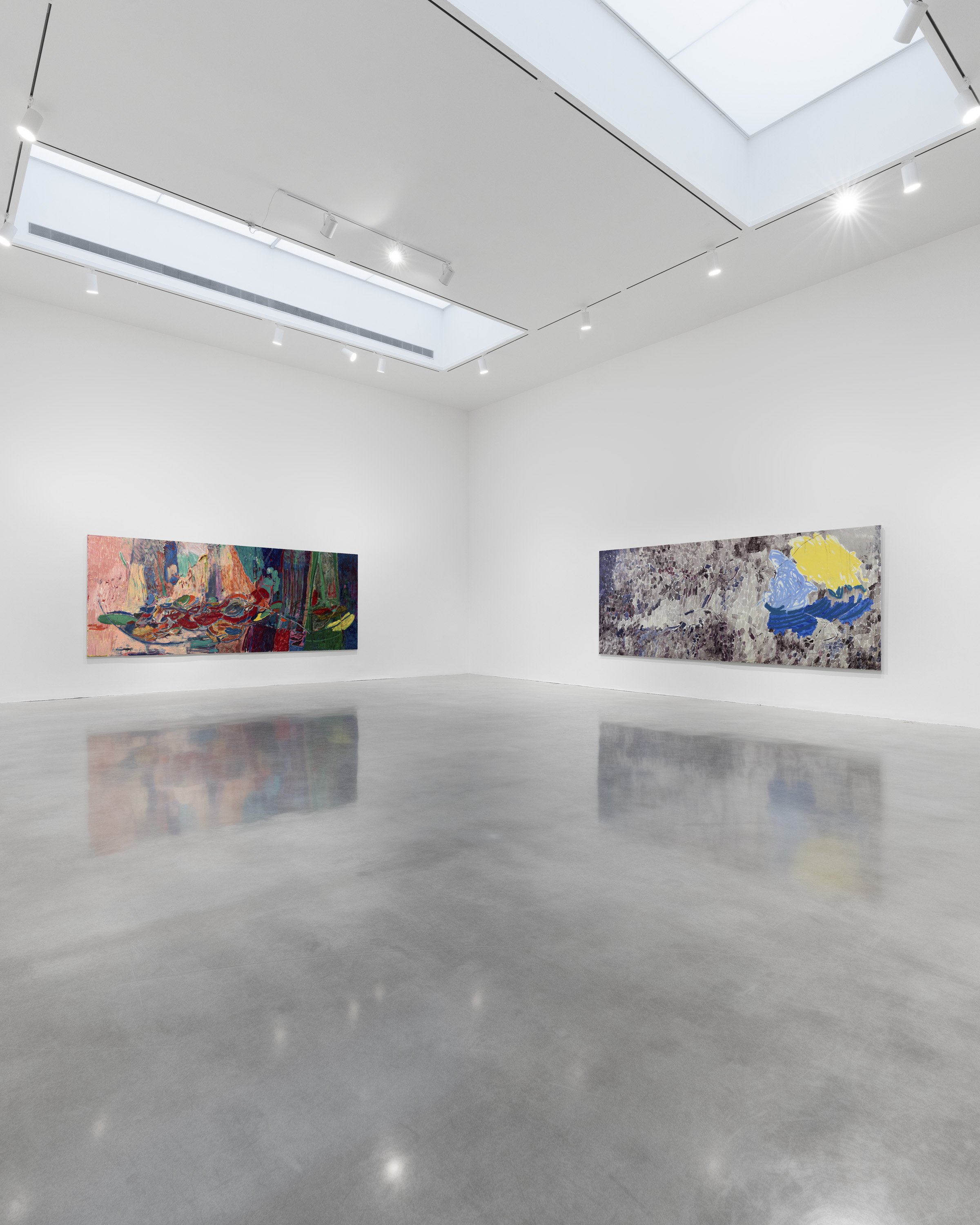



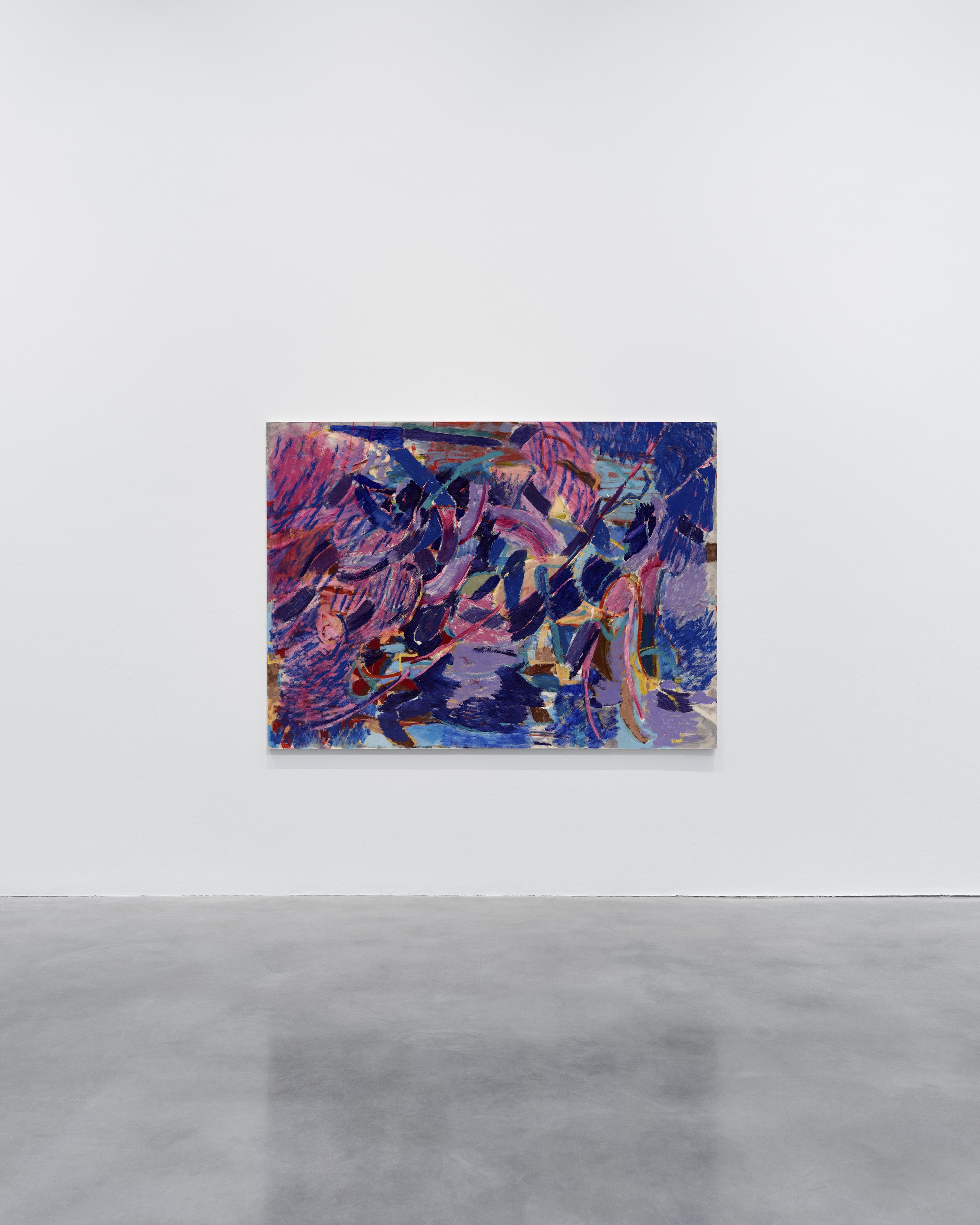
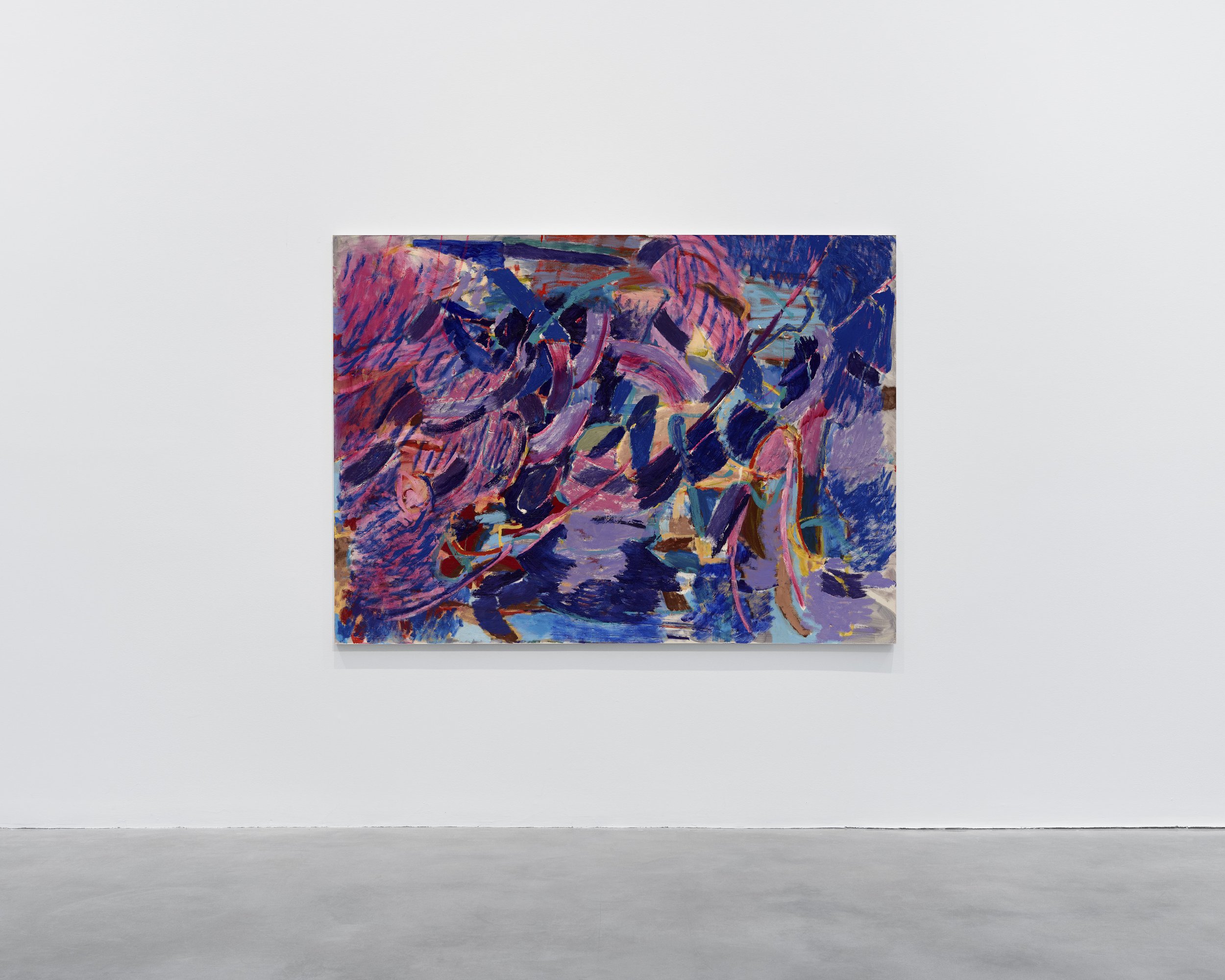




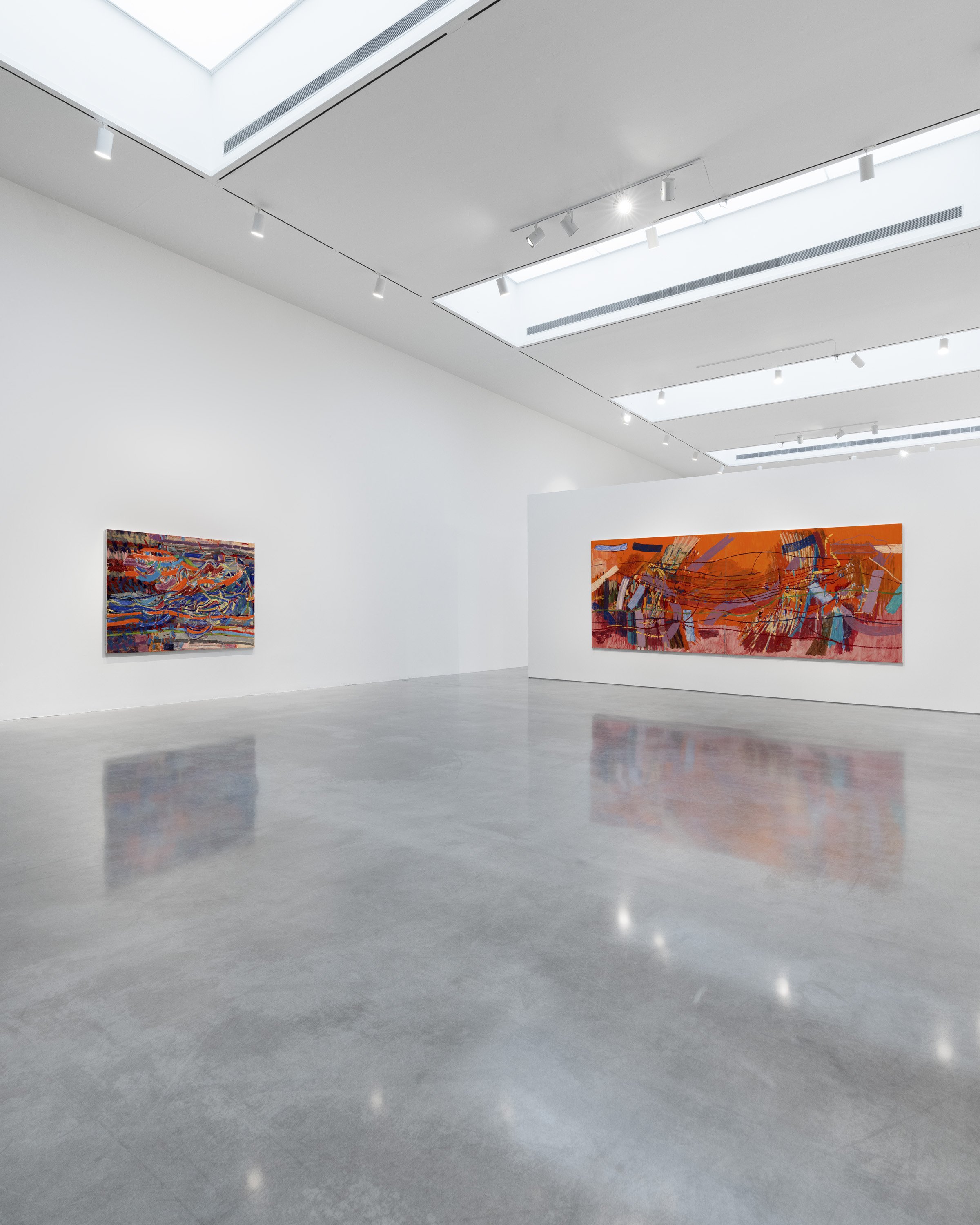

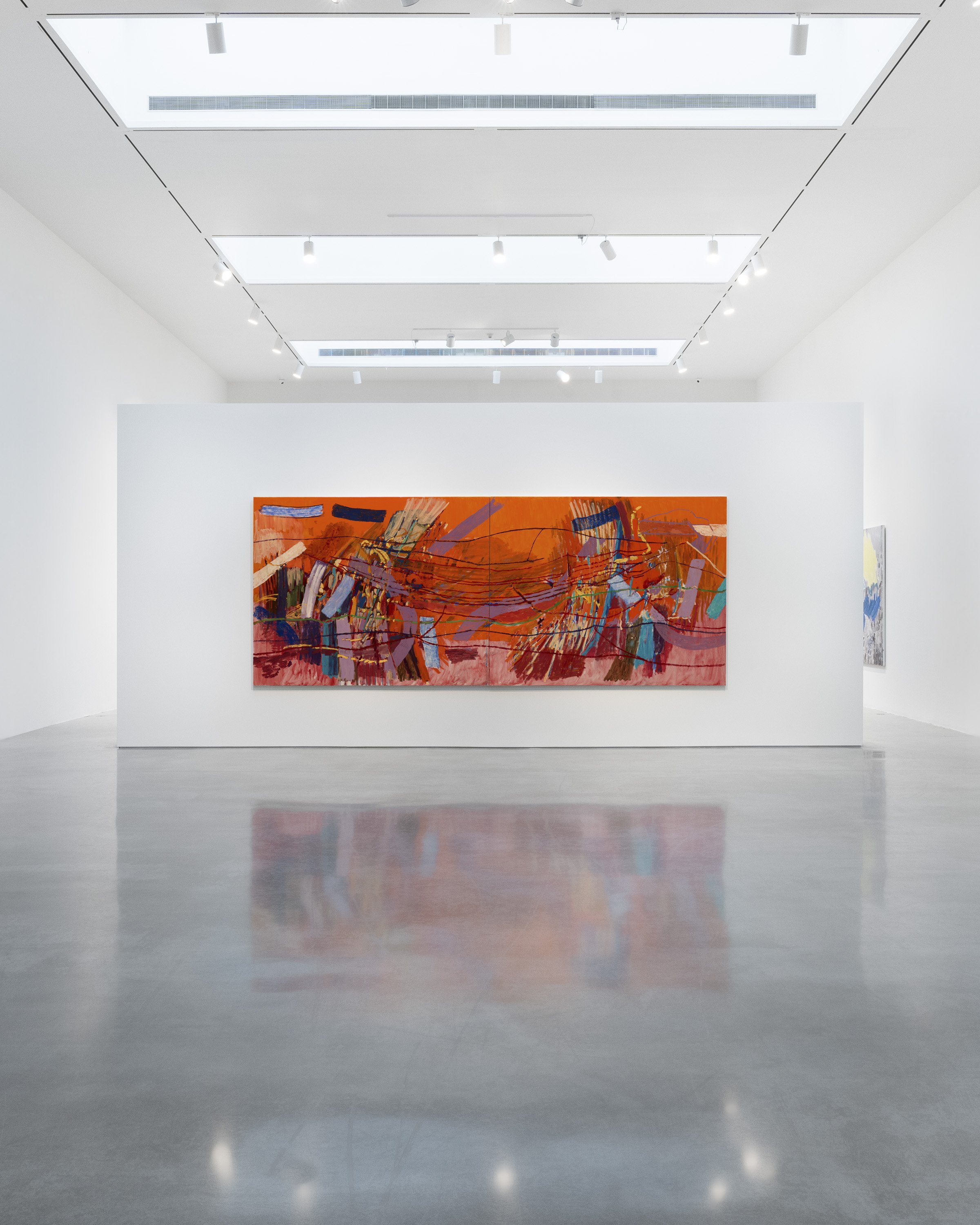


Installation View: Pam Evelyn: Frame of Mind 510 West 25th Street, New York, NY 10001 November 8 – December 21, 2024 Photography courtesy Pace Gallery
New York – Pace is pleased to present an exhibition of new, large-scale paintings by Pam Evelyn at its 510 West 25thStreet gallery in New York. The exhibition opened on November 8th and will run to December 21, the show, titled Frame of Mind, will spotlight works created by the artist during her recent residency in Cornwall, England. Marking Evelyn’s first-ever solo exhibition in the United States, this presentation will be accompanied by a new catalog from Pace Publishing, featuring an essay by art historian and curator Yuval Etgar.
Pam Evelyn, Bacchus, 2024 PAINTING oil on linen 160 cm × 220 cm (63" × 86- 5/8") © Pam Evelyn, courtesy Pace Gallery
Evelyn, who lives and works in London, is known for her expansive, abstract canvases that are densely layered, richly textured meditations on nature, the body, and materiality. Through her intuitive approach, the artist brings her complex compositions to life. Working in an array of scales and multi-panel formats, she imbues her paintings with emotional and psychological resonances, creating works that reflect the landscapes and textures of her inner world. She joined Pace’s program in 2023, and her works can be found in the collections of the Zabludowicz Collection in the English capital and the Fondazione Sandretto Re Rebaudengo in Turin, Italy.
Pam Evelyn, Curtain for Parade, 2024 PAINTING oil on linen 200 cm × 500 16' 4-7/8"), overall 200 cm × each panel cm (78-3/4" × 250 cm (78-3/4" × 8' 2-7/16"), © Pam Evelyn, courtesy Pace Gallery
In Frame of Mind, Evelyn’s first solo show in New York, she will present nine paintings—including four monumental diptychs measuring some 16 feet wide—that she made this year in Cornwall. Physically removed from London’s frenetic energy, she spent several months completely alone with her work in an intense but also meditative state of focus. For Evelyn, time seemed to slow down during this period of isolation, and the paintings she produced simultaneously over the last year are fundamentally linked while entirely idiosyncratic. She built up these works as part of a rigorous physical process of layering and scraping paint and rearticulating forms, approaching each painting as a malleable, living being with no preordained contents or conclusion.
Pam Evelyn, Bigger Picture, 2024 PAINTING oil on linen 130 cm × 200 cm (51-3/16" × 78-3/4"), overall 130 cm × 100 cm (51-3/16" × 39-3/8"), © each panel Pam Evelyn, courtesy Pace Gallery
Moving fluidly between the elemental, the emotional, and the material in making these new paintings, Evelyn has made her most psychologically involved body of work yet. Rather than drawing direct inspiration from the Cornish landscape in which she was living, the artist used her natural surroundings to think through her work in the studio. Her resulting paintings, as her upcoming exhibition’s title suggests, are more “mindscapes” than landscapes, reflections of her own state of being.
Pam Evelyn, Habit Pattern, 2024 PAINTING oil on linen 200 cm × 500 16' 4-7/8"), overall 200 cm × each panel cm (78-3/4" × 250 cm (78-3/4" × 8' 2-7/16"), © Pam Evelyn, courtesy Pace Gallery
Evelyn’s deep and nuanced engagement with art history is also evident in the paintings she will show in New York. In particular, the works of El Greco and Milton Avery were on her mind, especially as she worked to translate fleeting moments in the natural world into her compositions in a conceptual way, using the surrounding Cornish landscape as a space to pose questions about how painting is made.
Pam Evelyn, Mourning Greys (detail), 2024 PAINTING oil on linen 200 cm × 500 16' 4-7/8"), overall 200 cm × each panel cm (78-3/4" × 250 cm (78-3/4" × 8' 2-7/16"), © Pam Evelyn, courtesy Pace Gallery
Pam Evelyn (b. 1996, Surrey, United Kingdom) is a painter living and working in London. Her expansive, abstract canvases are densely layered, richly textured meditations on nature, the body, and materiality. Evelyn’s intuitive approach to painting translates her lived experience in the world onto the canvas, creating complex and vivacious compositions that brim with life. Her charged use of oil paints—carefully layered, scraped, and rearticulated over several months—recalls the seething vitality of Abstract Expressionist painters while retaining a distinct and contemporary quality.
Made over long periods of time, Evelyn’s paintings move through countless iterations as she builds up and pares back her gestures in a dynamic tension between destruction and resolution, freedom and control, collapse and resurrection. The works appear like living, breathing canvases as the complexity of texture and temporality encased in the oil paint drips and sweats, obscures and reveals in turn. Indeed, Evelyn speaks of her paintings as quasi- sentient beings, positioning herself as their audience rather than creator as she allows them to dictate their direction.
Evelyn holds a BFA from the Slade School of Fine Art, London (2019) and an MA in Painting from the Royal College of Art, London (2020). She received the Cass Art Prize in 2019 and a prestigious residency at Porthmeor Studios, Cornwall in 2022. Evelyn’s work is held in the public collections of Fondazione Sandretto Re Rebaudengo, Turin, Italy and Zabludowicz Collection, London. Recent exhibitions include Pam Evelyn: Spectacle of a wreck, Peres Projects, Berlin (2021); The Reason for Painting, Mead Gallery, Warwick Arts Centre, United Kingdom (2023); Pam Evelyn: Amid Tall Waves, Massimo De Carlo Pièce Unique, Paris (2023); New British Abstraction, Centre for International Contemporary Art, Vancouver, Canada (2023); Abstraction (re)creation – 20 under 40, Le Consortium, Dijon, France (2024); and XXX, Studio Voltaire, London (2024). In 2023, Evelyn was commissioned by Whitechapel Gallery, London, to create two etchings to accompany the major exhibition, Action, Gesture, Paint Women Artists and Global Abstraction 1940-1970 (2023).
Pace is a leading international art gallery representing some of the most influential contemporary artists and estates from the past century, holding decades-long relationships with Alexander Calder, Jean Dubuffet, Barbara Hepworth, Agnes Martin, Louise Nevelson, and Mark Rothko. Pace enjoys a unique U.S. heritage spanning East and West coasts through its early support of artists central to the Abstract Expressionist and Light and Space movements.
Since its founding by Arne Glimcher in 1960, Pace has developed a distinguished legacy as an artist-first gallery that mounts seminal historical and contemporary exhibitions. Under the current leadership of CEO Marc Glimcher, Pace continues to support its artists and share their visionary work with audiences worldwide by remaining at the forefront of innovation. Now in its seventh decade, the gallery advances its mission through a robust global program— comprising exhibitions, artist projects, public installations, institutional collaborations, performances, and interdisciplinary projects. Pace has a legacy in art bookmaking and has published over five hundred titles in close collaboration with artists, with a focus on original scholarship and on introducing new voices to the art historical canon.
Today, Pace has seven locations worldwide, including European footholds in London and Geneva as well as Berlin, where the gallery established an office in 2023. Pace maintains two galleries in New York—its headquarters at 540 West 25th Street, which welcomed almost 120,000 visitors and programmed 20 shows in its first six months, and an adjacent 8,000 sq. ft. exhibition space at 510 West 25th Street. Pace’s long and pioneering history in California includes a gallery in Palo Alto, which was open from 2016 to 2022. Pace’s engagement with Silicon Valley’s technology industry has had a lasting impact on the gallery at a global level, accelerating its initiatives connecting art and technology as well as its work with experiential artists. Pace consolidated its West Coast activity through its flagship in Los Angeles, which opened in 2022. Pace was one of the first international galleries to establish outposts in Asia, where it operates permanent gallery spaces in Hong Kong and Seoul, along with an office and viewing room in Beijing. In spring 2024, Pace will open its first gallery space in Japan in Tokyo’s new Azabudai Hills development.
This exhibition opened on November 8th and will be on view until December 21, 2024, at Pace Gallery 510 West 25th Street in New York. For more information about this exhibition and others, please visit the Pace Gallery’s website here. Pace Gallery can be found on Instagram and Artsy, too. The magazine highlights the book of the same title, which can be found here.































